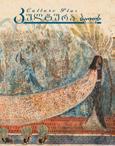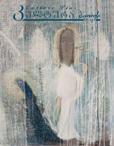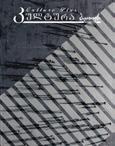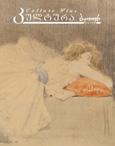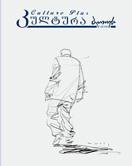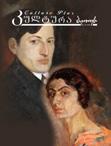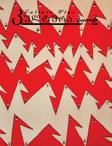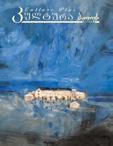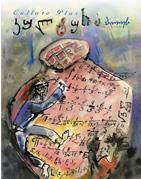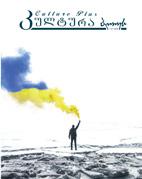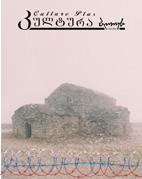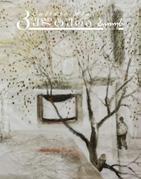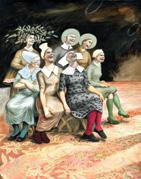
saganmanaTleblo-sazogadoebrivi Jurnali


saganmanaTleblo-sazogadoebrivi Jurnali
baCana bregvaZis `bolo drois Canawerebi~ mogonebaTa fragmentebiTurT feris „gurmani“
inkluziuri Teatri vaJa azaraSvili - „is, aq aris!“
daviT da nodar andRulaZeebi evropuli identobis Ziebis erT-erTi gza...
uxilavi speqtakli `deda moukdes, vin mouxarSavs
Sav-TeTri samyaros mravali feri
varlam maxarobliZis saxelobis ...isev kasteli
saredaqcio jgufi
revaz iukuriZe xaTuna kereseliZe ekaterine CulaSvili aleqsandre ServaSiZe mariam gabedava
dizaineri nikoloz bagrationi
BACHANA BREGVADZE’S “LATEST NOTES” WITH FRAGMENTS OF RECOLLECTIONS
COLOR GOURMET
INCLUSIVE THEATER
VAZHA AZARASHVILI “HE’S OUT THERE”
DAVID AND NODAR ANDGULADZE A WAY TO LOOK FOR EUROPEAN IDENTITY
THE INVISIBLE SHOW qalaqSi xinkalsa?~
THE MANY COLORS OF THE BLACK AND WHITE WORLD cageris istoriuli muzeumi ...CASTELLI AGAIN
EDITORIAL STAFF
REVAZ IUKURIDZE
KHATUNA KERESELIDZE
EKATERINE CHULASHVILI
ALEKSANDRE SHERVASHIDZE
MARIAM GABEDAVA
DESIGNER
NIKOLOZ BAGRATIONI
el-fosta: kulturaplusm@gmail.com facebook.com/kulturaplusm
beWdva: favoriti stili / Print: Favorite style
gamodis kvartalSi erTxel
JurnalSi ganTavsebuli masalis gamoyeneba SeiZleba mxolod redaqciis TanxmobiT
Issued quarterly
The materials published in this magazine cannot be used without the authorization of the editorial staff
garekanze: gia xuciSvili _ „tye. Semodgoma“ 2004 w. muyao, zeTi 33X30
Cover: Gia Khutsishvili – "Forest. Autumn"; 2004 oil on cardboard 33X30
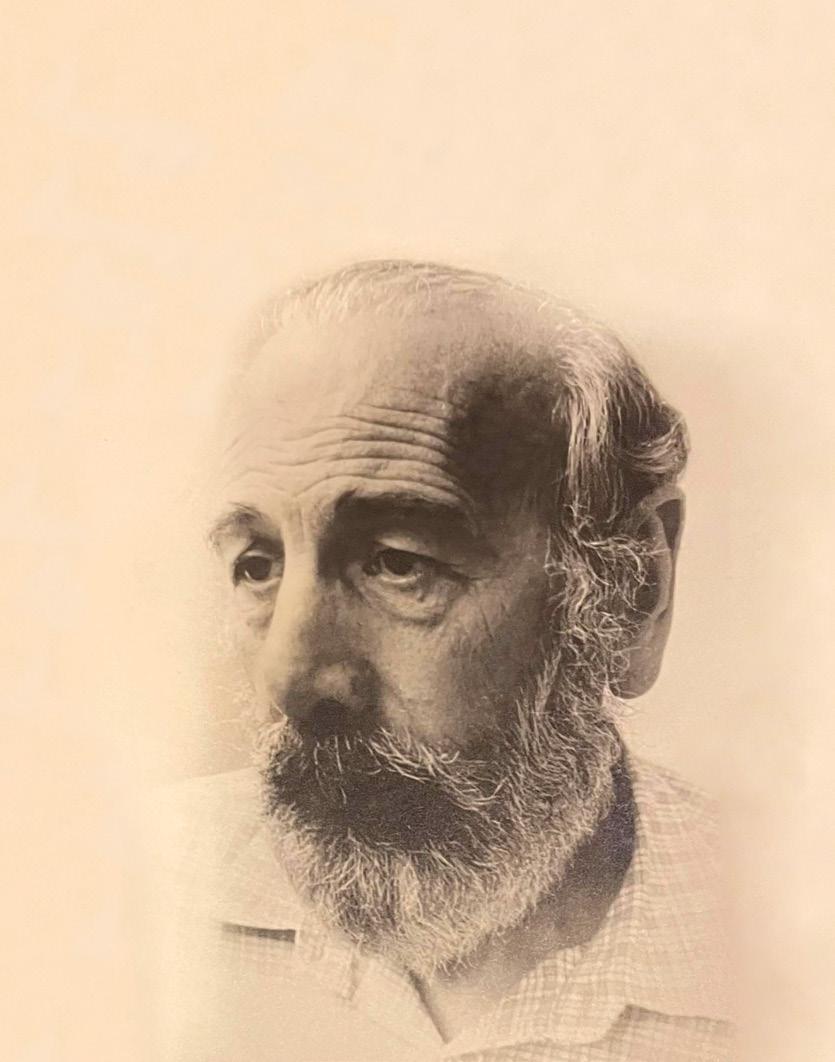
baCana bregvaZis `bolo drois Canawerebi~ mogonebaTa fragmentebiTurT
NOTES” WITH FRAGMENTS OF RECOLLECTIONS
baCana bregvaZeze, Tumca Tsu-Si erT dros vswavlobdiT (Cemze ori kursiT win iyo), mxolod is vicodi, rom inteleqtualad moixseniebdnen.
aspiranturis damTavrebis Semdeg bedma gamiRima da, Tanac rogor! 1966 wlis martidan anu qarTuli enciklopediis daarsebidanve enis, literaturisa da xelovnebis redaqciaSi aRmovCndi. mweralma, mecnierma da mTargmnelma rezi TvaraZem, ganyofilebis gamgem, im wlebSi erovnuli enciklopediis gamocema Rirsebis saqmed miiCnia da es enTuziazmi sxvebsac gadasdo (maSin БCЭ-s anu `didi sabWoTa enciklopediis~ amarad viyaviT).
man ZiriTadad Tavisi megobrebi da Tanamoazreebi miiwvia: erlom axvlediani, baCana bregvaZe, nodar ebraliZe, SoTa vadaWkoria, iago vardosaniZe, ramaz patariZe, Temo jafariZe da sxv. yvelaze umcross da proteqciiT miRebuls, rezim sakmaod mkacri gasaubreba-gamocda-dakiTxva momiwyo da, sabednierod, uyoymanod mimiRo. is wlebi, rac maTTan erTad gavatare mweralTa saxlis sxvenze, CemTvis namdvili akademia iyo. baCanas maSin mxolod platonis `nadimis~ brwyinvale TargmaniT vicnobdi. misi debiuti fexbednieri aRmoCnda. man kolosaluri memkvidreoba dagvitova: platonis `20 dialogi~, aristoteles `poetika~, markus avreliusis `fiqrebi~, fsevdo-longines `amaRlebulisaTvis~, plotinis `eneadebi~, evripides `medea~, makiavelis `mTavari~, blez paskalis `azrebi~, servantesis `donkixoti~, montenis, Sopenhaueris, bergsonis, netari avgustines, iungis, pol valeris, xose ortega i gasetis, berdiaevis, laroSfukos, leopardis, egziuperis, pirandelos, rozanovis, ibsenis Txzulebani da mravali sxva.
misi Targmanebi qarTuli mTargmnelobiTi literaturis oqros fondis kuTvnilebaa. ZvelberZnulisa da laTinuris Cinebulma mcodnem, TviTon Seiswavla ramdenime ucxo ena. karieraze arasodes uzrunvia: 1995 da 1996 wlebSi, zedmeti formalobebis gareSe, Rirsebisamebr mianiWes jer kandidatis (`blez paskali~), Semdeg doqtoris (`planetis naturfilosofia~) samecniero xarisxi; 1980 wels _ ivane maCablis premia, 2003 _ `saguramo~; iyo `sabas~ orgzis laureati. baCana bregvaZis uaxloesma megobarma, poetma, mTargmnelma da mecnierma Tamaz Cxenkelma (maTi erToblivi naSromia dante aligieris `axali cxovreba~, Targmani, gamocemuli calke wignad 1966 wels), sxartad da zedmiwevniTi sizustiT, zogadad ase daaxasiaTa megobris Rvawli: `gemovneba da erudicia TvalnaTliv vlindeba baCana bregvaZis gamWvirvale, cxad da rafinirebul enobriv stilSi, rac bunebrivi Sedegia saTargmni nawarmoebis azrismieri da mxatvruli intuiciuri wvdomisa. mis wignebs axlavs Rrma da rTuli
Even though we studied at the Tbilisi State University together (he was two years ahead of me), the only thing I knew about Bachana Bregvadze was that they considered him an intellectual.
After finishing my postgraduate studies, I got very, very lucky! From March of 1966, or in other words, from the foundation of the Georgian encyclopedia, I found myself in the editorial staff of the language, literature, and art section. Writer, scientist and translator Rezi Tvaradze, who was the head of our section, deemed the publication of a national encyclopedia a question of honor, and his enthusiasm was contagious (at the time, we were under the umbrella of the “Great Soviet Encyclopedia”).
He mostly invited his friends and likeminded people, including Erlom Akhvlediani, Bachana Bregvadze, Nodar Ebralidze, Shota Vadachkoria, Iago Vardosanidze, Ramaz Pataridze, Temo Japaridze.
As I was the youngest and was recommended by many, Rezi arranged a quite strict interview-examination-interrogation, and fortunately, he chose to take me on board.
To me, the years I spent with them in the attic of the Writers’ House were an actual academy.
At that time, I knew Bachana only through his translation of Plato’s ‘The Symposium’. His beginnings turned out the bearers of good luck.
He left us a colossal heritage: Plato’s ’Twenty dialogues’, Aristotle’s ‘Poetica’, Marcus Aurelius’ ‘Meditations’, Pseudo-Longinus’ ‘On the Sublime’, Plotinus’ ‘Enneads’, Euripides’ ‘Medea’, Machiavelli’s ‘The Prince’, Blaise Pascal’s ‘Pensées’, Cervantes’ ‘Don Quixote’, as well as translations of Montaigne, Schopenhauer, Bergson, Augustine of Hipp, Jung, Paul Valéry, José Ortega y Gasset, Berdyaev, François de La Rochefoucauld, Antoine de St Exupery, Rozanov, Ibsen, and many others.
His translations belong to the golden fund of literature translated in Georgian. Flawlessly knowledgeable in ancient Greek and Latin, he learned several other foreign languages by himself.
He was never thinking about his career: in 1995 and 1996, without any excess formalities, they endowed him with a candidacy (‘Blaise Pascal’) then a doctor’s (‘Natural Philosophy’) science degree; in 1980, he received the Ivane Machabeli award, and in 2003, ‘Saguramo’ received two Saba awards.
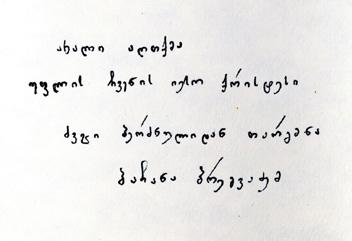

problematikis Semcveli misive winasityvaobebi da komentari~.
qarTuli enciklopediis gamocema (gamocdilebas TandaTan viRebdiT) Tavdapirvelad damuxruWda. maSin Cavwvdi baCanas muSaobis stils: roca Tavisufal dros sakmaod xmauriani musaifiT viyaviT garTulni, igi TavauReblad Targmnida an ucxour valutaze nayid iSviaT enciklopediebsa da leqsikonebs Cahkirkitebda. misive monaTxrobidan: „roca me da Tamaz Cxenkelma dantes Targmna gadavwyviteT, kikeTSi ganvmartovdiT: SuasaukuneTa qarTveli berebiviT TavauReblad vmuSaobdiT, xSirad Cvens mier gakeTebuli lobios Wamac ki gvaviwydeboda“.
1972 wels gamoica markus avreliusis „fiqrebi“, brwyinvale winasityvaobiTa da skrupulozuri SeniSvnaganmartebebiT.
swored im dros Tsu-Tan moulodnelad Semoxvdnen erTmaneTs akaki gawerelia, rezi TvaraZe, Tamaz Cxenkeli da baCana bregvaZe. batonma akakim samiveni sadilad miiwvia (universitetis pirdapir cxovrobda).
Bachana Bregvadze’s close friend, poet, translator and scientist Tamaz Chkhenkeli (they worked together on the translation of Dante Alighieri’s ‘New Life’, which was published as a separate book in 1966), characterized his friends’ accomplishments smartly and precisely: “Taste and erudition can clearly be felt in Bachana Bregvadze’s transparent, limpid, and refined linguistic style, which is a natural result of his intuitive grasp of the essence and artistic meaning of the works. His books are accompanied by his own introductions and comments, which include deep and complex problematics.
At first, the publication of the Georgian encyclopedia, as we were gradually taking in more and more experience, was slowed down. This is when I understood Bachana’s working style: while on our free time, we would speak quite loudly, he was zealously translating, or looking through the pages of a rare encyclopedia or dictionary bought in a foreign currency. As he put it himself: “When myself and Tamaz Chkhenkeli decided to translate Dante, we isolated ourselves in Kiketi; we worked diligently, like Georgian monks from the Middle Ages; we even often forgot to eat the bean dish we were preparing.”
Marcus Aurelius’ ‘thoughts’ was published in 1972, with a brilliant foreword and scrupulous remarks and comments.
This is precisely when Akaki Gatserelia, Rezi Tvaradze, Tamaz Chkhenkeli and Bachana Bregvadze met near the Tbilisi State University. Mr. Akaki invited the three others for supper (he used to live right in front of the university).
Rezi Tvaradze recounts: “The hungry guests were met with a radiant table: satsivi (dish with walnut sauce), ghomi (sort of corn porridge), and cheese. Mr. Akaki, who was, of course, the toastmaster, had beautiful discourses, mainly about the works and ideas of philosophers and writers (he had good listeners too), and he was also a great, enthusiastic host: “Help me with warm ghomi” – he would ask is wife, offer some satsivi and wine to his guests, and then, in the most natural of manners, he would utter – “As for Marcus Aurelius…”. And this would be followed by a long tirade. This kind of “ambivalence” made him particularly charming.
It was the 1980s, and Bachana visited me together with Jemal Ajiashvili one evening. I think I’ve only glanced at Jemal a few times, and each time, he seemed astonished at Bachana’s translations of ancient Hebrew poetry; I hosted my singular, extraordinary guest with much reverence. Bachana was strangely agitated and wouldn’t stop speaking. Jemal didn’t move for the whole evening, he just sat there, in awe.
It turned out to be a historic day, without any exaggeration. They were both coming from the patriarchate: his beatitude Ilia II had gathered a constellation of exceptional translators in order for them to make the “book of books”, the Bible, understandable to Georgian readers, and to the possible extent, to preserve its artistic power and archaic taste… And Bachana was very excited that day precisely because of this.
The sweet-sour, fateful 1990s arrived. Bachana had long left the encyclopedia’s editorial staff, and in the 1990s, I also transferred to the Institute of Literature. We would meet each other rarely and by
rezi TvaraZis monaTxrobi: moSiebul stumrebs sanaqebo sufra gauSales: sacivi, Romi da yveli. batoni akaki, rasakvirvelia, _ Tamada, enamzeobda, ZiriTadad, filosofosTa Tu mweralTa Txzulebebs ixseniebda (miT umetes, rom Cinebuli msmenelebi hyavda), Tanac maspinZlis movaleobasac didi siamovnebiT asrulebda: aba, cxeli Romi SemomaSveleo, _ sTxovda meuRles, Tanameinaxeebs sacivsac da Rvinosac sTavazobda da Zaldautaneblad iqve CaurTavda xolme _ „xolo, rac Seexeba markus avreliuss...~ rasac vrceli tirada mohyveboda. amgvari „ambivalenturoba~ mis pirovnebas gansakuTrebul xibls sZenda.
80-iani wlebi iyo, erTxelac baCana saRamoxans jemal ajiaSvilTan erTad mestumra. Zveli ebrauli poeziis miseuli TargmanebiT aRfrTovanebuls jemali mxolod TvalismokvriT Tu menaxa, didi pativiscemiT Sevxvdi ucxo da marTlac saucxoo stumars. baCanas, ucnaurad aJitirebuls, laparakis saRerReli hqonda aSlili. jemals mTeli saRamo krinti ar dauZravs, moridebulad ijda. Turme, gadauWarbeblad, istoriuli dRe iyo: oriveni sapatriarqodan modiodnen: uwmindessa da unetaress ilia meores Semokrebili hyavda mTargmnelTa Cinebuli Tanavarskvlavedi, raTa `wignTa wigni~ biblia Tanamedrove qarTveli mkiTxvelisTvis misawvdomi gaexada da, SeZlebisamebr, mxatvruli Zalmosileba da arqauli surnelic SeenarCunebina... im dRes ki didi iyo baCanas sixaruli, radgan saxareba-oTxTavis Targmna daesrulebina.
dadga tkbil-mware, ufro ki avbediTi 90-iani wlebi. enciklopediis redaqciidan baCana ukve didi xnis wamosuli iyo, 1990 wels mec literaturis institutSi gadavedi. iSviaTad, SemTxveviT Tu vxvdebodiT erTmaneTs, telefoniT ki xSirad vsaubrobdiT. erTxelac Zlivs gavixare: uiSviaTesi `gamonaTebis~ dros televiziam gvamcno, rom baCana bregvaZes Rirsebis ordeni mieniWa. moxda ise, rom maleve megobrebma manqaniT gamomiares. baCanas saxlis siaxloves, faliaSvilis quCaze navTis uzarmazari rigi SevniSne. vxedav, baCana, navTis bidoniT xelSi, mowyenili, morCilad dgas sadRac bolosken; veubnebi Cemebs, romlebic kargad icnoben da didad afaseben baCanas, rom dRes es adamiani Rirsebis ordeniT daajildoves. gaexardaT, magram bidoniani baCanasaTvis milocva gveuxerxula. rogoria, _ Rirsebis ordenosani navTis rigSi?! saRamos, roca mivuloce, sakmaod gulgrilad, zrdilobisaTvis gadamixada madloba, cud xasiaTze iyo Tu es jildo didad ar exateboda gulze? CemTvis dRemde ucnobia.
didi interesiT da cnobismoyvareobiT velodi 2010 wels dastambul (gam. „inteleqti“) mis „bolo drois
chance, but we talked a lot on the telephone.
For once, I was happily surprised: in a very rare “positive” moment, the TV broadast that Bachana Bregvadze had received the Order of Honor. It so happened that friends came to pick me up with a car soon after that. When we passed near Bachana’s house, on Paliashvili Street, there was an enormous line for kerosene oil. I saw Bachana with a canister in his hand, miserable, quietly standing in the end of the line; I told my friends, who know him well and respect him a lot, that this man had just received the Order of Honor. They were happy about it, but we were embarrassed to congratulate him when he had a canister in his hand. Imagine – a man with the Order of Honor waiting in a kerosene oil line?!
In the evening, when I congratulated him, he thanked me without much emotion, out of politeness. Was he in a bad mood and didn’t like the award that much? To this day, I don’t know.
I was waiting for his ‘Latest Notes’, which were printed in 2010 (publishing house ‘Intellect’), with great interest. This book was definitely written after the 2008 war.
The overwhelming majority of ‘Latest Notes’ is dedicated to the analysis of the teachings from the most ancient European or Asian cultures, as well as their re-exploration, allusions to them, or reminiscences, providing the effect of an “echo between epochs”. They broaden the readers’ perspective, and can also act as thought exercises.
The author examines our post-soviet condition in a global context too, with quite negative views; even more so because he has the knowledge of the historic fluctuations in ancient civilizations or empires. His reflections on the writings, philosophy, or history of the old world hold a significant part of ‘Latest Notes’. And putting all this together brings him to the following maxim: “History – honest wishes thrown in the garbage”.
As a whole, we see Bachana Bregvadze and his creative heritage as apologetic of the western civilization; but the technological changes and the return to the “golden idol” at the brink of the 20th-21st centuries, with the unprecedented reign of the west, made him see a world that denigrates eternal values with great skepticism:
“…The “civilized countries” of the west lend a “selfless helping hand”

Canawerebs“. ueWvelia, rom wigni 2008 wlis omis Semdegaa dawerili.
`Canawerebis~ absoluturi umravlesoba, evropisa Tu aziis uZvelesi kulturis monapovarTa analizs da maT uaxles gaazrebas, aluziebsa Tu reminiscenciebs, `epoqaTa gadaZaxils~ warmoaCens: mkiTxvels Tvalsawiers ufarTovebs da `saazrovno varjiSsac~ waagavs. postsabWoTa saxelmwifoTa beds avtori globalur konteqstSic ganixilavs, sakmaod uaryofiTi SeferilobiT; miT umetes, rom amis safuZvels uZveles civilizaciaTa Tu imperiaTa istoriuli ryevebis codnac aZlevs. refleqsiebi Zveli samyaros mwerlobaze, filosofiasa Tu istoriaze `CanawerTa~ lomis wilia. yovelive amis erTiani gaazreba ki aZlevs safuZvels sxarti `maqsimisaTvis~: `istoria _ sanagveSi Capneuli patiosani Tvlebi~.
mTeli Tavisi SemoqmedebiTi memkvidreobiT baCana bregvaZe dasavluri civilizaciis apologetad gvevlineba; magram XX-XXI saukuneTa mijnis teqnicizmisa da `oqros kerpis~ wregadasuli, arnaxuli zeobis fonze, maradiul RirebulebaTa damakninebel samyaros didi skepticizmiT aRiqvams:
`...dasavleTis `civilizebuli qveynebi~, `uangaro daxmarebis~ xels uwvdian da viTomcda moSlili ekonomikis aRsadgenad, miliardebs miliardebze ayrian `postsabWoTa sivrceSi~ mgminav, sakuTari mTavrobebis mier ganukiTxavad gayidul da, rogorc Cans, samudamo monobisaTvis ganwirul norC `saxelmwifoebs~.
...dRes iaraRiT ki ara, fuliT ipyroben da inawileben e.w. `mesame samyaros~ gamaTxovrebul qveynebs~ (`bumerangi~).
es metad qufri Canaweri minda gavaneitralo galaktionis ori taepis baCanaseuli saxaliso perifraziT: `mTavroba: „yvelaferi aris Zlier kargad~. / xalxi: `yvelaferi Zlier cudad aris~ (`galaktionis hangze~).
pirad saubarSi baCanas iSviaTad uxsenebia raWaSi, mSobliur sofel sxvavaSi gatarebuli bavSvobis wlebi. axlaRa vfiqrob, rom misma qvecnobierma `dabloka~ patara soflis gausaZlisi yofa, rac omisa da omisSemdgom siduxWires daemTxva. wignSi am Temaze mxolod erTaderTi Canaweri, faqtobrivad, mxatvrul-dokumenturi patara moTxroba aRmovaCine; ise movixible, rom TiTqmis mTlianad vTavazob mkiTxvels: `meore msoflio omi (uwin `didi samamulo omi~ erqva). sofelSi vswavlob... bavSvebi, dedabrebi, berikacebi... axalgazrdebi saomrad arian wasuli: Cveni `ufrosi Zmis~ miwa-wyals icaven.
uxvTovliani zamTari, amxela Tovli mas mere, mgoni, aRarc mosula.
yovel zamTars berikacebi sacalfexo biliks gviWrian: skolamde misasvlel gzas gvikvalaven. TovlSi aRarc ki

and send billions and billions to the “post-soviet space”, allegedly to rehabilitate their broken economies, to young “states” that have been arbitrarily sold by their governments, and, it so seems, were sacrificed for eternal serfdom.”
“…Today, it is not through weapons but through money that they invade and take shares of countries of the so-called “third world”, which have become beggars.” (‘Boomerang’)
I would like to compensate a bit for this quite grim excerpt, with two verses that are typical of Bachana’s comical periphrases: “Government: “Everything is very well”.” / “People: “Everything is very bad”.” (“On Galaktioni’s Tune”).
In private conversations, Bachana rarely mentioned the childhood years he spent in his village of Skhvava, in the Racha region. I now realize that his subconscious might have “blocked” the unbearable life at the village brought about by wartime and the period that followed. In the book, he only touches upon this subject once, and it is practically a small docu-fiction story; I was so hooked that I would like to present it almost in its entirety to our readers:
“The Second World War (earlier, it used to be called the “Great Patriotic War”). I’m studying at the village… There are children, old women, old men… Young people are gone to the war: they are defending the territories of our “big brother”.
vCanvarT, Zalianac rom gvindodes, erTmaneTs gverds ver avuqcevT.
skola karga Sorsaa. qancgamwyvet aRmarTs aivli da mere gaivakeb. aRmarTze yovel diliT ezodan Cems win gamodis oTxi da-Zma. mama omSia, deda avadaa. simaRlis mixedviT damwkrivebulni moabijeben. ukan yvelaze pataraa. daxeuli qalamnidan da gaxeuli windidan SiSveli qusli mouCans, qusli jer wiTldeba, mere lurjdeba da bolos Savdeba kidec.
skolas, ase, aTiode wuTis savalze rom mivuaxlovdebiT, Robeze unda gadavabijoT. da swored aq iwyebs tirils. ase meordeba yovel cismare dilas. me mikvirs. erTxelac veRar moviTmine da vkiTxe: raRa maincdamainc aq morTav tirils-meTqi?
guli Camwyda; ara, sicive rodi iyo amis mizezi: dedis momWirne xeliT mkacrad mozomili natexi, mxolod aqamde hyofnida, magram SimSils ki ver iklavda...~ (`1944 weli~). am droisaTvis baCana 8 wlisa Tu iqneboda.
jer kidev 1960-iani wlebis bolos, roca enciklopediis redaqciaSi muSaoba axali dawyebuli gvqonda, sabWoTa kavSiris anu rusuli komunisturi imperiis `Taviseburebebze~ sayvelpuro saubarSi baCanam ganacxada: ruseTs atomuri bombi rom aqvs, es igivea, xuTi wlis bavSvs xelSi kalaSnikovis avtomati daaWerinoo. samociode wlis winandeli es mosazreba dRes ise aqtualuria, rogorc arasdros. 2008 wlis rusuli omiT `STagonebul~ avtors didi adgili aqvs daTmobili `Cvens kurTxeul miwa-wyalze sikvdilis mTesavi bombebis cvenisaTvis~. gulistkivilis gamoxatulebaa misi gamonaTqvamic: `vankebis~ samxedro Ceqmebis braguns rusma inteligenciamac auwyo fexi~. baCana bregvaZem, berdiaevisa Tu rozanovis mTargmnelma, kargad uwyoda rusuli literaturis Zalmosileba. Cveni saerTo megobris, qarTuli andergraundis erT-erTi pioneris, Temo jafariZis monaTxrobidan: mis saxelosnos xSirad stumrobdnen rusi Tu ebraeli disidentebi. zogjer imarTeboda cxare kamaTi mwerlobasa da xelovnebaze. amgvar polemikas baCanac xSirad Seswrebia. erTxelac Temos stumars, moskovel axalgazrdas baCanam didxans usmina uCumrad, uTmina kafkas gandideba da dostoevskis damcroba, bolos ki, gagulisebulma, wamoWarxlebulma ifeTqa: „Что Кафка!
~ avtorma kargad icoda lev tolstois fasic, magram ar `SearCina~ erTi Canaweri: `Мечтал
Cauweria Tavis dRiurSi (29. V. 1852)... axalgazrda lev tolstois.
Cven ki naxevrad veluri rusi generlebis yefa gvikvirs~ (`
~).
A very snowy winter, I think more than ever after that.
Each winter, the old men create a narrow path in the snow, so we can get to school. We cannot be seen when we walk them, and even if we wanted to, the paths are so narrow that we could not walk next to each other.
The school is not close. You have to walk an exhausting uphill, and then a less steep valley. Every morning, four siblings come out of their yard before me. Their father is at the war, their mother is ill. They walk in line, arranged according to their heights. The smallest is at the back. Through her torn up moccasin and her torn up socks, I can see her bare heel. At first, the heel gets red, then it gets blue, and in the end, it even gets black.
When we get at about a ten minutes’ distance from the school, we have to climb on a fence. And this is the precise moment when she starts crying. This repeats every morning.
It surprises me. Once, I couldn’t hold my patience anymore and asked her: “Why do you start crying exactly here each day?”
My heart broke. No, the reason was not the cold: the small bit of food that her mother could give her each morning would only last until the fence, but couldn’t overcome her hunger…” (1944)
At that time, Bachana would have been about eight years old.
Back in the end of the 1960s, when we had just started working on the encyclopedia, when talking about the “characteristics” of the Soviet Union, or in other words, of the Russian communist empire, Bachana said: “Russia having the atomic bomb is like a five-year-old having a Kalashnikov in his hands.” Uttered about sixty years ago, this thought holds even more true now.
The author, “inspired” by the 2008 Russian war, has provided a large space to “the falling of bombs sowing death in our lands”. His following sentence is also an expression of a heartache: “The Russian intelligentsia too is following the rhythm of their soldiers’ footsteps”.
Bachana Bregvadze, as a translator of Berdyaev or Rozanov, knew very well the power of influence of Russian literature.
These words are from our common friend, one of the pioneers of the Georgian underground scene, Temo Japaridze: “Russian or Jewish


ruseTis agresiuli bunebis warmosaCenad igi ucxoel da rus avtorTa sxvadasxva drois Canawerebsac moiSveliebs: `rusi xalxis gulSi borgavs mZafri da dauokebeli vneba _ sxvisi miwa-wylis mitacebisa da dapyrobis Jini; erTi im vnebaTagani, romelnic ibadebian mxolod CagrulTa sulSi... es xalxi, Tavisi bunebiT sxvisi miwawylis mimtacebelia da miT ufro xarbi, rac ufro did ubedurebas ganicdis Sin, Tavisi damTrgunveli da damamcirebeli ubedurebiT aRZruli, TiTqos winaswar cdilobs gamoisyidos sxva xalxebze tiranuli mbrZaneblobis ufleba~ _ es mosazreba gamoTqmulia frangi mkvlevris markiz astolf de kiustinis (1790-1857) mier, wignSi _ `ruseTi 1829 wels~, arada, 2008 wlis omsac esadageba.
aqvea tiutCevis, gercenis, berdiaevis, rozanovis da sxvaTa gamonaTqvamebic, romelic de kiustinis mosazrebas emTxveva.
vasili rozanovi (1856-1919): `maT gaatyaves da gaaloTes buriatebi, Ceremisebi da yirgiz-kaisakebi; gaatyaves somxebi da qarTvelebi; isic ki aukrZales (me TviTon vusmendi) qarTulad moesminaT TavianTi marTlmadidebluri wirva~.
dissidents were often visiting his atelier. Sometimes, there were tense debates about literature and art. Bachana too would often be there during such polemics. One day, Bachana listened in silence for a very long time to one of Temo’s guests, a young man from Moscow, and how he lauded Kafka and belittled Dostoyevsky; in the end, incensed, with a red face, he exploded: “Kafka?! He keeps falling, falling, falling… While Dostoyevsky is falling in order to rise!”.
The author also knew the value of Lev Tolstoy very well, but he couldn’t pardon him one sentence: “I dreamed all morning about conquering the Caucasus”, which Lev Tolstoi wrote in his diary in his youth (29/5/1852)...
“And we are surprised by the barking of half-wild Russian generals”. (‘Velikorus’)
In order to demonstrate the aggressive nature of Russia, he also uses the writings of both Russian and foreign authors: “In the heart of Russian people lies an intense and untamable passion – the desire to invade and conquer others’ territories; it is one of the passions that are born only in the souls of the oppressed… This people, by nature, is an invader of others’ lands, and the more oppressed it is at home, the greedier it becomes, moved by its oppressive and belittling ill fate, as if it was trying to make up for its tyrannical behavior on other peoples in advance – these are the words of French scholar Marquis
avtori warmogviCens, ra myife zRvaria progressa da regress Soris _ igulisxmeba, rogorc politikis myisieri, moumzadebeli `Secvla~, aseve teqnikis zeoba da kulturis daRmasvla.
`politikam progresi ar icis~, `politikur moralsa da moralur politikas Soris jer kidev mTeli maradisoba Zevs~ _ aseTia baCana bregvaZis TvaliT danaxuli politika, ara mxolod `bolo wlebis~, aramed uZvelesi Tu uaxlesi sakacobrio realobis gaTvaliswinebiT. citireba gamigrZelda; mxolod imisaTvis davaxvave amgvari Canawerebi, raTa meCvenebina, rogor datanja mravalwlianma frustraciam baCana bregvaZe _ mSobliuri mwerlobis winaSe valmoxdili amagdari (gardaicvala 2016 wels, Rirsebisamebr, mTawmindaze ganisvenebs).
`CanawerebSi~ avtoris `Sav iumors~ zogjer sarkazmi enacvleba:
`indoevropelebisaTvis `saxelmwifo~ uwinares yovlisa, `mtkiced dgomas~, statiurobisa da stabilurobis uzenaes garants uigivdeba.
CvenTvis? _ `mtkiced dgomas~ ki ara, `dacemas~ da `damxobas~ (cxadia, dRevandel qarTul `saxelmwifos~ vgulisxmob), sazogadoebis calkeuli fenebisa da politikuri partiebis urTierTgaTiSulobas, gauTavebel lanZRva-ginebas, wyevla-krulvas, ayal-mayals, SexlaSemoxlas, gonierTa pirquS dumils, regvenTa amazrzen gniass, erovnuli interesebis Ralats, Tanamdebobis borotad gamoyenebas, `leSismZovel~ svavTa silaRes, uCinmaCinis qudiT moarul korufcias, ekonomikis ngrevas, energetikul kriziss, kulturis kvdomas, teritoriuli mTlianobis rRvevas, gaZvaltyavebuli xalxis uRvTod yvlefas, tanjva-wamebas, erTurTis Tavpiris mtvrevas da xocva-Jletas, totalur nevrasTenias~ (`saxelmwifo~).
mxolod `CanawerebSi~ gaamxila avtorma Tavisi ocneba: `me xSirad vfiqrob im uzarmazar, pirwmindad introvertirebul sulier energiaze, varskvlaveTSi tyveqmnili sinaTlesaviT rom feTqavs saberZneTis (aToni), indoeTis (himalais mTis kalTebi), tibetis, CineTisa Tu iaponiis idumalebiT mocul monastrebsa Tu taZrebSi. Cemi yvelaze sanukvari ocneba iyo saTiTaod momexila yvela maTgani da erTxans kidec mecxovra iq. iyo da mgoni aRarc aris, radgan mainc ar uweria axdena. anki romeli ocneba amxdenia am qveynad!~ (`varskvlavebi da adamianebi~).
`Canawerebi~ mTavrdeba ritorikuli SekiTxviT: `qriste iSva. RmerTi gankacda... riTi miagebs sanacvlos adamiani?~ baCana bregvaZes sicocxlis mimwuxrs sayovelTao gaWirvebis garda, mZime avadobamac dahria xeli; arc inteligenciis ganurCevlad `Carecxva~ iZleoda imedis safuZvels.
Astolphe de Custine (1790-1857) in his book ‘Russia in 1839’. And this holds true regarding the 2008 war.
There are also excerpts from Tyutchev, Herzen, Berdyaev, Rozanov, and others, which all corroborate de Custine’s thoughts.
Vasily Rozanov (1856-1919): “They have taken everything from the Buryats, the Mari, and the Kirghiz and the Kazakh, and made them alcoholics; they have taken everything from Armenians and Georgians; they even forbid them (I heard it from my own ears) to listen to their orthodox mass in Georgian.”
The author shows us how thin the line is between progress and regress – meaning altogether the sudden and unprepared political “change”, the reign of technology, and cultural decline.
“Politics don’t know progress”, “There is still an eternity to be found between political moral and moral politics” – this is how Bachana Bregvadze saw politics, not only in his “last years”, but considering both the most ancient and most recent human history, and everything in-between.
My citation was longer than expected; I only wanted to pile up such notes to show how Bachana Bregvadze got tormented by a manyyears-long frustration – a patron who paid his dues to our national literature (he passed in 2016, in a dignified way, and is buried on Mtatsminda).
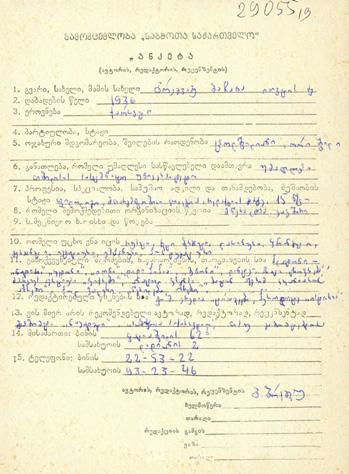

baCana bregvaZis `bolo drois Canawerebi~ avtoris sulis, gonis, xasiaTis relevanturi anareklia. `bednierebaa, roca wignis furclebze ise isvenebs daRlili suli, rogorc gadamfreni frinvelebi isveneben gaSlil zRvaSi gemis anZaze~ (`kargi wigni~). swored aseTi wignia `bolo drois Canawerebi~, romlis mimoxilvas isev da isev avtoris citirebiT vasruleb: `sicocxle _ brdRviala CiraRdani, Taobebi xelidan xelSi rom gadascemen Taobebs. numc Camqraliyos ukuniTi ukunisamde!~ (`estafeta~).
P. S. ar minda gamomrCes baCana bregvaZis niWierebis kidev erTi waxnagi, _ ulamazesi kaligrafia, _ qarTul, ZvelberZnul da laTinur enebze. dRemde vinaxav 1967 wliT daTariRebul mis xelnawers „sami iaponeska“. saqme is gaxlavT, rom maSin didad viyaviT dainteresebuli iaponuri haikusa Tu tankis JanriT. baCana ratomRac ar iziarebda Cvens aRtacebas, _ ra unda magis daweraso! Tu asea, damimtkice-meTqi, mivaxale: ki batonoo, _ mipasuxa gverdiT magidaze mjdomma baCanam da sul male SeTxza „sami iaponeska“. ise movixible, rom Cuqeba movTxove, razec baCanas gulianad gaecina, _ neta rad gindao; warwerac ki gavakeTebine da romelsac mkiTxvels pirvelad vTavazobT...
In his “Latest Notes”, dark humor sometimes gives way to sarcasm: “For Indo-Europeans, the “State” equals, in the first place, a “solid stance”, and is the greatest guarantee of staticity and stability. But for us? – instead of a “solid stance”, it corresponds more to “falling down” and “being knocked down” (naturally, I am speaking of the current Georgian “state”), a disconnection between social classes and between political parties, relentless verbal abuse, cursing and damnation, chaos, conflicts, the silent frown of the intelligent ones, the detestable howling of the fools, betraying national interests, taking advantage of one’s status, the insolence of scavenging vultures, moral corruption under a cap of invisibility, the destruction of the economy, energy crisis, the death of culture, the collapse of territorial integrity, the ungodly plucking of emaciated people, persecution and torment, fighting and killing one another, and total neurasthenia.” (‘The State’)
It is only in his ‘Latest Notes’ that the author made his wish come true: “I often think about the enormous, completely introverted spiritual energy that pulses like starlight in the monasteries or temples shredded with mystery in Greece (Mount Athos), India (the slopes of the Himalaya mountains), Tibet, China, or Japan.
My most heartfelt desire was to visit each and every one of them, and to live there for a while.
That was the wish, and I think it has disappeared, as it doesn’t seem it was destined to be.
But which of my wishes came true anyway?!” (‘Stars and Humans’)
‘Latest Notes’ ends with a rhetorical question: “The Christ was born. God was incarnated in a human… What will humans do in return?”
At the end of his life, apart from the general, ambient problems, Bachana Bregvadze was also hit by a difficult illness; the “cleaning” of the society from its intelligentsia wasn’t giving him much hope anyway.
Bachana Bregvadze’s ‘Latest Notes’ are a relevant reflection of the author’s soul, mind, and character.
“It is pure bliss when a tired soul rests on the pages of a book like birds on a ship’s mast in the sea”. (‘A Good Book’)
This is precisely the kind of book that is ‘Latest Notes’, the survey of which I will, again, finish with an excerpt of the author:
“Life – a glowing torch that generations hand to generations.
May it never fade in darkness!” (‘Relay’)
P.S. I don’t want to forget about another facet of Bachana Bregvadze’s talent – beautiful calligraphy in Georgian, Greek and Latin. I have been keeping his handwritten ‘Three Japanese Ones’ since 1967. Back then, I was very interested in Japanese haiku and tanka genres. For some reason, Bachana didn’t share my interest – “It’s so easy to write!”, he said. I told him that if it was so easy, he should prove it, and he agreed from the table next to mine, and composed these “Three Japanese Ones” very quickly. I was so impressed that I asked him to gift the poems to me, to which Bachana laughed – “Why would you even want that?”. I even made him do an inscription, and I offer this to readers for the first time…
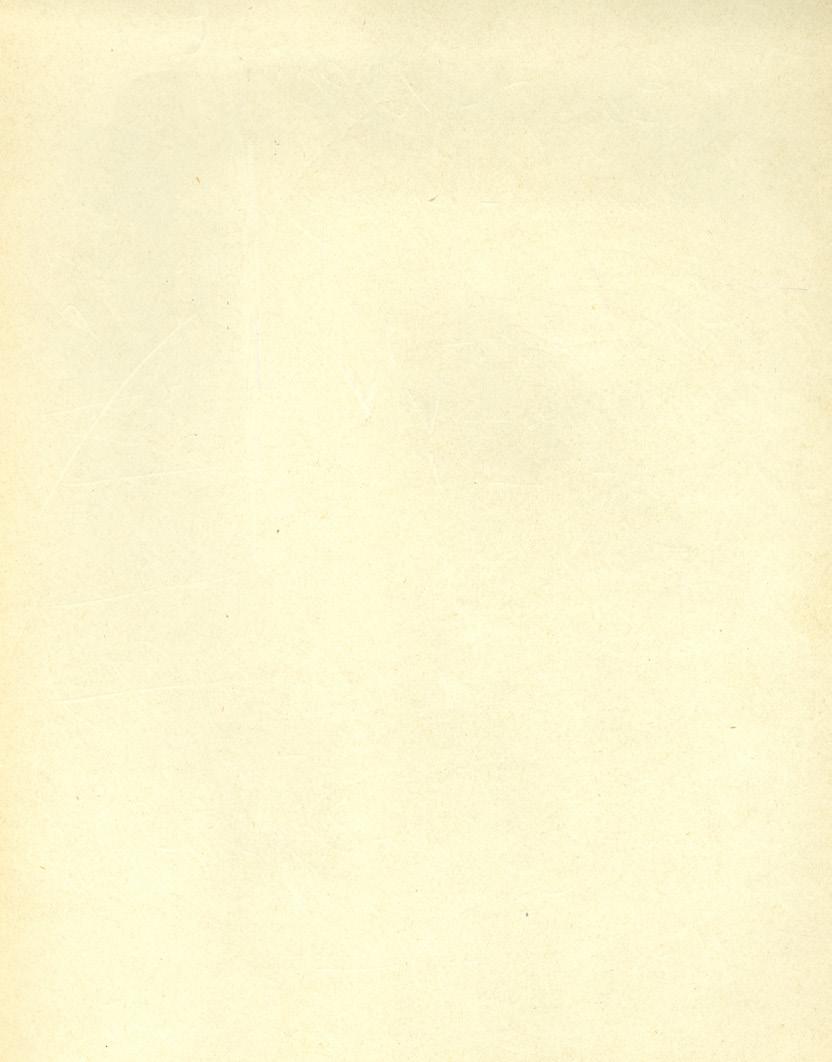

sofiko qeburia
2020 wlis erT-erT interviuSi gia xuciSvili ambobs, sazRvargareT arasdros vyofilvaro. arada, misi ferwera isea gajerebuli me-20 saukunis modernizmis mxatvruli gamocdilebiT, gegoneba, araTu originalebSi enaxos postimpresionistebi, fovistebi, kubistebi, konstruqtivistebi, abstraqtuli eqspresionistebi, aramed maTi haeriT esunTqos, maTiT aedgas ena. saidan, rogor? cxadia, amas mis siymawvileSi arsebuli Sav-TeTri albomebidan ver SeiTvisebda. es ukve pedagogebis damsaxurebaa _ isaa, rac gia xuciSvils mamisa da mamis megobrebis tiloebidan da maTTan saubrebidan SeeZlo „daegemovnebina“. guram (xita) quTaTelaZe, lev baiaxCevi, edmund kalandaZe, albert dilbariani, Temo maWavariani, vaxtang rurua, Tamaz xuciSvili... am Taobam wamoswia sakuTriv ferweruli amocanebi socrealizmis siyalbis sapirwoned. wina Taobebs ar vexebi, radgan maTTan gia xuciSvils piradi Sexeba ar hqonia (Segnebul asakSi mainc). giam samxatvro akademia 1989 wels daamTavra da 90-ianelTa Taobas ekuTvnis _ maT, visac pedagogebis _ 60-70-ianelTa ferwera, Segoneba Tu naubari vizualur mexsierebaSic CaekiraT, yurSic CarCaT, samyaros aRqmaSic da SemoqmedebiT „mrwamsSic“. swored am mxatvrebma moitanes Cvenamde modernizmis principi _ ara ras xedav, aramed ras grZnob; ara ras xatav, aramed _ rogor; xelovneba _ ara rogorc obieqturi realobis asaxvis saSualeba, aramed subieqturi xedvis gaziareba.
gia xuciSvilis ferwera ferebs aSiSvlebs. TiTqos mxatvars surs, yvela sagans safari CamoaSoros da feris JReradoba im intensivobiT dagvanaxos, mxolod Signidan, „kanqveS~ rom Rvivis, pulsirebs da gizgizebs. pigmentis „gradusi~ imdenad maRalia, rom suraTi damatebiT ganaTebis wyaros aRar saWiroebs, is Tavad kaSkaSebs, anaTebs. TavaSvebulad daTareSoben ferebi. es banalur realobasTan SeuTavsebeli, maJoruli ferebia, mxatvruli xedviTa da alRoTi nakarnaxevi, iseTi, mxolod subieqtur warmosaxvaSi rom SeiZleba arsebobdes. araviTari tonaluri gradacia. sagnis forma feriT iZerweba, Suq-Crdili kontrastuli wyvilebiT lagdeba da feradovani sibrtye mdidrul kolorits qmnis.



gia xuciSvili feris gurmania, Tumca mis ferweraSi calke, mowyvetilad, verc ferze isaubreb, verc formaze da verc monasmze. isini aq erTmaneTis gareSe ar arseboben.
monasmi ticianis tiloebze daibada. el grekos, velaskesisa da impresionistebis ferweraSi monasmma nelnela ufro da ufro Tamamad iCina Tavi. me-20 saukunis abstraqtul eqspresionistebTan is ukve ferweris teqnikis wamyvani instrumentia. aqac gamoadga gia xuciSvils pedagogebis Semoqmedeba _ is am tradiciis gamgrZelebelia.
saocari ram _ maSinac ki, rodesac fermweri gamWvirvale
In a 2020 interview, Gia Khutsishvili says that he’s never been abroad. But his paintings are so full of the artistic experience of 20th century modernism, that one would think that not only has he seen all the actual post-impressionists, fauvists, cubists, constructivists, abstract expressionists paintings, but that he breathed their air, and learned to express himself through them.
But how? It goes without saying that he couldn’t capture all this from the monochrome albums from his youth. This is the merit of his teachers – it is what Gia Khutsishvili could “taste” from the paintings and talks with his fathers and the latter’s friends. Guram (Khita) Kutateladze, Lev Baiakhchev, Edmund Kalandadze, Albert Dilbariani, Temo Matchavariani, Vakhtang Rurua, Tamaz Khutsishvili… This generation
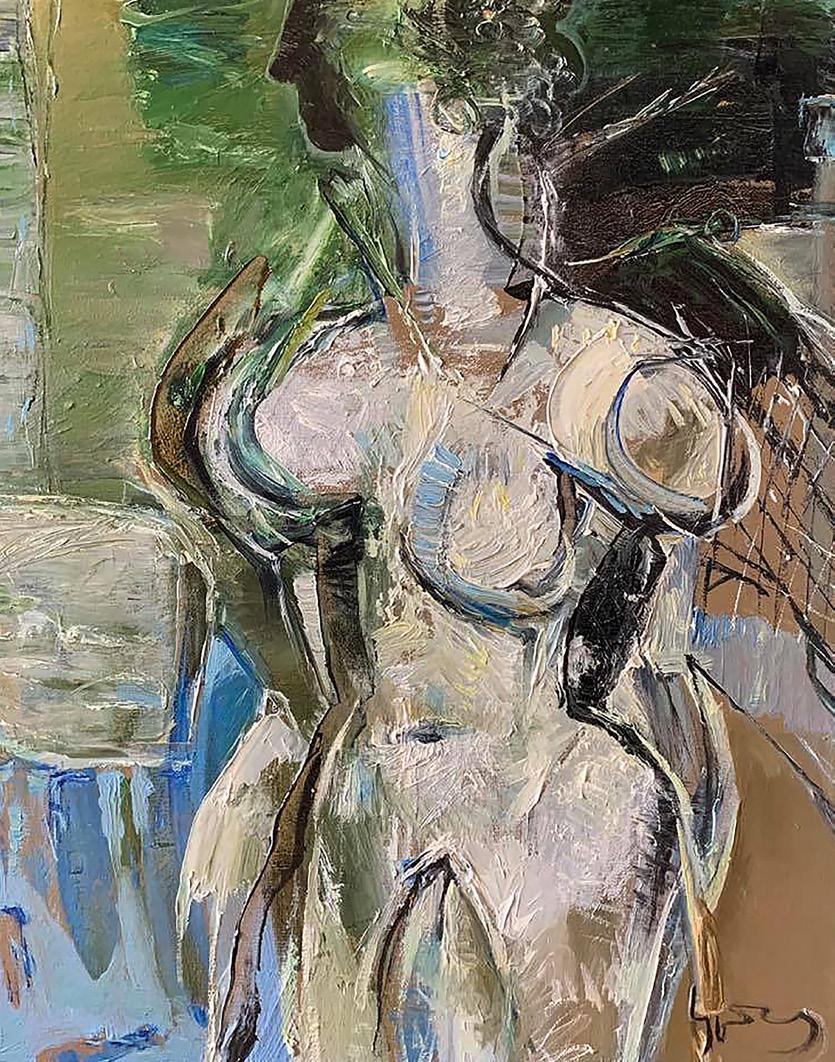

sagans wers, monasmi msuyed edeba tilos, magram es xels ar uSlis, Wiqis Tu boTlis msxvrevadi, myife, Txeli struqtura vigrZnoT. an rodesac gias surs nazi, faqizi koloritiT miayuCos peizaJis JReradoba, lirikuli ganwyoba gaaZlieros, monasmi kvlav mkvrivad da xelSesaxebad materialuria, magram suraTSi sadafisferi burusi, siCume da simSvide sufevs. umetesad, gia xuciSvilis monasmi borgavs, buybuyebs,
has weighed on the balance in the field of art against the deceit of social realism. I’m not mentioning the former generations, because Gia Khutsishvili didn’t have direct contact with them. Gia graduated from the Academy of Arts in 1989 and belongs to the 1990s generation –those whose professors’ 1960s and 1970s paintings, admonitions, or conversations have stuck to their visual and auditive memories, as well as in their worldview and creative “beliefs”. These are the painters who brought us the principles of modernism – not what you see, but what
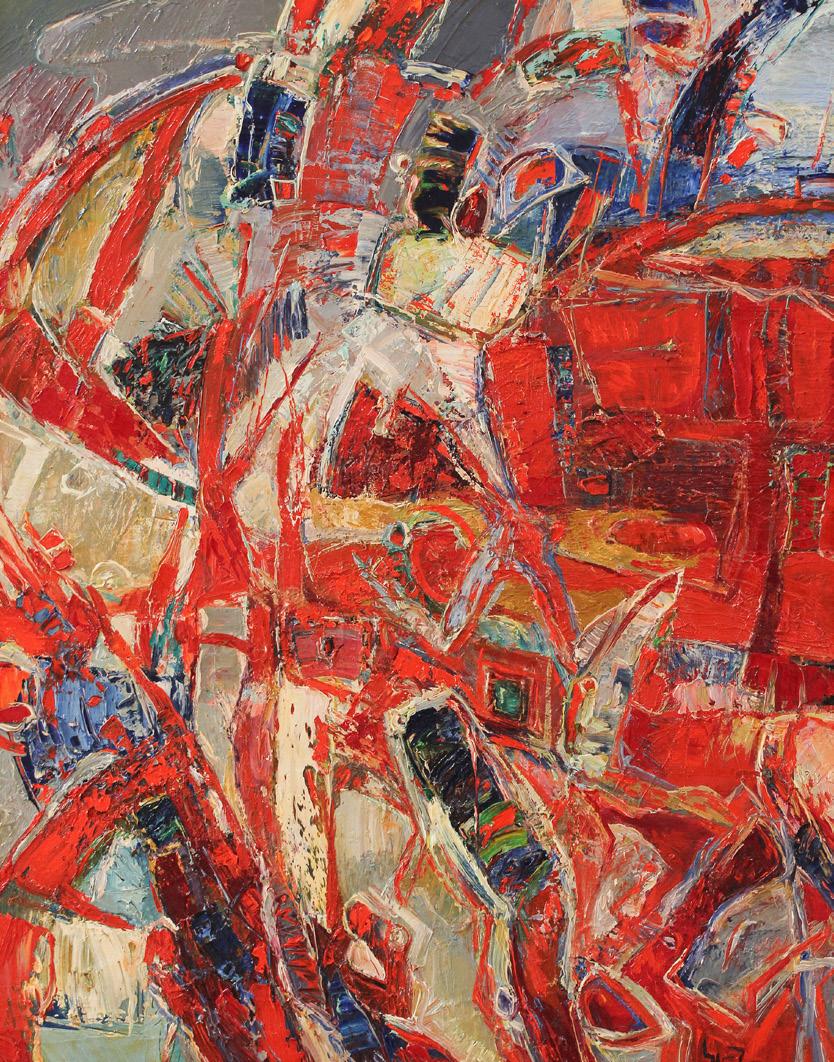
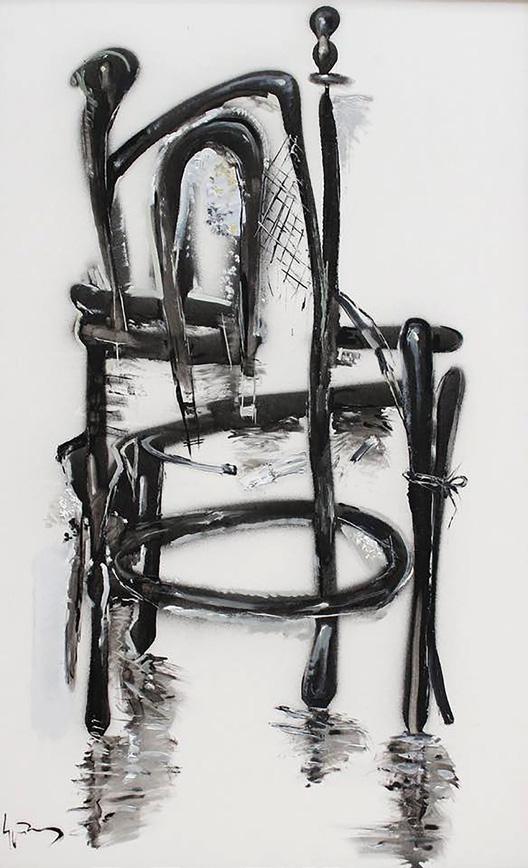

feTqavs, sagans gars evleba, SigniTac aRwevs, ver isvenebs, gamosavals eZebs, poulobs, sadRac moqnilad iRvreba, miiCqaris, an texilad miuyveba gzas. sul rom uZravi sagani edgas Tvalwin mxatvars, vTqvaT, naturmorti, ZarRviani monasmi imasac Sinagani, daudgromeli energiiT da dinamikiT avsebs. aseve mourideblad eqceva mxatvari formasac _ TiTqos sagans epiTeliums aTlis da mis mkvriv xorcsa da konstruqcias avlens. raRac iseTi suraTi davxate, vikingi rom xorcs glejs kbilebiT, magram Tavs gavimarTleb _ xelovnebis aRqma xom subieqturia?! marTali giTxraT, Cems mier danaxuli gia xuciSvili arc ise Sorsaa imisgan, rogoradac Tavad xedavs sakuTar Tavs. erT interviuSi,
you feel; not what you paint, but how you paint it; art, not as the means to represent objective reality, but to share one’s subjective vision.
Gia Khutsishvili’s paintings strip the colors bare. It’s as if the painter wants to get all objects rid of their external layers, and show the expressiveness and intensity of colors only from the inside, from “below the skin”, where it glows, pulsates, and crackles. The “degree” of the pigment is so high that the painting doesn’t need any other light sources, it radiates and enlightens its surroundings by itself. Colors flit around, unbridled. These buoyant colors are incompatible with banal life, they are inspired by an artistic vision and intuition, they can only exist in a subjective imagination. There is no tonal gradation. The shape of the object is assembled by its color, light and shadow is arranged in contrasting pairs, and the colored flatness creates a rich

xumrobiT, Tavs `rablezianeladac~ ki acxadebs. cxadia, gia xuciSvili dionisuri sawyisis moziarea. misi ferwera ar hgavs akuratuli qirurgis frTxil namuSevars. is xarbad da gaumaZRrad tkbeba formis nawilebiT da maTi mTlianobiT. figuraciul kompoziciebSi forma _ pirobiTi, xan deformirebuli, xan abstragirebuli, gamsxvilebuli, xan ki Semadgenel formebad daSlili (oRond arasdros daqucmacebuli), kontrastuli feris farTo konturiT ikvreba. ase udgeba mxatvari formas, sulerTia, is sabolood naturmortad esaxeba, peizaJad Tu portretad. es Janrebs miRma arsebuli, universaluri formebis samyaroa, Tavisi organuli arqiteqtonikiT. arqiteqtonika SemTxveviT ar mixsenebia. swored esaa, rac am „yasburad~ uxeS esTetikas daxvewil xelovnebad aqcevs. msxvili monasmis daudgromeli energia, SeuboWavad JReradi ferebis poliqromuli simfonia da mkvidrad Tu mkvrivad nagebi forma _ ai, am yvelafris mwyobr harmoniaSi moyvana, kompoziciurad gamTlianeba gia
flamboyance. Gia Khutsishvili is a gourmet of colors, but when seeing his paintings, one cannot talk separately about either his colors, shapes, or stroke. They do not exist without one another.
THE stroke was born on Titian’s paintings. Then it gradually became more confident with El Greco, Velázquez, and the impressionists. Then, with the abstract expressionists of the 20th century, it becomes a foremost instrument of the painting technique. Here too, the works of Khutsishvili’s professors were of good use, as he continued this tradition.
An astonishing feat is how the artist uses a bold stroke to paint transparent objects, but it doesn’t hinder him to convey the brittle, fragile, thin structure of a glass or bottle. Or when Gia wants to hush the expressiveness of a landscape with a soft, fragile color, in order to strengthen the lyrical effect, the stroke is still dense and physical, but the painting is dominated by a nacre mist, silence, and peace.
Most of the times, Gia Khutsishvili’s stroke tosses from side to side, rumbles, explodes, surrounds the object, goes inside of it, it cannot
xuciSvils ukve artistulad da faqizad moazrovne fermwerad warmoaCens.
calke ambavia am ferweruli karnavalis, zeimis Sinaarsobrivi mxare, gonismieri sazrisi. genialuri mxatvrebis Sedevrebi, musika, cxadSi Tu sizmarSi nanaxi, cirki, Teatri, gancdili, wakiTxuli, warmosaxuli, miTi Tu zRapari, wminda werili, proza, poezia Tu filosofiuri naazrevi _ gia xuciSvilis Semoqmedeba mravalmxrivi wyaroebiT ikvebeba. sayvarel mxatvrebs, homeross, biblias, Seqspirs, servantess, miSel de
rest, it’s looking for a way, finds it, nimbly flows there, hurrying, or follows the path like footprints. Even if the object in front of the painter is immobile, say a still life, the sinewy stroke fills it with an internal, irresistible energy and dynamic.
The painter also acts boldly with the shapes – it seems he peels off the epithelium of the object, revealing its dense flesh and construction. “I created a painting that looks a bit like it’s a Viking tearing up meat with his teeth, but I will justify myself – isn’t the interpretation in art subjective?!” To tell you the truth, my impression of Gia Khutsishvili’s art is not too far from his own. In an interview, he
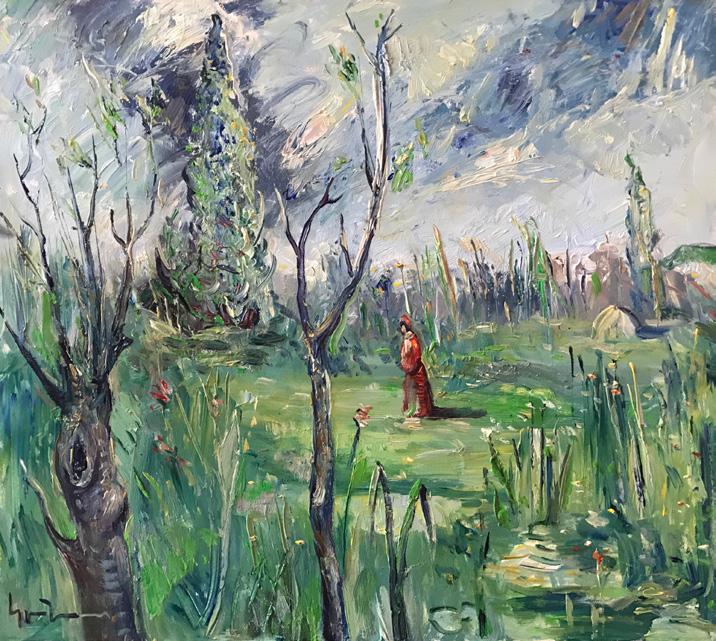
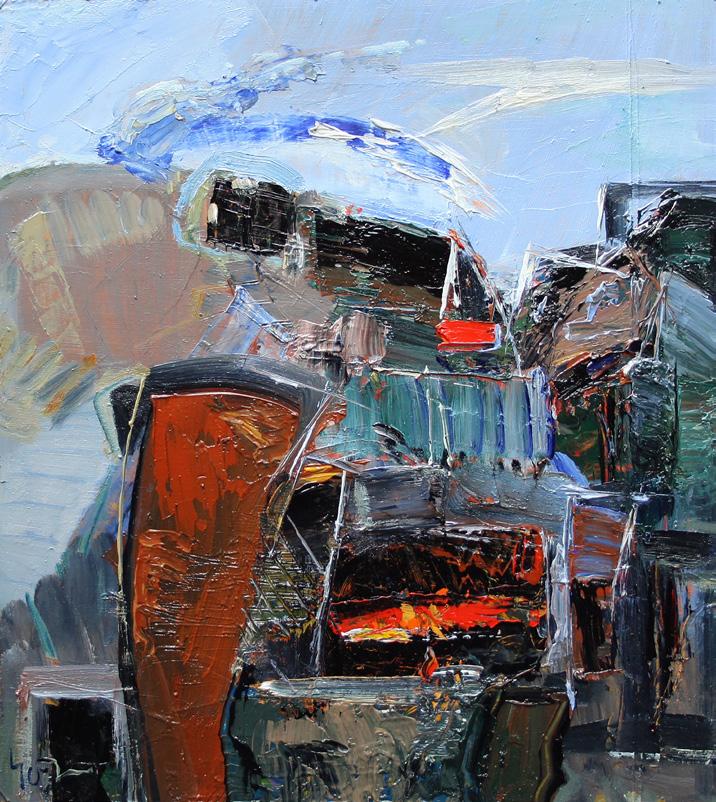
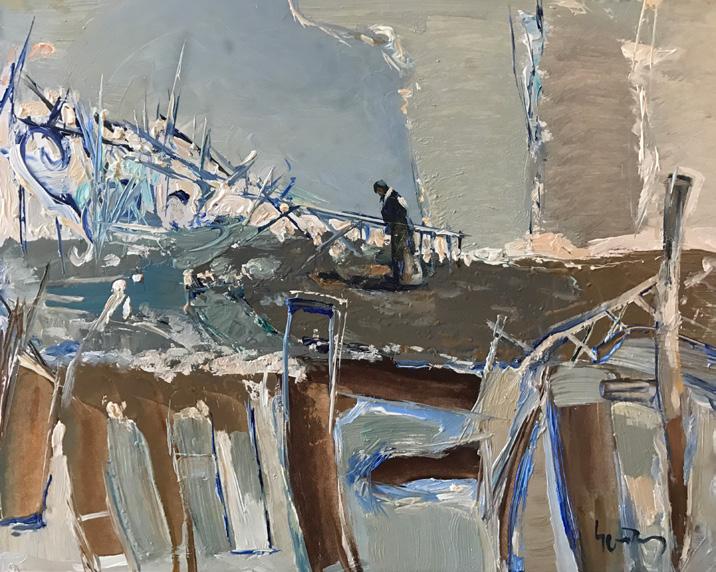
montens, garsia lorkas, giom apoliners, riCard baxs, jerom selinjers, sioren kirkegors... mxatvari subieqtur linzaSi atarebs da miseuli vizualuri eniT gviziarebs. da aq is iwyebs Tavisuflad TamaSs, saxiobas, interpretirebas. SeuZlia gaikeTos niRabi da Tqvas: „alle-hop!~ misTvis damaxasiaTebeli metaforulobaca da groteskic saxe-xatebis eqspresias aZlierebs. arc cxovrebas uvlis gverds, mSrali kanoni iqneba es Tu pandemia.
akademiis damTavrebisTanave gia xuciSvili Tavadac pedagogi gaxda da dRemde aswavlis studentebs. Tavisi maswavleblebis naambobsac gadascems da sakuTaric aqvs saTqmeli. axla misi moswavleebi agemovneben ferweris jadosnur xibls. gia xuciSvili jaWvis Ronieri rgolia, ferweris gurmanTa uwyveti jaWvis rgoli.
even joked that he is a Rabelaisian. Naturally, Gia Khutsishvili is also Dyonisian. His paintings do not look like the careful, accurate work of a surgeon. He greedily and insatiably feeds from the shapes’ parts and their wholeness. The shape of figurative compositions – conditional, sometimes deformed, sometimes abstract, enlarged, or divided in their constituent parts (but never fragmented) – is brought together by a large contour of a contrasted color. This is how the painter approaches shape, regardless of whether it’s a still life, a landscape, or a portrait. This is the universal world of shapes, beyond genres, with their own architectonics.
It is not by chance that I used the word architectonics. It is precisely what transforms this “butchery”, rough aesthetic into refined art. The roaring energy of the bold strokes, the unfettered polychromic symphony of the expressive colors, and the solid and dense shapes –



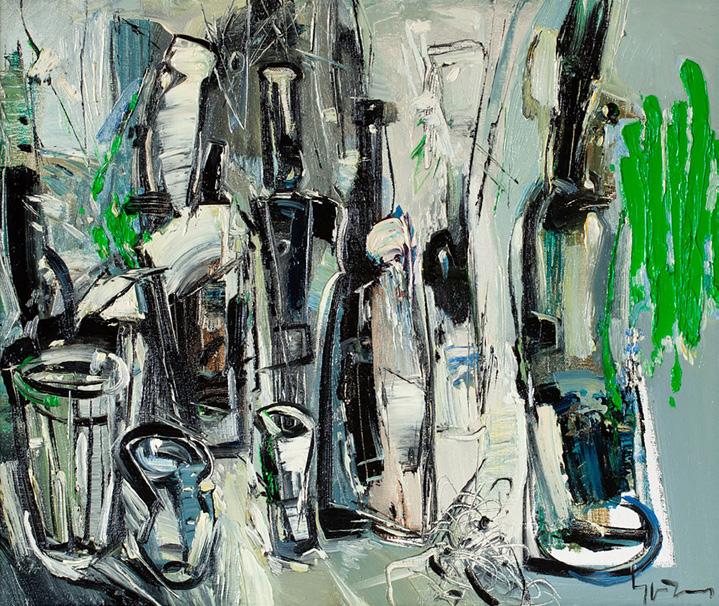
to be able to arrange all this in an orderly harmony, to unite them in a composition, makes Gia Khutsishvili a painter who thinks in an artistic and refined manner.
The essence of this feast of painting, its meaning, is another subject. The masterpieces of geniuses, music, things seen in reality or in dreams, circuses, theaters, what he experienced, read, imagined, myths, tales, letters, prose, poetry, or philosophy – Gia Khutsishvili’s works have many sources of inspiration –his favorite painters, Homer, the Bible, Shakespeare, Cervantes, Michel de Montaigne, Garcia Lorca, Guillaume Apollinaire, Richard Bach, Jerome Salinger, Søren Kierkegaard… The painter sees them
through his subjective lens, and shares them to us with his own visual language. This is where he starts to play freely, where the show begins, the interpretation. He can put on a mask and say: “Allez, hop!”. His characteristic metaphors and grotesque both strengthen the expressiveness of the subjects.
As soon as he graduated from the academy, Gia Khutsishvili became a professor himself, and he is still teaching today. He transmits what his teachers taught him, and adds his own formula to it. His students can now taste the magical charm of painting. Gia Khutsishvili is a strong link of the unbreakable chain of painting gourmets.
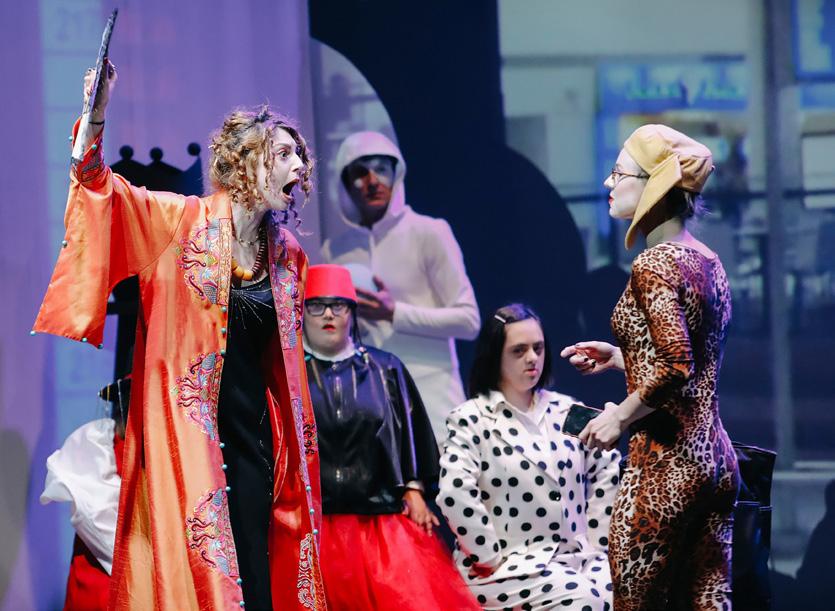
„inkluziuri Teatri kontaqti~ Tanamedrove dramatuli xelovnebis sruliad axal, konceptualur mimdinareobas warmoadgens, romelsac safuZveli 2015 wels Caeyara. Teatris damfuZneblebi arian _ ira koxreiZe (reJisori/ xelovnebaTmcodne/qoreografi) da giorgi miqaberiZe (fsiqologi/mxatvari). dasi integrirebulia da SemoqmedebiTi jgufi 25 adamianisgan Sedgeba, sadac profesional msaxiobebis da xelovanebis gverdiT, Tanasworad muSaobs da moRvaweobs 12 specialuri saWiroebis mqone msaxiobi. es damoukidebeli sivrcea, romelSic eqsperimentuli, sruliad axali saavtoro Semoqmedeba iqmneba da Tanamedrove dramatuli xelovnebis, pantomimis da inkluziurobis Tavisebur Serwymas warmoadgens. am Teatris specifikuri (inkluziuri proeqtebisTvis uCveulo) repertuari, muSaobis gansxvavebuli stili da midgomebi erTgvar unikaluri saavtoro sistemaa,
The Inclusive Theater ‘Contact’ represents a completely new, conceptual way of performing contemporary dramatic art. It was founded in 2015. The founders of the theater are Ira Kokhreidze (director/art historian/choreographer) and Giorgi Mikaberidze (psychologist/painter). The troupe is a consolidated and creative group of 25 people, in which next to professional actors and artists, 12 actors with special needs work in equal conditions.
It is an independent space, in which experimental, completely new art-house performances are created and which offers an original combination of contemporary drama theater, pantomime, and inclusivity. The specific (not regular for inclusive projects) repertoire of this theater, its distinct style of work and approaches is a unique system that was generated by the theater’s founders.
Ira Kokhreidze: to us, the specifics of our theater, which was based on a new and different approach, is very important and interesting. We take much care of our experience. We see each performance as a special charge of energy that creates an impulse for future
romelic Teatris xelmZRvanelebis mier SemuSavda. ira koxreiZe: CvenTvis Zalian mniSvnelovani da sainteresoa axal, gansxvavebul midgomaze dayrdnobiT warmarTuli Cveni Teatris specifika. Zalian vufrTxildebiT Cvens gamocdilebas. yovel speqtakls aRviqvamT, rogorc gansakuTrebul energiis birTvs, romelic qmnis samomavlo ganviTarebis impulss. muSaobis procesi improvizaciis saSualebas gvaZlevs da es msvleloba imdenad Slis sazRvrebsa da CarCoebs, rom saboloo jamSi viRebT Sedegs, romelic arRvevs Seqmnil stereotipebs inkluziur xelovnebaze. muSaobis procesSi gvekargeba aRqma imisa, rom es aris inkluziuri, specifikuri, Tu socialuri datvirTvis proeqti, gamodis ise rom ubralod bunebrivad ar vansxvavebT adamianebs erTmaneTisgan, CvenTan moqmedebs Tanasworobis principi, aravis ar gamovyofT da yvela aqtiurad aris CarTuli
development. The working process allows improvisation, and this erases all borders and frameworks, that in the end, we get a result that overcomes the existing stereotypes about inclusive art. During the working process, we lose the feeling that this is an inclusive, specific, or socially charged project, it just naturally leads to not discriminating between people, we believe in equality, we do not reject anyone, and everybody is actively involved in the same work process, be they professional or special needs actors. We can say that we have created a microcosm in which everything is possible, and we convey that with the most sacred medium – art.
I think that art is the only and the freest space, in which one can talk about anything. Life itself, people and every day is a great inspiration. This is a space where we can talk about the great universal questions – love, philosophy, the meaning of life; but also about other things – vices, lies, superficiality, meanness. There is always a significant dualism in my spectacles. “There is no object without a shadow”, so

erTi saqmis keTebis procesSi, ar aqvs mniSvneloba es profesionali Tu specialuri saWiroebis mqone msaxiobia. SegviZlia vTqvaT, rom Cven SevqmeniT mikro samyaro, sadac yvelaferia SesaZlebeli da amas gadmovcemT yvelaze sakraluri xerxiT _ xelovnebis meSveobiT. vfiqrob Semoqmedeba erTaderTi da yvelaze
Tavisufali sivrcea sadac SesaZlebelia yvelaferze saubari. Tavad sicocxle, adamianebi da yoveldRiuroba udidesi inspiraciaa. es aris sivrce sadac SesaZlebelia saubari rogorc udides samyaroseuli movlenebze _ siyvarulze, filosofiaze, cxovrebis arsze; aseve meore mxarezec _ mankierebaze, sicrueze, zedapirulobaze, borotebaze. Cems speqtaklebSi yovelTvis arsebobs dualizmis mniSvneloba. `ar arsebobs sagani Crdilis gareSe~ amitom TiToeuli axali piesa TiTqos jaWvurad ebmis Semdgoms da qronologiuri xasiaTi aqvs. is risi Tqmac ver movaswari wina dadgmaSi aucileblad vaJRereb momdevnoSi. magram im misticizms rac iqmneba scenaze ukve qmnis uxilavi energiaa, romlis nawili yvela xdeba monawilec da mayurebelic. yvela piesa da dadgma Taviseburad gamorCeulia CemTvis, radgan did emocias vdeb magram gamovarCevdi bolo namuSevars `zRvis karibWe~, aseve „idumali mTis miRma~ romlis premierad mxolod satelevizio formati Sedga. am piesebTan yvelaze
each new play seems to follow the former in a chronological link. If there’s something that I couldn’t fit in a play, I will definitely put it in the next one. But the mysticism that is created on the stage comes from an invisible creative energy, and everybody becomes part of it, including spectators. Each play and performance are different to me, because I put a lot of emotion in each of them, but I would single out the latest “Sea Gate”, as well as “Beyond the Silent Mountain”, the premiere of which only took place in a TV format. I feel the closest to these plays from an energetic and emotional perspective.
Years ago, we were touring in China, in Beijing, where we took part in an international dramatic arts festival. We performed our play ‘Contact’ twice, which has played a role in the latest name of our theater. It was an unforgettable experience and emotion, when you feel how people from another culture, mentality and tradition have understood and grasped the subject and the intentions of the director. This experience gave us even more incentive for future development.
The current repertoire of the inclusive theater ‘Contact’ includes eight original plays, and the director of most of them is dramaturge and director Ira Kokhreidze, while the scenographer and art director of the theater is Giorgi Mikaberidze.
Giorgi Mikaberidze: Everybody has their own specific role and task, but in the end, everything we see on the stage is the result of a common energy and enthusiasm. The contents of the plays are mainly
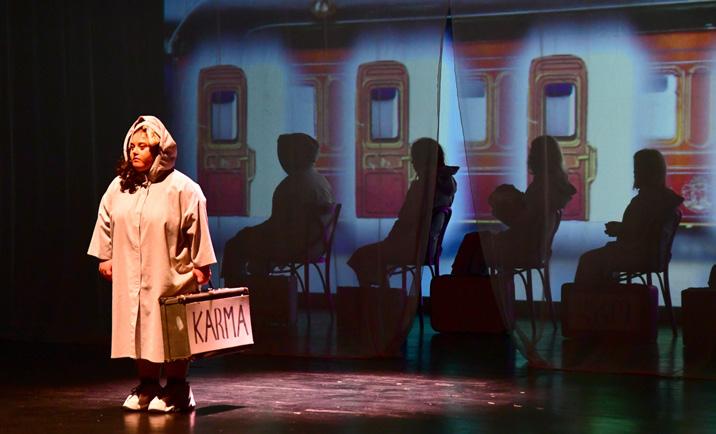
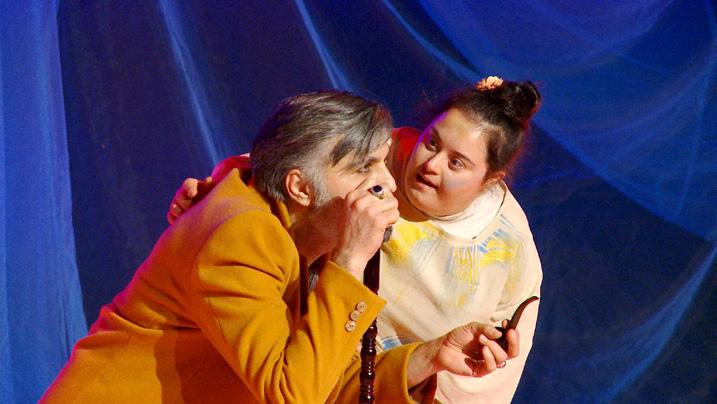
did siaxloves vgrZnob emociuri da energetikuli TvalsazrisiT.
wlebis win gastroliT vimyofebodiT CineTSi, pekinSi, sadac miviReT monawileoba CineTis dramatuli xelovnebis saerTaSoriso festivalze. orjer viTamaSeT Cveni saavtoro speqtakli „kontaqti~, romelmac Cveni Teatris saboloo saxelwodebaze iqonia gavlena. es iyo dauviwyari gamocdileba da SegrZneba, roca grZnob sxva kulturis, mentalitetis da tradiciis adamianebisgan Tu rogor Cawvdnen, gaiazres Tema da reJisoris Canafiqri. am gamocdilebam mogvca kidev damatebiTi stimuli momavali ganviTarebisa.
„inkluziuri Teatri kontaqtis~ repertuari am droisTvis Sedgeba rva saavtoro speqtaklisgan, romelTa ZiriTadi dramaturgi da reJisori ira koxreiZea, dadgmis scenografi da Teatris samxatvro xelmZRvaneli giorgi miqaberiZe gaxlavT. giorgi miqaberiZe: yvelas Tavisi gansazRvruli saqme da movaleoba aqvs, magram saboloo jamSi yvelaferi rasac vxedavT scenaze erToblivi energiis da enTuziazmis Sedegia. speqtaklebis Sinaarsobrivi mxare ZiriTadad efuZneba filosofiis, anTropologiis da fsiqologiis mimarTulebebs. speqtaklebSi xSirad SeimCneva egzistencialuri sakiTxebis aqtualoba. frTxili, sakraluri midgomiT, vcdilobT SevexoT
based on philosophy, anthropology, and psychology. They often address the topicality of existential questions. With a careful, sacral approach, we try to touch upon such fragile themes as the creation of our world and the existence of humans. Together with working on philosophical texts, we use mimodrama and choreographic narrative styles, which adds up to an interesting synthesis for us.
Dramaturgy, choreography, and music are all created by our local creative group, which leads to a high-quality Georgian inclusive artistic product based on new, unique experiences. We highly respect the experience of our colleagues from other countries, and we also communicate and collaborate with them, but to be frank, our interest was never to import some template, which would have been too uninteresting and easy as an approach. We like the process of creating and molding our own experience, which brings a much more difficult but also uniquely deep and authentic development dynamics.
A very significant subject is how working in this theater influences actors of the differently abled. After eight years of work, the transformation of persons with disabilities in the troupe became clear for everyone. We can proudly say that many of them had a “quantum leap” in terms of socialization and self-expression. Their confidence, activeness, private and professional skills have developed. They also have a great sense of responsibility, zealousness, healthy ambition, and they have goals and other needs that appear in individuals when they feel as full-fledged members of a social group (in this case, as members of the troupe). An integrated, friendly and professional

iseT faqiz Temebs, rogoricaa samyaros qmnadobis da adamianis yofierebis sakiTxebi. filosofiur teqstTan muSaobasTan erTad aseve mimodramuli da qoreografiuli Txrobis stils viyenebT, rac CvenTvis saintereso sinTezs warmoadgens.
dramaturgia, qoreografia, musika iqmneba adgilobrivi SemoqmedebiTi jgufis avtorobiT, rac qmnis axal unikalur gamocdilebaze Seqmnil maRali xarisxis qarTul inkluziur saxelovnebo produqts. did pativs vcemT Cveni kolegebis gamocdilebas sxva qveynebidan, gvaqvs kidec maTTan komunikacia da TanamSromloba, Tumca gulaxdilad getyviT, Cveni interesi arasdros yofila sxvisi Targebis gadmoReba, es piradad CvenTvis uintereso da martiv midgomas warmoadgens. Cven mogvwons sakuTari gamocdilebis Seqmnis da Zerwvis procesi, rac bevrad ufro rTul magram saocrad Rrma da avTenturi ganviTarebis dinamikas qmnis.
Zalian mniSvnelovani sakiTxia, Tu rogor gavlenas axdens am TeatrSi muSaoba aratipuri ganviTarebis msaxiobebze. rva wlis dakvirvebam cxadyo, rom dasSi dakavebuli SSm pirebis transformacia yvelasTvis TvalSisacemia. SegviZlia Tamamad vTqvaT rom bevrma
environment makes it easier for differently abled people to develop the veiled, unique talents they have, and to attain self-realization. We assign every role, text, and movement range individually. We try to not single out anybody, but at the same time, we try to create a play in which every participant actor is an active and integral part of a whole.
Our theater has performed at the Marjanishvili, Rustaveli, Sokhumi and Telavi theaters’ stages. The inclusive theater ‘Contact’ is the first Georgian inclusive art project that has gone beyond our borders and was rewarded with several international and local prizes, including the China International Drama Art Festival, the International Art Festival ‘Sachukari’, SVANSET, and the Minsk International Inclusive Festival.
It is worth noting that for the important role played in the development and popularization of contemporary inclusive theater art, our main director Ira Kokhreidze was awarded a presidential medal of honor in 2022.
Apart from the abovementioned successes, we unfortunately have to talk about some urgent problems and challenges that our theater is facing. The biggest is that we don’t have our own working space. We have to work in very difficult and extreme conditions, and rehearse in various place, and in a limited time, which isn’t enough for the troupe
maTganma „kvanturi naxtomi~ moaxdina socializaciis da TviTgamoxatvis kuTxiT. Zalian gaizarda maTi Tavdajerebulobis, aqtiurobis, pirovnuli da profesiuli unar-Cvevebis xarisxi. aseve ikveTeba maTSi maRali pasuxismgeblobis SegrZneba, Sromismoyvareoba, jansaRi ambiciis da miznebis da sxva saxis moTxovnileba, rac adamianSi zogadad vlindeba maSin roca Tavs sociumis srulfasovan wevrad grZnobs (am SemTxvevaSi dasis wevrad). integrirebuli, megobruli da profesiuli garemo xels uwyobs SSm msaxiobebs sakuTari faruli unikaluri unarebis gamovlenaSi da TviT realizaciaSi. yvelas individualurad vargebT rols, teqsts da moZraobis diapazons. Cven vcdilobT aravin ar gamovyoT magram amasTanave vcdilobT vqmnideT dadgmas ise, rom yvela masSi monawile msaxiobi iyos erTi mTlianis aqtiuri da ganuyofeli nawili.
Cvenma Teatrma speqtaklebi warmoadgina: marjaniSvilis, rusTavelis, soxumisa da Telavis Teatrebis scenebze. „inkluziuri Teatri kontaqti~ aris pirveli qarTuli inkluziuri saxelovnebo proeqti, romelic gascda sazRvrebs da ara erTi saerTaSoriso da adgilobrivi aRiareba da jildo moipova. maT Soris: CineTis saerTaSoriso dramatuli xelovnebis saerTaSoriso festivali, xelovnebis saerTaSoriso festivali „saCuqari~, SVANSET, minskis saerTaSoriso inkluziuri festivali.
aRsaniSnavia, rom Tanamedrove inkluziuri Teatraluri xelovnebis ganviTarebaSi da popularizaciaSi Setanili gansakuTrebuli wvlilisTvis Cveni Teatris mTavari reJisori ira koxreiZe 2022 wels dajildovda saprezidento Rirsebis medliT. zemoaRniSnuli warmatebebis fonze, samwuxarod unda visaubroT aseve mwvave problemebsa da gamowvevebze, romlis winaSec dgas Cveni Teatri. umTavresi problema, romlis winaSe vdgavarT, mdgomareobs imaSi rom Cven ar gvaqvs Cveni sakuTari samuSao sivrce. Zalian rTul da eqstremalur pirobebSi gviwevs muSaoba, sxvadasxva sivrceSi gviwevs repeticia, Tanac Zalzed SezRuduli droiT, rac arasakmarisia dasis srulfasovani muSaobisTvis. dRemde vimyofebiT „stumrad~ sxvadasxva sivrceSi, risTvisac did madlobas vuxdiT yvelas maspinZlobisTvis da mxardaWerisTvis, magram cxadia, rom mxolod sakuTar gankargulebaSi myof sivrceSia SesaZlebeli srulfasovani samuSao procesi da ganviTareba. meore mniSvnelovani problema aris stabiluri dafinansebis ar arsebobis sakiTxi. mxolod erTjeradi da mcire grantebi fizikurad ar aris sakmarisi srulyofili procesis warmarTvisTvis, imis gaTvaliswinebiT rom Cveni erT-erTi mizania SSm msaxiobs hqonds SromiTi anazRaureba, rac aucilebelia maTi sazogadoebaSi realuri integraciisTvis. am rTul
to work properly. To this day, we are “guests” in various spaces, for which we are very grateful to all hosts for their support, but it became clear that it is only in our own space that we will be able to rehears and develop properly. The second significant challenge we are facing is that we don’t have stable financing. Punctual and small grants are physically not enough to fund the whole process, considering that one of our goals is to provide salaries to the differently able for their work as actors, which is a must for their real integration in society. In these difficult conditions, we still continue the work we love, and it is mostly thanks to enthusiasm and the help of friends that we have manage to keep a permanent inclusive troupe that creates high-quality art products alive for the ninth year in Georgia. We think that it should be a priority for both the public and private sectors to substantially support a fundamental development of this project.
Our latest work is the play ‘Sea Gate’, the premiere of which took place in 2023 on the stage of the Sokhumi Theater. For eight months, differently abled people and professional actors have tierelessly and passionately worked on this play. Compared to former plays, we tried to use different approaches, both in choreography and dramaturgy. The main character of the play is a mystic whale that represents cosmic consciousness. It lives near a small coastal city. The inhabitants of the city do not realize the essence of this whale, they cannot decide if it’s a demonic or divine being. The state of the inhabitants themselves is of high significance here. Are they sleeping, in the realm of dreams, or are they awake? Water represents the subconscious, while the heavy whale represents the creativity in all of us. The play also uses poetry from the Persian poet and mystic Jalal al-Din Rumi. The main idea of the play is humans’ constant battle and search for an answer to the question – Why are we in this world? Where should we look for a door beyond which is the state that our soul is looking for –freedom? Perhaps this gate is located on the border between dream and reality. In order to go beyond a dream, you have to get free and wake up!

pirobebSi mainc vagrZelebT sayvarel saqmes da met wilad enTuziazmis da megobrebis daxmarebiT vaxerxebT imas, rom saqarTveloSi mecxre welia arsebobs mudmivmoqmedi inkluziuri dasi, romelic maRali xarisxis saxelovnebo produqts qmnis. vTvliT, rom rogorc saxelmwifosTvis, ise kerZo seqtorisTvis prioritetuli unda iyos am proeqtis ganviTarebis safuZvliani xelSewyoba.
Cveni bolo namuSevari aris speqtakli „zRvis karibWe“, romlis premiera Sedga 2023 wels soxumis Teatris scenaze. rva Tvis ganmavlobaSi SSm da profesionali msaxiobebi dauRalavad, gulanTebulni Sromobdnen am dadgmaze. wina speqtaklebTan SedarebiT Cven SevecadeT gamogveyenebina ufro gansxvavebuli midgomebi, rogorc qoreografiaSi, ise dramaturgiaSi. piesis mTavari gmiri aris mistiuri veSapi, romelic ganasaxierebs samyaroseul gons. is binadrobs patara zRvispira qalaqis maxloblad. qalaqis binadrebi kargad ver iazreben am veSapis arss, ver arkveven, is demonuri Tu RvTaebrivi arsebaa. aq ufro mniSvnelovania Semdegi sakiTxi _ ra mdgomareobaSi arian Tavad am qalaqis macxovreblebi; mZinareni, sizmrebis samyaroSi imyofebian Tu fxizloben. wyali adamianis qvecnobieris aRmniSvnelia, xolo boboqari veSapi warmoadgens Semoqmeds TiToeul CvenTaganSi. dadgmaSi aseve gamoyenebulia sparsi poetisa da mistikosis jalaledin rumis poezia. speqtaklis saboloo ideaa _
By the way, we faced many difficulties when preparing the whale prop. It turned out difficult, several people have tried but it didn’t work out. In the end, after a long research process, we found a craftsman who made this character with love and diligence, and it resulted in the exact whale we had imagined…
It is worth noting that French journalists that were shooting a film about inclusion for the TV channel CANAL+ have attended the last rehearsal and the premiere of the show. The main character of their play was our autist actor Sandro Darsavelidze. Because our French guests travel in numerous countries and know the repertoire of inclusive theater art in Europe very well, their appraisal and the enthusiasm they expressed meant a lot to us: “This is dramatic art of the highest quality. We have never seen an inclusive play of this level anywhere before.” They offered us to collaborate on a specific project in the future, which we gladly accepted.
Nano Gordadze – Being a member of this troupe had heightened my freedom and taught me that you shouldn’t fear challenges. This theater has educated me not only as an actress, but also as a human being. I can better express thoughts, compassion, and emotions. The working process is very variable and interesting, I work and am friends with very talented people. Ira and Giorgi are very professional and selfless people, and they are examples to follow. I am proud to be part of this troupe.
Giorgi Gavasalia – I am very lucky to be part of this project. This theater completely changed my life. I became more active and


adamianis mudmivi Widili da pasuxis Zieba kiTxvaze _ risTvis varT am wuTisofelSi? sad veZeboT kari, romlis miRma SesaZloa, swored is mdgomareobaa, rasac eZebs suli _ gaTavisuflebas. SesaZloa es karibWe mdebareobs sazRvarze, sizmarsa da Tavisufal samyaros Soris. imisTvis rom gascde sizmars unda `gaTavisuflde~ da gaiRviZo!
sxvaTaSoris veSapis (rekvizitis) damzadebisas bevr dabrkolebas wavawydiT. misi Seqmna rTuli da sapasuxismgeblo aRmoCnda, ramdenime adamianma scada magram ar gamouvida am rekviziti/personaJis damzadeba. saboloo jamSi, bevri Ziebis Semdeg vipoveT ostati romelmac Seqmna es personaJi siyvaruliT da rudunebiT, zustad iseTi, rogoric gvqonda Cafiqrebuli,..
aRsaniSnavia, rom generalur repeticias da aseve speqtaklis premieras daeswrnen frangi Jurnalistebi, romlebic saqarTveloSi iRebdnen films inkluziur
Tematikaze telearxisTvis CANAL+. maTi proeqtis mTavari personaJi iyo Cveni autisti msaxiobi sandro darsaveliZe. iqidan gamomdinare, rom frang stumrebs uamrav qveyanaSi uwevT mogzauroba da SesaniSnavad icnoben inkluziuri Teatraluri xelovnebis repertuars evropaSi da sxva qveynebSi, amis gaTvaliswinebiT maTi Sefaseba da
planned many goals in my life. This is my second home, and I am happy beyond limits to be part of this group, I want to continue developing and going forward with this theater. I really hope that we will have our own place soon.
Gvantsa Javakhishvili – Coming to this theater has radically changed my life. I eagerly await the weekend to come from Telavi and attend the rehearsals, in which I always find a very pleasant, friendly atmosphere full of love. I really love my friends and directors Ira and Giorgi. Life has become more interesting and varied… I became more responsible and happier. People recognize me on the streets. They express their affection, and I like this very much, it makes me happy. I am happy that I can stand on a large stage and share success with my friends and directors. The theater has given me the opportunity to travel in colorful and fairytale worlds, and to become part of these worlds through the characters I play. I cannot imagine my life without our theater. I want to stand on this stage for a very long time, I want our theater to have its own building, and to offer many interesting and beautiful spectacles to the audience.
Tatia Gvasalia – I have had the chance to work with various directors in different theaters, but I think that becoming part of the large family of this particular theater was my fate. It was a moment full of responsibility in my career, and I am happy because now I have another family, I have received limitless love, and have learned that one can have relations with any individual. I have learned to pay

gamoxatuli aRfrTovaneba CvenTvis Zalian sasiamovno aRmoCnda; maTi TqmiT: _ „es aris umaRlesi xarisxis dramatuli xelovneba. aseTi donis inkluziuri speqtakli arsad sxvagan ar gvinaxavs“. maT SemogvTavazes samomavlo TanamSromloba konkretul proeqtze, razec siamovnebiT davTanxmdiT.
nano gordaZe _ dasSi wevrobam me Tavisuflebis xarisxi ufro amimaRla da maswavla, rom sirTuleebs ar unda SeuSinde. am Teatrma gamzarda aramarto rogorc msaxiobi, aramed rogorc adamiani. ganmiviTarda fiqris, TanagrZnobis da emociebis ukeTesad gamoxatvis unarebi. muSaobis procesi Zalian ganviTarebadi da sasiamovnoa, uniWieres xalxTan vmuSaob da vmegobrob. ira da giorgi saocrad profesionali da Tavdadebuli adamianebi arian, rac CemTvis didi magaliTia. me vamayob, rom am dasis wevri var.
giorgi gavasalia _ me Zalian gamimarTla, rom am proeqtis nawili var. am Teatrma Zalian Secvala Cemi cxovreba. gavxdi ufro aqtiuri da bevri mizani davisaxe cxovrebaSi. es Cemi meore saxlia da uzomod bednieri var rom am gundis wevri gavxdi, minda am TeatrTan erTad ganvagrZo ganviTareba da winsvla. didi imedi maqvs male gveqneba Cveni Senobac. gvanca javaxiSvili _ am TeatrSi mosvlam Cemi cxovreba Secvala radikalurad. gulisfancqaliT velodebi SabaTkviras, rom Telavidan Camovide da movide repeticiebze, sadac melodeba Zalian sasiamovno, megobruli da siyvaruliT savse garemo. Zalian miyvars Cemi megobrebi da reJisorebi _ ira da giorgi. CemTvis ufro saintereso da mravalferovani gaxda cxovreba... gavxdi ufro
pasuxismgebliani, bednieri. xalxi mcnobs quCaSi. meferebian da es Zalian momwons da mabednierebs. bednieri var, rom vdgavar did scenaze da Cems megobrebTan da reJisorebTan erTad viziareb warmatebas. Teatrma saSualeba momca vimogzauro ferad da zRaprul samyaroSi da Cemi gansaxierebuli personaJebis meSveobiT am samyaros nawili viyo. me ver warmomidgenia Cemi cxovreba Cveni Teatris gareSe. minda Zalian didxans vidge scenaze, Cvens Teatrs qondes sakuTari Senoba da bevri saintereso da lamazi speqtaklebi vaCuqoT mayurebels.
TaTia gvasalia _ mqonda bedniereba memuSava sxvadasxva TeatrSi moRvawe reJisorebTan, magram yovelTvis aRvniSnav bedisweris moments, vTvli rom am Teatris did ojaxSi moxvedrac Cemi bedisweraa, es Zalian sapasuxismgeblo momenti iyo Cems karierul cxovrebaSi da bednieri var radgan SeviZine didi ojaxi, miviRe uzomo siyvaruli, viswavle Tu rogor SeiZleba iurTierTo yvela individTan. kidev ufro meti yuradReba partnioris mimarT da momca saSualeba ganmeviTarebina
Tavi erTdroulad pantomimasa da dramis sferoSi. minda aRvniSno rom scenaze sxvadasxva Taobis warmomadgenlebi videqiT da zustad amaSia Teatr `kontaqtis~ xibli. anano CitaZe _ me miyvars Teatri kontaqti. aq bevri
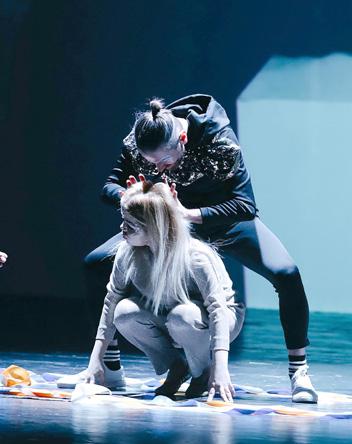

megobari myavs. erTad yofna, da gunduri muSaobis procesi Zalian mabednierebs. bevr rames vswavlobT da vSromobT. mouTmenlad velodebi xolme rodis dagvewyeba repeticiebi da vnaxav Cems reJisorebs, kolegebs da megobrebs.
tato sixaruliZe _ iras da me didi xnis nacnoboba gvakavSirebs, Tumca TeatrTan dakavSirebiT 2023 wlis maisSi gadavikveTeT, rodesac dasis repeticiaze sanaxavad mivedi. „modi vcadoT~ principiT maisidan premieramdec mivaRwieT. ver vityvi, rom adaptacia rTuli iyo. minda aRvniSno, rom megobruli koleqtivia da maTTan scenaze yofna komfortulia. irasTan muSaobis dros xSirad gvaqvs konstruqciuli azrTa gacvla da es kreatiuli procesis Semadgeneli nawilia. Riad SegviZlia visaubroT ra rogor Sesruldes, Seicvalos, gaumjobesdes, ra mogvwons, an piriqiT. erTi mxriv am koleqtivTan yofna komfortia, meore mxriv repeticiebi da speqtakli sasiamovno gamowvevaa. rogorc reJisors, aseve dasis yvela wevrs erTi survili amoZravebs _ xarisxiani produqtis Seqmna!
madlobas vuxdiT Tbilisis saxelmwifo universitets xelSewyobisTvis da sarepeticio sivrcis gamoyofisTvis; aseve kulturis saministros da Tbilisis merias, romlebic bolo oTxi wlis ganmavlobaSi mcire grantebiT, magram stabilurad gvafinanseben, rac CvenTvis mniSvnelovania...
even more attention to my partners and it gave me the opportunity to develop myself both in terms of pantomime and drama. I want to note that one of the charms of the theater ‘Contact’ is also that representatives of various generations share the stage.
Anano Chitadwe – I love the theater ‘Contact’. I have many friends here. Being together and the shared working process makes me very happy. We learn and work on many things. I always impatiently wait for the rehearsals and to see my directors, colleagues, and friends.
Tato Sikharulidze – I have known Ira for a long time, but in terms of this theater, we met again in May of 2023, when I went to see a rehearsal of the troupe. With the principle of “let’s try and see”, we went from May to a premiere. I wouldn’t say that the adaptation was difficult. I would like to underline the friendly atmosphere of the collective, and how comfortable it is to share the stage with them. When working with Ira, we often have a constructive exchange of ideas, and this is an intrinsic part of the creative process. We can freely talk about what should be done how, what could change, be improved, what we like or dislike. On the one hand, it is utter comfort to be with this collective, and on the other hand, rehearsals and shows are a real challenge. Both the director and every member of the troupe have the same goal: to create a high-quality product!
I would like to thank the Tbilisi State University for their support and for providing a rehearsal space, as well as the Ministry of Culture and the Tbilisi City Hall, who have financed us for the last four years with small but stable grants, which is very important to us…

“He’s out there”
vaJa azaraSvili _ kompozitori da pedagogi, xelovnebis damsaxurebuli moRvawe (1979), saqarTvelos saxalxo artisti (1988), Rirsebis ordenis kavaleri (1998), Tbilisis sapatio moqalaqe...
„rusTavelis premiis laureati da kidev bevri jildos mflobeli, magram esa var, raca var~-o, Semaxsena rac gamomrCa da Cveni ukanaskneli saubaric ase daiwyo.
virusiT avadmyofobis Semdeg gareT aRar gamodioda, amitom saxlSi vestumre.
Vazha Azarashvili – composer and professor, Honored Worker of Art (1979), People’s Artist of Georgia (1988), Knight of the Order of Honor (1998), Honorary Citizen of Tbilisi…
“Recipient of The Rustaveli Prize, and laureate of many other awards, but I am just what I am”, he reminded me, and this is how our last conversation started.
After catching a virus, he wouldn’t come outside, so I visited him in his home.
It was a sunny morning in Spring, he met me with his usual
gazafxulis mziani dila iyo, rogorc sCveoda xalisianad Semxvda da dro da dro mexumreboda, roca savarZelSi mokalaTda, mkiTxa: „Cems Tavze unda vilaparako"-o?
_ batono vaJa, modiT, Tqven Sesaxeb saubari sul Tavidan daviwyoT da mogviyeviT, ratom gadawyviteT gamxdariyaviT musikosi?
_ maxsendeba, 1944 weli iyo, im saukunis, meore msoflio omi kidev ar iyo damTavrebuli, Cveni mamebi wasuli iyvnen jarSi. Cem mezoblad cxovrobda fortepianos maswavlebeli, qalbatoni nadeJda Cirova, qarTulad kargad laparakobda da miTxra, rom „vaJa, Sen kargi smena gaqvs da musika unda iswavlo~-o. me vuTxari _ „ra dros musikaa, mamaCemi cocxalia Tu mkvdari ar vici da ra dros musika da garTobaa~-Tqo, maSin ase mimaCnda. arc meore wels momeSva da vinaidan, saxlSi fortepiano ar gvqonda, daviwye violinoze dakvra. ramdenime weli sul vfiqrobdi damenebebina Tu ara Tavi. mesame klasSi viyavi, roca dakvra daviwye Tbilisis samusiko skolebis gaerTianebul orkestrSi. vukravdiT baxs, mocarts da sxva raRacebs. maSin movismine musika sul sxvanairad, gamaoca saorkestro JReradoban, polifoniam da vifiqre, amas Tavi rogor davanebo-meTqi, swored maSin movixible musikiT. mere swavla gavagrZele meoTxe samusiko saswavlebelSi, romlis direqtori maSin qsenia jiqiZe iyo. erTxelac, me da nugzar vawaZe mivediT qalbaton qseniasTan da vuTxariT, rom musikas vwerdiT. man Zalian seriozulad miiRo es faqti da mogviyvana aleqsandre SaverzaSvili, kompozitori da araCveulebrivi, kargi pedagogi. man, erTxelac, me da nugzars gviTxra, rom koncerti unda gaakeToT konservatoriaSio. gagvikvirda, jer saswavleblis studentebi varT, kaci ar gvaqebs da ucbad aseT rames gvTavazobs. marTlac gavmarTeT koncerti konservatoriis mcire darbazSi, maxsovs savse iyo xalxiT. bisze gaimeores Cemi simRera griSaSvilis leqsze _ „ra kargi xar". am koncertis mere gavrcelda xmebi, rom meoTxe saswavleblidan ori Zlieri kompozitori modis konservatoriaSio da roca Cavabare, movxvdi iona tuskias klasSi, is maSin konservatoriis reqtori iyo.
maxsovs, mexuTe kursze viyavi da sadiplomo gamocda mqonda Casabarebeli. me-20 saukunis genialuri kompozitori, dimitri SostakoviCi, zustad im periodSi wyaltuboSi mkurnalobda. vinaidan, SostakoviCi, tuskia da balanCivaZe erTad swavlobdnen peterburgis konservatoriaSi da megobrobdnen, tuskiam, SostakoviCi moiyvana Cems gamocdaze. man momismina, Zalian Semaqo da komisiasTan rekomendacia gamiwia, rom xuTiani daeweraT. mere aspiranturisTvisac momca rekomendacia da swavla kvlav tuskias klasSi gavagrZele. ai, ase daiwyo Cemi Semoqmedeba. mere vaswavlidi saswavleblebSi,
enthusiasm, and was joking from time to time, after getting in his seat: “Do I have to talk about me?”
– Mr. Vazha, let us start speaking about you from the very start, please tell us why you decided to become a musician.
– I remember that in 1944, before the end of the Second World War, our fathers had gone to war. One of my neighbors was a piano teacher, Mrs. Nadezhda Chirova, she spoke good Georgian, and told me: “Vazha, you have a good ear, you should learn music”. I answered: “I don’t even know if my father is alive or not, there’s no time for music or entertainment”. That’s how I felt at the time. She insisted the next year, and because we didn’t have a piano at home, I started playing the violin. For several years, I was hesitating a lot between continuing or stopping. I was in third grade when I started playing in the joint orchestra of Tbilisi’s music schools. We were playing Bach, Mozart and other things. This is when I listened to music in a completely different way, I was blown away by the sonority of the orchestra, the polyphony, and I thought that I would never be able to quit such a thing, this is when I got infatuated with music. Then I continued studying in the Music School #4, whose director was Ksenia Jikia at
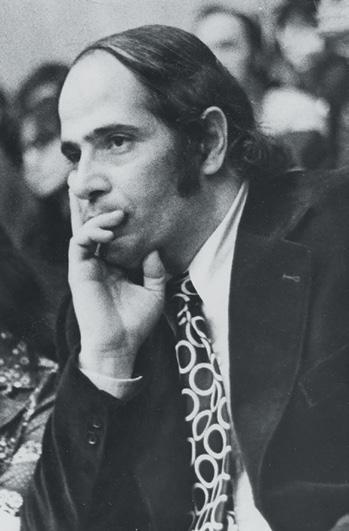
konservatoriis profesoric viyavi. axla ki vzivar saxlSi, Tumca isev vmuSaob.
- rogorc ukve TqviT axlac sul muSaobT da swored, Tqvens axal nawarmoebze minda gkiTxoT: ratom gadawyviteT kontrabasis koncertis dawera?
- yazaxma kontrabasistma, arman nazarovma mTxova, rom damewera. is SesaniSnavi kontrabasistia da moRaweobs Cvens araCveulebriv kamerul orkestrSi, „saqarTvelos sinfonietaSi", sadac yvela brwyinvale musikosia. am musikosma mTxova da mec davwere. koronas mere ver gavdivar saxlidan da samwuxarod koncertis premieras ver daveswari, Tumca Canaweri movismine, Zalian momewona Sesruleba, magram TviTon nawarmoebi patara momeCvena. erTi nawili ukve gavzarde, axla sxva nawilebsac gavzrdi. axali versia albaT male Sesruldeba, es iqneba saboloo versia am koncertis da vfiqrob, bevri daukravs, radgan deficitia am instrumentisTvis dawerili koncertebi, ZiriTadad gadamuSavebul nawarmoebebs ukraven da specialurad kontrabasisTvis Seqmnili koncerti ki Zalian cotaa, amitom mgonia, rom kargad daimkvidrebs musikosebis repertuarSi.
the time. Once, myself and Nugzar Vatsadze went to Mrs. Ksenia and told her that we were composing music. She took it very seriously, and brought Aleksandre Shaverzashvili, a composer and woderful teacher. He once told Nugzar and myself that we should hold a concert at the Conservatoire. We were surprized, we were only school students, nobody is praising us, and suddenly, he’s offering us such a thing. We really did hold a concert in the Conservatoire’s small hall, I remember that it was crowded. They did an encore of my song on Grishashvili’s poem ‘Ra kargi khar’. After that concert, rumors that two talented composers were going to enroll at the Conservatoire from Music School #4 started circulating, and when we did enter the Conservatoire, I got in Iona Tuskia’s class, who was the rector of the Conservatoire back then.
I remember that I was in the fifth year and had to pass my final exam. Shostakovich, the brilliant 20th century composer, was healing at the Tskaltubo resort at that exact period. Because Shostakovich, Tuskia and Balanchivadze had all studied together at the Petersburg Conservatoire and were friends, Tuskia brought Shostakovich at my exam. He listened to me, praised me a lot, and gave the commission the advice to give me the highest grade. Then he also gave me a recommendation for my post-graduate studies, and I continued

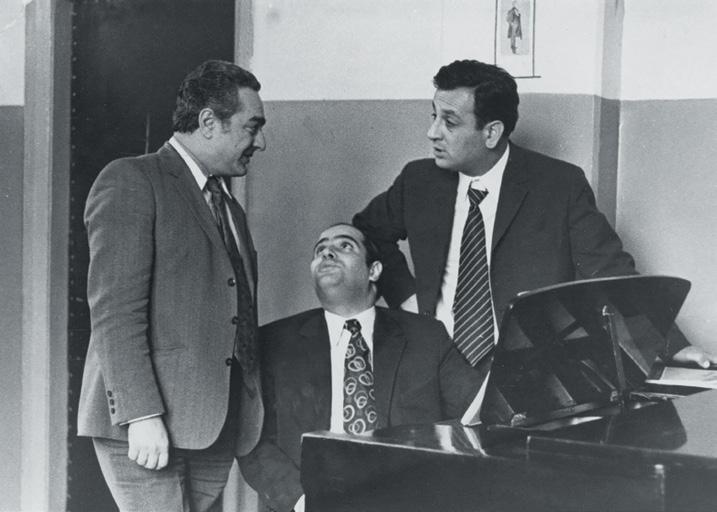
_ rogor werT musikas? instrumentTan, magaliTad fortepianosTan Tu rogor muSaobT?
_ diax, instrumentTan da xeliT. me ar vici kompiuteri, Tan kompiuteri ityueba tembrebSi, me mirCevnia instrumentis xma.
_ romel nawarmoebs gamoarCevdiT Tqveni Semoqmedebidan?
baleti „xevisberi“, quTaisSi daidga da didi gamoxmaureba hqonda. baletis garda, vinaidan instrumentalisti var da instrumenti kargad vici, araerTi koncerti maqvs dawerili. magaliTad, Zalian didi aRiareba moipova Celos koncertma, romelic eldar isakaZem daukra brwyinvaled da premiera idiriJora lile kilaZem, radios simfoniur orkestrTan. mere es koncerti araerTma violonCelistma daukra sxvadasxva qveyanaSi. aseve altis koncerti, alti rTuli sakravia da amasac xSirad ukraven xolme, saviolino koncerti sami maqvs. daaxloebiT 10 wlis win davwere koncerti
studying in Tuskia’s class. This is how my “career” started. Then I was teaching in some music schools and was a professor at the Conservatoire. Now I’m sitting at home, but I’m still working a lot.
– As you mentioned, you still work all the time, and it is precisely about your new works that I want to ask you about: why did you decide to write a bass concerto?
– Kazakh bassist Arman Nazarov asked me to write it. He’s a brilliant bassist, and plays in our wonderful chamber orchestra, ‘Georgian Sinfonietta’, in which all are accomplished musicians. So he asked me, and I wrote it. I can’t get out since the covid pandemic, so unfortunately, I missed the concert premiere, but I listened to the recording, I liked the interpretation a lot, but the piece itself seemed too short to me. I now have lengthened one part, and will lengthen another one too. The new version will probably be performed soon, it will be the final version of this concerto, and I think that many will play it, because there’s a deficit in concertos for these instruments, they usually play recycled compositions, and there are very few concertos created for bass, so I think that this work will find its place
didi simfoniuri orkestrisTvis. aseve maqvs „sazeimo uvertiura" da kidev raRacebi orkestrisTvis. 7 opereta maqvs dawerili da mus.komediaSi Svidive daidga, bileTebs ver iSovidiT iseTi ambavi iyo.
- musika xom maSin aris cocxali, roca is JRers, Sesabamisad, Semsrulebelze bevria damokidebuli. rogoria kompozitoris da Semsruleblis urTierToba?
- diax, ra Tqma unda. magaliTad, simRerebs rac Seexeba, erTi simRera maqvs moris focxiSvilis leqsze - „musika", Tamar gverdwiTeli rom mReris. sanam davwerdi, morisma miTxra, rom am leqsze simRera ver daiwerebao, magram me mainc davwere da Tamarmac araCveulebrivad imRera, amitom sami avtori hyavs am simReras: me, morisi da gverdwiTeli.
Celos koncertSic, es koncerti mamas mivuZRveni da eldar isakaZesTan erTad vwerdi, mis rCevebs viTvaliswinebdi. saocrad ukravda kodaSi im nawils, sadac gamoTxovebis scenaa, vis aRar daukravs es
in some musicians’ repertoire.
– How do you write music? Are you working at an instrument, for example a piano?
– Yes, I am at an instrument and write by hand. I don’t know computers, and computers can be deceiving in terms of timbre, so I prefer the sounds of instruments.
– Which of your compositions would you single out?
The ballet ‘Khevisberi’, it was staged in Kutaisi, and was very well received. Apart from ballets, because I’m an instrumentalist and know instruments very well, I have written many concerts. For instance, my Concerto for Cello, which Eldar Isakadze played wonderfully at a premiere directed by Lile Kiladze, together with the Radio Symphony Orchestra, was very successful. After that, this concerto was played by many cellists in various countries. There’s also an alto concerto, the alto is a difficult instrument and they play it quite often too. And I have three concertos for violin. I composed a concert for a large symphonic orchestra about ten years ago. I also have an overture and other things for orchestras. I have written seven operas and all of


koncerti, magram es koda eldaris msgavsad jer veravin Seasrula. me iq ar damiweria glisando, magram eldari am glisandos ise akeTebda, rom musikaSi emocia metad gaamZafra.
diriJorebs aqvs aseve didi mniSvneloba, magaliTad Cemi koncerti didi simfoniuri orkestrisaTvis, romelic rogorc ukve giTxariT, 10 wlis win davwere, didi xani medo da mere vaxtang kaxiZem Seasrula Zalian kargad, didi madloba vatos.
aseve, minda gavixseno daviT muqeria, baTumSi didi saiubileo koncerti gamimarTa, araCveulebrivi saRamo gamovida. kidev, erTi koncerti iyo Tbilisis konservatoriis did darbazSi, „saqarTvelos sinfonietasTan" erTad da ise momwons misi interpretacia, rom Zalian xSirad vusmen xolme. amisTvis didi madloba minda mas gadavuxado. - rogor gaixsenebdiT ufrosi Taobis kompozitorebTan urTierTobas, iRebdiT Tu ara maT rCevebs? saocar keTilganwyobas vgrZnobdi kompozitorebisgan. sulxan cincaZes Zalian vuyvardi da ase miTxra - „Sen,
them were put on stage, the tickets were sold out really fast.
– Music is alive when it is playing, and therefore, a lot depends on the performer. What is the typical relationship between a composer and a performer?
– Of course. For instance, I have a song based on Moris Potskhsishvili’s poem ‘Music’, which is sung by Tamar Gverdtsiteli. Before composing it, Moris had told me that no music could be written on that poem, but I still did it, and Tamar sang it wonderfully, so this song has three authors: myself, Moris, and Gverdtsiteli.
I dedicated the cello concerto to my father, and wrote it together with Eldar Isakadze, I was following his advice. He was playing the coda brilliantly in the wedding scene. Many have played this concerto, but nobody has yet performed this coda like Eldar. I didn’t put any glissando there, but Eldar introduced this glissando so well, that he added emotion to the music.
Conductors too are very important, for instance, my concert for large symphonic orchestra, which, as I mentioned, I wrote ten years ago, had been ready for a long time, and Vakhtang Kakhidze performed it wonderfully, so I am grateful to him.
I would also like to mention Davit Mukeria, who arranged a large
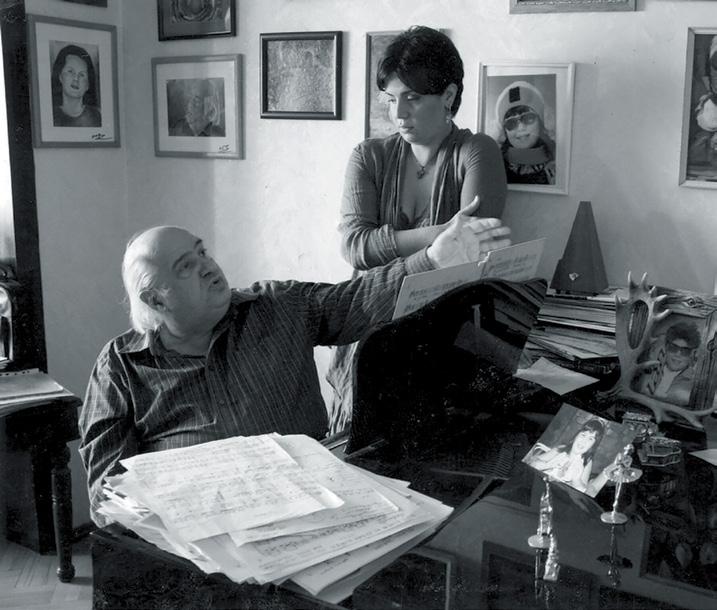
kamerul musikaSi gamgrZelebeli xar~-o. marTlac Zalian bevri maqvs dawerili kameruli musikisTvis. Cems baletSic ki momca rCeva erT-erT scenaze, ZiZias scenaa iq, cota gaadideo. aseve Cems baletze, aleqsandre SaverzaSvilma miTxra, ro „me aq gundi mesmis~-o da oTx adgilas Cavsvi gundi. warmoidgineT scena, roca xevisberi klavs Svils da am dros, zemodan, iarusidan mReris gundi, iseTi scena iyo, rom SegZravdaT, gundis gareSe aseTi mZafri SesaZlebelia ar yofiliyo. ai, aseTi kargi rCevebi miviRe Cemi ufrosi kolegebisgan, romelsac me yovelTvis viTvaliswinebdi. aseve minda gavixseno giorgi cabaZe, romelic musikaluri xelmZRvaneli iyo roca filarmoniaSi mivedi da ase Tqva -„niWieri biWi movida"-o,
jubilee concert for me in Batumi, it was an extraordinary night. There was also a concert at the main hall of the Tbilisi Conservatoire by the ‘Georgian Sinfonietta’, and I like its interpretation so much that I listen to it often. I would like to thank the Sinfonietta for that.
– How would you remember your relationship with the older generation of composers, did you listen to their advice?
I was feeling much kindness from other composers. Sulkhan Tsintsadze really liked me and he once told me – “You will be the one to continue writing good chamber music”. And I did write a lot of chamber music. He even advised me to lengthen a scene of my ballet a bit. Aleksandre Shaverzashvili told me about my ballet – “I’m hearing a choir here”, so I put a choir in four places of the ballet. Imagine the scene where the elder kills his son, and at that time, from above, a
agreTve vmegobrobdi biZina kvernaZesTan, sulxan nasiZesTan, TiTqmis yvelasTan da isinic Zalian miwyobdnen xels.
_ Tu gaqvT axla urTierToba axalgazrda kompozitorebTan da ras urCevdiT maT?
_ diax, ra Tqma unda maqvs da xSirad modian sxvadasxva sakiTxisTvis, me ki aqedan yvelas vurCev - Sromas, Sromas da kidev Sromas!
_ batono vaJa, Tqven yvela Taobis adamians uyvarxarT da Zalian popularuli xarT. rogor fiqrobT, ram mogitanaT es popularoba?
_ simRerebma, cxadia. marTalia, aseve iyo Celos koncerti, romlmac didi warmateba momitana da Zalian bevrs axlac moswons, magram es ufro inteleqtualuri musikaa. ai, farTo msmenelebSi popularoba, mainc simRerebis damsaxurebaa. quCaSi roca mivdivar, xalxi mxvdeba da qali iqneba Tu kaci, mesalmeba, mexveva, mkocnis. cxviraweuli kaci ar var, rasac akeTeb, SenTvis akeTeb, sxvas ratom unda auwio cxviri. sxvaTaSoris, yvela
choir is singing. It was a very moving scene, and I think it wouldn’t have been the same without the choir. So I got really good advice from my older colleagues, and I was always taking them into account. I also would like to mention Giorgi Tsabadze, who was the musical director when I entered the Philharmonic Orchestra, and who said about me that “a talented boy had arrived”. I was also friends with Bidzina Kvernadze, Sulkhan Nasidze, almost everybody, and they were all helping me a lot.
– Do you know young composers now? Would you give them some piece of advice?
– Of course, I know many of them, and they often come visit me for various reasons. My piece of advice is the same for all – work, work, and work!
– Mr. Vazha, you are loved by people of all generations, and you are very popular. What do you think brought you this popularity?
– Songs, naturally. There was also my Concerto for Cello, which was very successful and which many people still like, but it is a more “intellectual” music. Popularity among wider audiences clearly comes from my songs. When I walk in the streets and meet people, be they

niWieri kaci Tavmdabalia (icinis).
_ popularuli simRerebidan „dinamo~ aucileblad unda vaxsenoT da Tu SeiZleba, rom mogviyveT rogor daiwera. fexburTis didi moyvaruli var. hoda, Cvenebma, 3:0 mouges erevnis „ararats~, raRa damaZinebda, iqve melodia davwere, moris focxiSvils davureke da morisma leqsi dawera, mere ki „iveriam~ Cawera. Caweris dros morisic iq myavda da kvaSalma rom daiwyo SeZaxili „di-na-mo~, Cven es iq teqstSi ar gvqonda, hoda, morismac „au, kargia~-o da ase Cajda simReraSi. ai, asec xdeba, „iverielebic~ aseve amboben, rom Caweris dros, iqve daibada yvelaferi.
_ axla uyurebT fexburTs?
_ vuyureb, ki. fexburTi da me ganuyofeli nawili varT. _ axlac dawerdiT gamarjvebisTvis axal simReras, Tu is emocia sul sxva iyo?
_ axali ar gamova, radgan rac ar unda kargi iyos, ityvian, „dinamo~ rom dawera is jobiao, egra ar aris? sxvaTa Soris, ragbizec maqvs dawerili, quTaisis torpedozec. mesxi ki var warmoSobiT, magram deda myavda guruli da guriis fexburTis gundzec davwere simRera (icinis).
men or women, they greet me, hug me, kiss me. I’m not a scornful person, what you do, you do it for yourself, why should you be scornful to someone else? By the way, every talented person is modest (laughs).
– From popular songs, we have to mention ‘Dinamo’. Could you tell us how you composed it?
I’m a big fan of football. When our team won 3:0 against Erevan’s ‘Ararat’, I couldn’t sleep, I wrote a melody right then, I called Moris Potskhishvili and Moris wrote a poem, then ‘Iveria’ recorded it. When recording the song, Moris was there too, and when Kvashali started shouting “Di-na-mo”, it wasn’t in the text, and Morris shouted that it was very good, and it stayed in the song. That’s how it goes, ‘Iveria’ also says that everything is created when recording.
– Do you still watch football?
– I do. Football and I are inseparable.
– Would you compose a new song for a victory, or was the emotion of the time incomparable?
– There couldn’t be a new one, because as good as it might be, they would say that “Dinamo” is better, right? By the way, I also wrote one on Rugby, and on Kutaisi Torpedo. I am originally from the region of Meskheti, but my mother was from Guria and I also wrote a song about the Gurian football team (laughs).

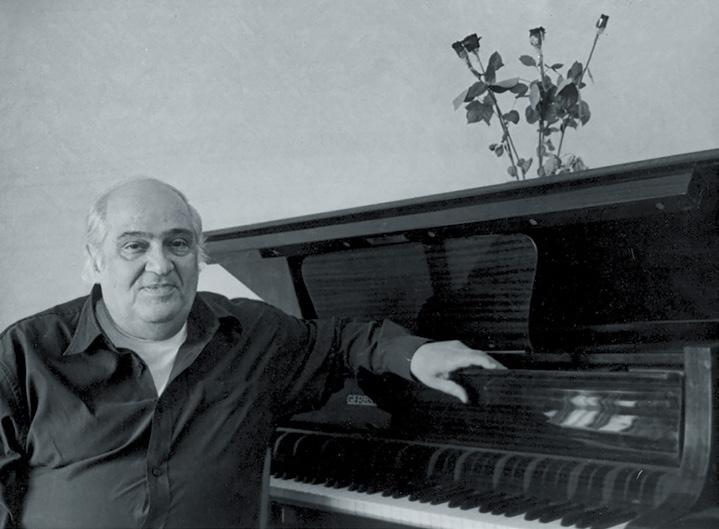
_ axla raze muSaobT, werT raime axals?
_ am wuTas ufro redaqciebs vakeTeb. axla vnaxe simRerebi romlebic ar gamomicia. gadavxede, raRacebi Sevaswore da axla gamovcem simRerebis ukve me-6 toms, 5 ukve maqvs. sxvadasxva poetis leqsebzea dawerili, Cemi meuRlis, manana danganic aris iq. _ aris rame, rac gindaT, rom aucileblad gaakeToT?
_ iciT ra, opera minda davwero, Zalian mizidavs, Zalian da ufro kamerul operaze mefiqreba. axla, jer Temaze vfiqrob, Tema unda iyos Zalian saintereso, Zalian minda davwero opera.
Cveni saubari operis daweris surviliT dasrulda da samwuxarod, survili ausrulebeli, xolo opera dauwereli darCa. samagierod, dagvitova Tavisi mravalferovani da didi musikaluri Semoqmedeba, uamravi simRera, romelsac yovelTvis imRereben saqarTveloSi da rac mTavaria, dagvitova didi siyvaruli! is, aq aris...
– What are you working on right now, are you composing something new?
– At the moment, I am mostly doing revisions. I just found some songs that I never published. I looked at them, corrected some parts, and I will soon be publishing my sixth tome of songs. It was written according to the poems of various poets, including my wife Manana Dangadze.
– Is there something you want to achieve more than anything else?
– You know what, I would like to write an opera, I am really drawn to that, and I’m thinking more of a chamber opera. I’m now thinking of the theme, it has to be a very interesting one, I really want to write an opera.
Our conversation ended with the wish to write an opera and unfortunately, it couldn’t be realized. On the other hand, he left us his diverse and brilliant musical compositions, numerous songs, which will be sung in Georgia forever, and most importantly, he left us immense love!
He’s out there!...
daviT da nodar andRulaZeebi evropuli identobis Ziebis erT-erTi gza...
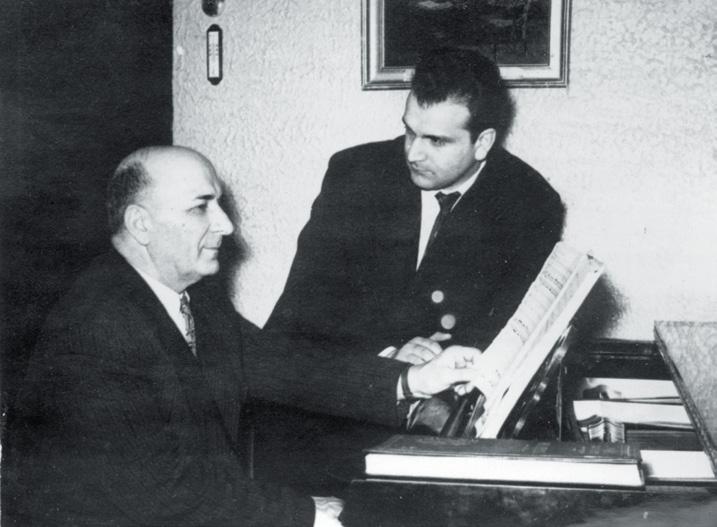
Cveni istoriis ukanaskneli periodis didi monakveTi evropul wiaRSi dabrunebis farul Tu Ria mcdelobas ukavSirdeba. mecnierebisa da xelovnebis sxvadasxva dargebis warmomadgeneli calkeuli porovnebebi Tu didi jgufebi sakuTari moRvaweobiT TviT yvelaze rTul drosac ki uxilavad abamdnen Zafebs mSobliur evropasTan. isini Tavisi cxovrebiT gverds ubamdnen evropul Rirebulebebs, romlebic daxurul kars miRma,
A large part of the latter period of our history is related to the covert or open attempt to return at the heart of Europe. Even during the hardest times, representatives of various fields of science and art, be they separate individuals or large groups, would invisibly build ties with their native Europe. With their way of life, they would support European values, which would develop in us behind closed doors, despite many hardships. Many of them would sacrifice their lives to retain European humanism and progress, even in the utterly
bevri sirTulis miuxedavad, mainc viTrdeboda CvenSi. bevri maTgani evropuli humnizmis SenarCunebisa da ganviTarebisTvis, TviT yelaze araevropul sivrceSic ki, sakuTari sicocxlis fasad ibrZoda. qarTuli kultura araerT aseT magaliTs icnobs. sabWoTa reJimis daSlis Semdeg bevri evropuli Rirebulebis Tvidan gasisxlxorcebis da cxovrebis wesad gadaqcevis sirTulis winaSe davdeqiT. amisda miuxedavad, swored zemoxsenebul adaminTa wyalobiT, damoukidebeli saqarTvelo sabWoTa kavSirsa da evropas Soris gaucxoebis pirobebSi arsebuli ufskrulis im mxares aRmoCnda, sadac evropaa. Cvenda sabendierod, aseTi adamianebi Zalian mravlad arian, magram Cveni interesis veqtori amJamad mimarTulia qarTuli saopero xelovnebisaken da am sferos gamorCeuli warmomadgenlebisken. daviT da nodar andRulaZeebi, aramarto TavianTi SemoqmedebiT Tu pedagogiuri moRvaweobiT, aramed xSirad sakuTari sicocxlis fasadac ki icavdnen qarTul saopero xelvnebas, rogorc evropuli operis ganuyofel nawils. tenorebi daviT da nodar andRulaZeebi qarTuli saopero musikis istoriis yvelaze TvalsaCino warmomadgenlebi arian rogorc unikaluri saSemsruleblo, ise pedagogiuri da samecniero moRvaweobiT. maT mTeli arseba miuZRvnes qarTuli tradiciuli sasimRero memkvidreobis Serwymas evropul (italiur) saopero skolasTan sasceno dramaturgiis didi reformatoris, konstantin stanislavskisa da qarTuli erovnuli Teatris principebis gamoyenebiT. andRulaZeebi qarTuli vokaluri musikis istoriaSi gamorCeulni arian ara marto unikaluri sasimRero monacemebiT, sanimuSo vokaluri teqnikiT, didi scenuri SesaZleblobebiTa da ostatobiT, aramed isini gaxlavan qarTuli andRulaZiseuli vokaluri skolis Semqmnelebi, skolisa, romlis warmatebebs vimkiT ukve naxevar saukuneze metia, rogorc erovnuli, ise msoflio masStabiT.
aRsaniSnavia, rom andRulaZeebis artistul mimzidvelobasa da damajereblobas axlavs saocari Sinagani aristokratizmi da TavdaWeriloba. maT axasiaTebT natifi gemovneba, stilis zedmiwevniT SegrZneba da evropuli esTetikis erTguleba erovnuli maxasiaTeblebis gaTvaliswinebiT. swored amitom, andRulaZeebis mier Seqmnili dauviwyari vokalur-sasceno saxeebi Tu Sesrulebuli kameruli musikis Sedevrebi Zalian farTo speqtriT gamoirCeva. maTi Semoqmedeba momavali TaobebisaTvis aris etaloni qarTuli musikaluri niWis italiuri „belkantoTi~ amRerebisa. andRulaZeebma didi Semoqmedeba udidesi pedagogiuri moRvaweobiT daagvirgvines da sruliad damsaxurebulad daimkvidres adgili qarTuli saopero xelovnebis mwvervalze. maT TavianTi moRvaweobiT

non-European space that was the Soviet Union. There are many such examples to be found in the history Georgian culture.
After the collapse of the soviet regime, we found ourselves facing the difficulty of reintroducing many European values and turning them into ways of life. Despite that fact, and precisely thanks to the abovementioned individuals or groups, in the abyss that formed between the Soviet Union and Europe, independent Georgia found itself on the side of Europe. Fortunately for us, there are many such people, but in this article, we will focus on Georgian opera and two of its distinguished representatives. David and Nodar Andguladze were defending Georgian opera art as an intrinsic part of European opera, not only through their work as artists or teachers, but also sometimes by risking their very lives.
Tenors David and Nodar Andguladze are the most eminent representatives in the history of Georgian opera music, both in terms of their unique performing skills and their careers as educators. They dedicated their whole lives to merging Georgian traditional singing heritage to the European (Italian) opera school through the use of principles taken from the Georgian national theater and from the great reformer of scenic dramaturgy, Konstantin Stanislavski. The Andguladzes stand out in the history of Georgian vocal music not only because of their unique singing ability, exemplary vocal
umdidresi saganZuri dagvitoves, romelic qarTul vokalur xelovnebas saukuneze metia asazrdoebs. rac mniSvnelovania, andRulaZeebma SeZles, umdidresi da umniSvnelovanesi codna gadaecaT momavali TaobebisaTvis ise, rom yoveli Semdgomi Taobis skolis warmomadgenlebic ki zedmiwevniT mihyvebian maTi skolis mTavar postulatebs. is ki ivseba axali gamocdilebebiT, mdidrdeba da ufro maRal mwvervalebs ipyrobs. skolis sistema Zalian fundamenturia, magram, imavdroulad, SesaniSnavad adaptirdeba TaobaTa mier Semotanil siaxleebTan, Tumca arasodes kargavs andRulaZiseuli skolis pirvandel saxes. mama-Svilma andRulaZeebma, rogorc italiuri „belkantos~ erTgulma, magram, amasTanave, progressa da siaxles mowyurebulma Semoqmedebma, Seqmnes iseTi skola, romelic ar kargavs fesvebTan kavSirs, Tumca, yovelTvis itovebs sivrces axali gamocdilebisa da drois mier motanili siaxleebisTvis. swored amitom, andRulaZeebis didi Tavdadebisa da pirdapiri Tu iribi pedagogiuri moRvaweobis wyalobiT qarTul da msoflio scenebze saukuneze metia brwyinaven didi saxelebi...

technique, great scenic prowess and mastery, but also because they are the founders of the Georgian Andguladze vocal school, one whose successes we have been witnessing for more than half a century, both on a national and worldwide scale.
It is worth noting that the artistic appeal and significance of the Andguladzes is accompanied by an internal aristocratism and self-restraint. They are characterized by refined taste, a diligent understanding of style, and a loyalty towards European aesthetics, all the while taking into account national attributes. This is precisely why the unforgettable vocal and scenic character created and the chamber music orchestras performed by the Andguladzes stand out with their very wide spectrum. Their works are models of Georgian talent singing Italian bel canto for the next generations.
The Andguladzes crowned their great careers by educational work, and they deservedly established their place at the summit of Georgian opera art. They left us an immense treasure with their accomplishments, which has been nourishing Georgian vocal art for more than a century. Importantly, the Andguladzes managed to transmit invaluable knowledge to the next generations in a way that made even the next generations of schools follow their main principles. And they get full of new experience, and reach new summits. And their educational methods get full of new experience, richer, and reach new summits.
Their school system is very fundamental, but at the same time, perfectly adapts to the novelties brought by new generations, although never losing the original aspect of the Andguladze school. The father and son, both loyal admirers of Italian bel canto, but at the same time, both thirsty of progress and novelty, have created a school that doesn’t lose ties to its roots, but always leaves space for new experiences and ideas brought about by time. This is precisely why, thanks to the direct or indirect pedagogical work done by the Andguladzes, great names have been shining on the stages of Georgia and the world for over a century…
David and Nodar Adnhuladze established themselves as the perpetuators of the bel canto traditions in the Georgian opera art, and sometimes even as its founders. They showed great professional responsibility, which both artists felt and internalized. They played an invaluable role in the final steps of the establishment of the Georgian vocal school as an independent institute, both in artistic, educational, and scientific aspects. They dedicated their lives to this great national endeavor.
Through their scenic as well as educational work, the Andguladze managed to make their voices heard even in the European opera field, despite living in a secluded political entity. And when the borders opened, the Georgian vocal school turned out to be in line with the European school, and the singing language of the singers from Georgia was understandable and acceptable to European ears. Despite the crevices in the political and everyday life matters between Europe and Georgia, they managed to give the bass line, literally or metaphorically, to the European opera culture from a small Caucasian country. This is precisely the reason why, after the borders opened, a
daviT da nodar andRulaZeebi gvevlinebian qarTul saopero xelovnebaSi „belkantos~ tradiciebis ganmamtkiceblebad, xolo zogierT SemTxvevaSi – damfuZneblebadac. didia maTi profesiuli pasuxismgebloba, rasac orive xelovani grZnobda da iTavisebda. isini qarTuli vokaluri skolis, rogorc damoukidebeli institutis, saboloo CamoyalibebaSi udides rols asruleben SemoqmedebiTi, pedagogiuri moRvaweobiTa Tu samecniero kvlevebiT. maT cxovreba miuZRvnes am did erovnul saqmes.
andRulaZeebi Tavisi rogorc sasceno, ise pedagogiuri moRvaweobiT sruliad CarCoebSi moqceul garemoSi axerxebdnen, xma miewvdinaT evropuli saopero samyarosaTvis. xolo roca sazRvrebi CamoiSala, qarTuli vokaluri skola aRmoCnda srul TanaxvedraSi evropul skolasTan da saqarTvelodan Casuli momRerlebis sasimRero ena gasagebi da misaRebi gaxda evropeli msmenilisTvis. evropasa da saqarTvelos Soris arsebuli politikur-sayofacxovrebo napralis miuxedavad, maT moaxerxes, kavkasiis patara qveynidan, pirdapiri Tu iribi gagebiT, bani miecaT evropuli saopero kulturisaTvis. swored amitom, sazRvrebis gaxsnis Semdeg evropisken


large army of Georgian singers moving to Europe has harmonically conquered European stages, academies (both as students and professors), or competitions.
To this day, the world is in awe at the dazzling success of contemporary Georgian singers, which is directly connected to the Adguladzes’ vocal school. I am also part of this phenomenon – I was raised in the Andguladze school. My great wish is to focus more attention towards these people, not so much because the Andguladzes dedicated their lives for a national cause, but because we, the next generations – both musicians or ordinary citizens, need it.
The founder of this school, David Andguladze, is one of the first actor-singer. He encompasses many components: vocal skills, musicality and artistry, and a school characterized by both European and national traditions – including in theater.
David Andguladze was born in Bakhvi, a small village of Guria that boasts great musical traditions. His “golden voice” was first heard there. David Andguladze’s outstanding vocal and artistic talent, despite his difficult life experience, was catalyzed when Vano Sarajishvili got to hear him. This is how the young boy from Bakhvi opened the doors to the world of opera music; his talent became a

daZruli qarTveli momRerlebis didma armiam sruliad harmoiniulad daipyro evropuli scenebi, akademiebi (rogorc studentebis, ise profesorebis saxiT) Tu konkursebi.
msoflio dRemde gaocebulia Tanamedrove qarTvel momReralTa Tavbrudamxvevi warmatebebiT, rac pirdapir ukavSirdeba andRulaZeebis vokalur skolas. Tavad mec xom am fenomenis nawili var – andRulaZeebis skolis aRzrdili. Cemi didi survilia, am adamianebis mimarT meti yuradRebis mipyroba, rac ara imdenad erovnul saqmeSi daRalul andRulaZeebs, aramed Cven momaval Taobebs _ rogorc musikosebs, ise ubralo moqalaqeebs _ esoden gvWirdeba.
am skolis fuZemdebeli daviT andRulaZe erTerTi pirveli msaxiobi-momReralia. masSi Tavs iyris araerTi komponenti: vokaluri monacemi, musikaluroba da artistizmi, evropuli da erovnuli tradiciebiT gamorCeuli skola, maT Soris _ Teatraluri.
daviT andRulaZe guriis patara, magram didi musikaluri tradiciebis mqone sofel baxvSi daibada. misi „oqros xma“ pirvelad am garemoSi gaisma. daviT andRulaZis araordinarul saxmo da artistul monacemebs, miuxedavad mZime cxovrebiseuli gamocdilebisa, biZgi vano sarajiSvilis mosmenam misca. ase SeaRo baxvelma ymawvilma saopero musikis samyaros kari; misi talanti TviT kote marjaniSvilisa da stanislavskis interesebis obieqtad iqca.
daviT andRulaZis xelovneba XX saukunis 20-ian wlebSi daixvewa, italiuri skolis tradiciebze dayrdnobiT (prof. evgeni vronski) da konstantin stanislavskisTan muSaobiT, romelic Seavso qarTuli Teatris korifeebTan _ e.w. „МXАТ”-el kote marjaniSvilTan, aleqsandre wuwunavasTan, akaki faRavasTan da gansakuTrebiT _ sandro axmetelTan mWidro SemoqmedebiTma kavSirma. swored evropuli vokaluri skoliTa da stanislavskisa Tu qarTvel reJisorebTan muSaobis gamocdilebiT
subject of interest to even Kote Marjanishvili and Stanislavski. David Andguladze’s art got refined in the 1920s, basing itself on traditions of the Italian school (under professor Evgeni Vronski) and through the work of Konstantin Stanislavski, and was enriched by his close artistic union with leading figures of Georgian theater – Kote Marjanishvili, Aleksandre Tsutusnava, Akaki Paghava, and Sandro Akhmeteli in particular.
It is precisely thanks to the experience of the European vocal school and of working with Stanislavski or Georgian directors that Andguladze’s talent gave Moscow’s Bolshoi Theater the opportunity to stage a difficult opera such as Giacomo Meyerbeer’s ‘Les Huguenots’ for the first time – in which the experienced rider would enter the stage on a horse. David Andguladze would successfully perform on Russia’s leading stages, but the Georgian tenor would deliberately come back to his homeland, where he starts to perform on a national level. He triumphantly performed all the important tenor parts of classic opera, and acquired great admiration from Georgian listeners. He took part in numerous innovative performances staged in Georgia. Particularly worth noting is Sandro Akhmeteli’s ‘Pagliacci’, which is considered a staple of dramaturgy. Together with Georgian directors and the singers of the time, Andguladze tries to merge European and Georgian traditions, which

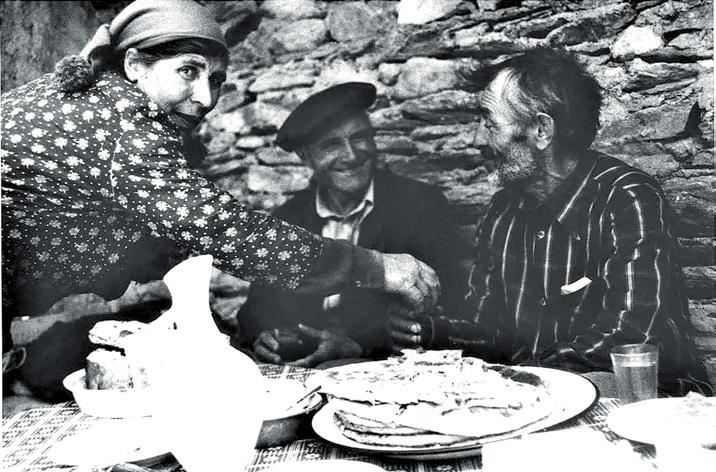
gamyarebulma andRulaZiseulma talantma misca moskovis „did Teatrs“ saSualeba, daviT andRulaZis monawileobiT pirvelad daedga iseTi rTuli opera, rogoricaa jakomo meierberis „hugenotebi“, romelSic gamocdili kavaleristi cxeniT SemoiWreboda xolme scenaze. daviT andRulaZe didi warmatebiT gamodioda ruseTis wamyvan scenebze, magram qarTveli tenori sruliad Segnebulad brundeba samSobloSi, sadac udidesi codniT iwyebs samamulo scenaze moRvaweobas. man didi warmatebiT Seasrula dramtuli tenoris yvela mniSvnelovani partia da qarTveli msmenelis didi siyvaruli daimsaxura. is iyo monawile Cvens scenaze ganxorcielebuli araerTi novatoruli dadgmisa. xazgasmiT unda gamovyoT sandro axmetelis „jambazebi“, romelic qarTul Tu msoflio dramaturgiaSi saetapo movlenad iTvleba. andRulaZe qarTvel reJisorebTan da maSin moRvawe momRerlebTan erTad cdilobs, qarTuli saopero xelovneba evropulis mxardamxar sakuTari mxrebiT ataros, rasac Semdeg ukve aseve didi warmatebiT axerxebs pedagogis ampluaSic. daviT andRulaZis pedagogiuri moRvaweobis erT-erTi warmateba _ missive vaJi, nodar andRulaZea, romelmac, Tavdapirvelad universitetSi, enaTmecnierebis ganxriT daiwyo swavla... Tumca, momavalSi, misi arCevani mainc
he will afterwards also manage successfully as a pedagogue. One of the successes of David Andguladze’s work as a pedagogue is his own son, Nodar Andguladze, who first started studying at the university, in the department of linguistics… But as time passed, he made the decision to study opera, and his scientific experience became the distinctive trait of young Nodar’s unique singing.
Nodar Andguladze’s travel to Italy is the corroboration of the fact that the Andguladze vocal school is directly linked to Italian traditions: his singing at the 1958 arts festival was perceived by European listeners to be their own and not a foreign one, they felt a connection to his singing style. And this is precisely how it was decided to send the singer in Italy. Nodar Andguladze traveled to the La Scala theater for two years. Interestingly, this story is also linked to Belgian Queen Elisabeth, who listened to Nodar Andguladze in Moscow and could not believe that he was not Italian, or that he didn’t, at least, get his education in Italy.
Nodar Andguladze studying in Italy under maestro Barra was probably the logical continuation of the work he had been diligently pursuing thanks to his father in Georgia. He had perfectly mastered the vocal breathing principles of the Italian school. Barra would speak in awe of Nodar’s refined transitional registers and his utterly perfect so-called “closing” technique.
It is worth noting that Nodar Andguladze, as a linguist and a
operas dauakvSirda da es samecniero gamocdileba axalgazrda nodaris unikalobis mTavari niSani gaxda. nodar andRulaZis italiaSi gamgzavreba swored imisi dasturia, rom andRulaZeebis vokaluri skola pirdapir ukavSirdeba italiurs: 1958 wlis dekadaze misi simRera evropelma stumrebma aRiqves rogorc mSobliuri da ara ucxo, igrZnes mis sasimRero manerasTan mWidro naTesauri kavSiri. swored amis Sedegad gadawyda qarTveli momRerlis italiaSi gagzavna. nodar andRulaZe orwlian staJirebaze „la skalas“ TeatrSi gaemgzavra. sainteresoa, rom es istoria aseve ukavSirdeba belgiis dedofal elisabeds, romelmac moskovSi moismina nodar andRulaZe da ver daijera, rom is ar iyo italieli, an Tundac italiaSi ganaTleba moRebuli. nodar andRulaZis italiaSi maestro barasTan swavla, albaT logikuri gagrZeleba iyo im Sromisa, romelsac igi mamis damsaxurebiT, SromismoyvareobiTa da inteleqtualuri midgomiT eweoda. mas absoluturad sworad hqonda SeTvisebuli vokaluri sunTqvis gamoyenebis is principebi, romlebsac misdevs italiuri skola. bara aRfrTovanebiT saubrobda, rogori mowesrigebuli gardamavali registrebi hqonda da saukeTeso e.w. „moxurvis“ teqnikas flobda. aRsaniSnavia, rom nodar anRulaZe, rogorc enaTmecnieri da evropuli ganTlebis mqone musikosi, ver egueboda italiuri saopero partiebis rusul enaze Sesrulebas da moiTxovda saopero dadgmebis original enaze aJRerebas. daviT da nodar andRulaZeebi cxovrebiTa da SemoqmedebiT emsaxurebodnen qarTuli vokaluri skolis tradiciebis gagrZelebasa da ganviTarebas... andRulaZeebis skolis didi damsaxurebaa, rom momRerlebi dResac uwyvet nakadad miemgzavrebian saqarTvelodan msoflio scenebis dasapyrobad. xolo maSin, roca saqarTvelo metad Tu naklebad ruseTis CrdilSi iyo moqceuli, msoflio saopero wreebi cxadad amCnevdnen qarTuli vokaluri skolis sabWoTa kavSiris sxva warmomadgenelTagan gansxvavebas. rogorc politikuri TvalsazrisiT miviCnevT Tavs evropuli ojaxis damsaxurebul warmomadgenlebad, ise Cveni saopero skola pirdapiraa dakavSirebuli im qveyanasTan, sadac dairwa operis akvani. evropuli kultura Tavad grZnobs da amoikiTxavs gasageb enaze miwodebul vokalur informacias, radgan, rogorc saqarTvelo, ise Cveni kultura, xelovneba Tu misi iseTi dargi, rogoricaa opera, saqarTveloSi evropidan „pirdapiri reisiT“ Camovida. andRulaZeebis Tavdadeba emsaxureba erovnuli sasimRero monacemebis evropuli skolis arealSi ganviTarebas da avTenturi qarTuli saopero Janris damkvidrebas, romelic evropuli saopero xelovnebis despania Cvens regionSi. am statiiT, romelic emyareba Cems sadisertacio
musician educated in Europe, couldn’t accept the idea of singing Italian opera parts in Russian, and would always demand to perform the operas in their original languages.
Through their lives and works, David and Nodar Andguladze were serving the continuation and development of the Georgian vocal school traditions… It is thanks to the Andguladze school that to this day, singers from Georgia constantly travel the world and conquer its most prominent stages. And even when Georgia was more or less in the shadow of Russia, foreign opera circles could clearly distinguish the Georgian vocal school from those of other soviet states. Just as we see ourselves as a worthy representative of the European family from a political point of view, our opera school is directly linked to the country where the cradle of opera was built.
European culture itself feels and will grasp vocal information provided in a language that will be understandable, as just like Georgia, our culture, art, or one of its fields such as opera, has arrived to Georgia from Europe by “direct flight”. The zealousness of the Andguladzes serves the development of our national singing abilities

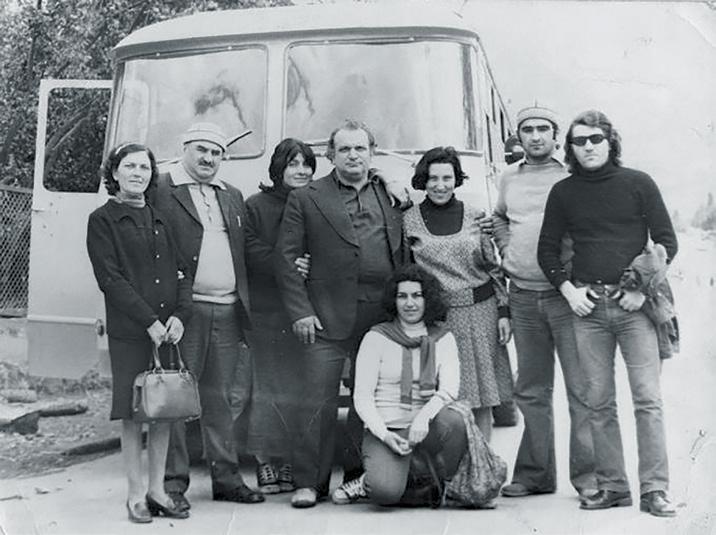
naSroms „daviT da nodar andRulaZeebis vokaluri skolis roli qarTul saopero xelovnebaSi“ (samecniero xelmZRvanelebi Tbilisis konservatoriis asocirebuli profesori nino Jvania da profesori guliko kariauli) vecade, rom kidev erTxel gamexsenebina daviT da nodar andRulaZeebis Rvawli rogorc qarTuli xelovnebis, ise saqarTvelos evropul ojaxSi dabrunebis, Cveni evropuli identobis Ziebis saqmeSi. vfiqrob, rom swored msgavsma pirovnebebma TavianTi cxovrebiT, Cveni yvela gansacdelis miuxedavad, ar mogvces ufleba, dagveviwyebina, „visi gorisa“ varT da sadaa Cveni istoriuli kera... qarTuli saopero xelovnebis SemTxvevaSi SegviZlia naTlad davinaxoT, rogor ar kargavda es dargi andRulaZeebis Tu maTi skolis sxva sasaxelo warmomadgenlebis meSveobiT genetikur kavSirs evropasTan. imis miuxedavad, rom kavSirebi mWidro iyo aseve Cvens Crdiloel mezobel qveyanasTan, iqidan miRebul siaxleebs Cven vfiltravdiT da maT evropul nawils viTvisebdiT, radgan am siaxleebSi xSirad sul sxva Sinaarsi iyo SefuTuli.
from a European perspective, as well as the establishment of an authentic Georgian opera genre, which is the emissary of European opera art in our region.
With this article, which is based on my thesis ‘The role of David and Nodar Andguladze’s vocal school in Georgian opera art” (scientific supervisors: associate professor of the Conservatoire Nino Zhvania and professor Guliko Kariauli), I have attempted to once again remind the achievements of David and Nodar Andguladze in the work towards the development of Georgian art forms, as well as towards the return of Georgia in Europe, and the search for our European identity. I think that it is precisely such people who managed to not let us forget who we are and where our historical hearth belongs, despite all our hardships… In the case of Georgian opera art, we can clearly see how this field wasn’t losing its genetic union with Europe thanks to the Andguladzes, their school, or representatives of the latter. Despite the fact that there were also strong ties with our northern neighbor, we were filtering the innovations coming from there, and only welcoming their European parts, as they often covered completely different principles.

pirveli radiodadgma eTerSi 1930 wels Cikagos radioSi _ WGN _ gavida. es iyo absoluturad axleburi tipis 15-wuTiani yoveldRiuri SuadRis gadacema saxelwodebiT `feradi sizmrebi~, romelic irlandiel-amerikeli qvrivi qalisa da misi gauTxovari Svilis istorias mogviTxrobda. am dadgmis avtorma, yofilma maswavlebelma, irna filipsma, SemdgomSi sxva mravali gaxmaurebuli Sou Seqmna. serialis TxrobiTi manera STagonebuli iyo im dros Zalian popularuli komediuri dadgmidan _ Amos ‘n’ Andy _ romelic Cikagoel SavkanianTa cxovrebas asaxavda. radios `sapnis opera~ nel-nela Zalas ikrebda da 1937 wlisTvis TiTqmis yvela radiosadguris `damrtymel~ Zalad iqca. ukve 1948 wels aTi yvelaze maRalreitinguli dRis gadacemidan aTive radiodadgma aRmoCnda da ajoba
The first radio play was broadcast in 1930 at the WGN station in Chicago. It was “Painted Dreams”, a daily daytime soap opera of a completely new genre, which told the story of an Irish-American widow and her unmarried daughter. The author of the show, former teacher Irna Phillips, created many successful shows after that. The narrative style of the show was inspired by a comedy that was very popular back then, ‘Amos ‘n’ Andy’, which depicted the lives of African Americans in Chicago. The radio’s soap opera sector gradually became stronger, and in 1937, it became the trump card of almost every radio station. In 1948, the ten most popular daytime programs were all radio shows, beating almost all other formerly famous genres.
On the 13th of January 2024, Georgian radio theater returned with a premiere to radio waves, and thus celebrated 70 years since
manamde cnobil TiTqmis yvela gadacemas. 2024 wlis 13 ianvars, qarTuli radioTeatri premieriT daubrunda radioeTers da daarsebidan 70 wlis Tavi izeima, Tumca mediaJanris formireba, faqtobrivad, qarTuli radios dabadebasTan erTad daiwyo (1925 w.). pirveli radiotranslaciidan, romelic Tbilisis operisa da baletis saxelmwifo Teatridan eleqtromeqanikuri qarxnis muSaTa klubSi moewyo, male erTi saukune gava. firze Semonaxuli erT-erTi pirveli radiospeqtakli (aleqsandre yazbegis „moZRvari“) saqarTveloSi 1953 wels givi saginaSvilis reJisorobiT daidga, xmis reJisori iakob boboxiZe gaxldaT. sasceno dadgmisgan gansxvavebiT, radiospeqtakli ugrimod, ukostiumod TamaSdeboda, rekvizitisa da dekoraciis gareSe. gadamwyveti mniSvneloba msaxiobis xmas eniWeboda. akustikurma sivrcem da damxmare xmaurebma mogvianebiT SeiZines datvirTva, rac teqnikurma ganviTarebam ganapiroba. saopero da Tetraluri dadgmebi ukve 30-iani wlebidan gadaicemoda radios pirdapir eTerSi da radioeTeris yovelkvireul programaSi xvdeboda. damatebiT radiostudiaSi piesebis nawyvetebi zogjer monologis
its creation, although the formation of this media genre practically started with the birth of Georgian radio itself (1925). A century will soon have passed since the first radio broadcast, which was aired from the Electromechanic Factory Workers’ Club of the Tbilisi Opera and Ballet State Theater.
One of the first radio plays of which the recording has been preserved (Aleksandre Kazbegi’s ‘The Confessor’), was directed by Givi Saginashvili in Tbilisi in 1953, with Iakob Bobokhidze as the sound engineer. At the difference of the stage play, the radio show was played without makeup, without costumes, props, or decorations. The voices of the actors were the most important parts. The acoustic space and audio effects have appeared later, with technical progress. Opera and theater shows were broadcast live in radios from the 1930s, and were present in radio programs every week. In additional radio studios, some plays’ excerpts were sometimes staged as monologues, influenced by the art of declamation and bending towards the aesthetics of literary theater, which was also called ‘literary reading’. In the same years, there was also a section called “Theater on the microphone”. The show had an announcer who was commenting on the environment of the play, the costumes of the characters,
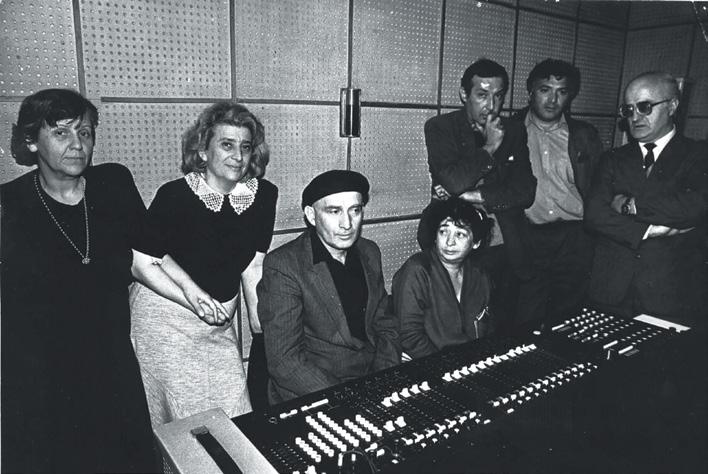
saxiTac idgmeboda, deklamaciuri xelovnebis zegavlenas ganicdida da literaturuli Teatris esTetikisken ixreboda, romelsac `literaturul kiTxvasac~ eZaxdnen. imave wlebSi arsebobda rubrika `Teatri mikrofonTan~. speqtakls diqtori uZRveboda, romelic msmenels moqmedebis garemos, gmirebis Cacmulobas acnobda. qarTveli msmenelisTvis `Teatri mikrofonTan~ sayvarel TavSesaqcevad iqca, rac saintereso siuJetebisa Tu TviTon radios specifikuri momxibvlelobis garda, dadgmebSi iseTi varskvlavebis monawileobamac ganapiroba, rogorebic iyvnen: veriko anjafariZe, sesilia TayaiSvili, erosi manjgalaZe da sxv. droTa ganmavlobaSi, radioTeatris dramaturgiaSi Tanamedrove literaturac aisaxa. mwerlebma TandaTan daiwyes radiopiesebis Txzva. gansakuTrebiT sainteresoa Tamaz WilaZis, guram doCanaSvilis, nugzar SataiZis nawarmoebebis mixedviT Seqmnili radiodadgmebi.
axali mediadargis gaCenam sazogadoebaSi didi interesi gamoiwvia. 1926 wels Tbilisis konservatoria, operisa da dramis Teatrebi da sxva sakoncerto darbazebi
and so on for the listeners. “Theater on the microphone” became a favorite among Georgian listeners, and it happened because apart from interesting themes or the intrinsic, specific charm of radio itself, the genre also included the participation of stars such as Veriko Anjaparidze, Cecilia Takaishvili, Erosi Manjgaladze, and others. With time, contemporary literature was also represented in radio theater dramaturgy. Writers gradually started to compose radio plays. The radio dramas based on the works of Tamaz Chiladze, Guram Dochanashvili, Nugzar Sataidze, are of particular significance.
The introduction of a new media genre has sparked much interest in society. In 1926, the Tbilisi Conservatoire, the Opera and Drama Theaters and other concert halls got equipped with broadcasting material and merged with radio stations. It became possible to listen to live broadcasts and plays without leaving one’s home. Radio theater quickly gathered loyal listeners. Former programs were often created for soviet propaganda and were depicting revolutionary and ideological themes. For instance, they thought it was necessary to stage Oleksandr Korniychuk’s play ‘The Death of the Squadron’ in every large city of the USSR. People working at the radio


satranslacio xazebiT aRiWurva da radiostudiasTan SeerTda. SesaZlebeli gaxada pirdapiri gadacema da speqtaklebis saxlidan gausvlelad mosmena. radioTeatrs maleve gamouCnda erTguli msmeneli. adreuli dadgmebi, xSirad, sabWoTa propagandisTvis iqmneboda da revoluciur-ideologiur Tematikas asaxavda. ase, magaliTisTvis, saWirod miaCndaT ssrk-s yvela did qalaqSi dadgmuliyo mwerlis aleqsandre korneiCukis piesa _ `eskadris daRupva~. radio redaqciis TanamSromlebi ixsenebdnen: `piesa ise SevamokleT, rom 50-55 wuTSi Cateuliyo, ise damRlelia. kargi iqneboda specialuri musikis SekveTa, Tumca amisaTvis saxsrebi ar gagvaCnda. kompozitorma Salva TaqTaqiSvilma SesaniSnavad gadawyvita musikaluri gaformebis amocana sabWoTa da klasikuri musikis nimuSebis gamoyenebiT~. mogvianebiT reJisori zurab kandelaki erT-erT interviuSi ixsenebs: `Janri radiopiesa gvian Semovida, amas hqonda garkveuli mizezebi, yvelaferi damokidebuli iyo cenzuraze. vinc vmuSaobdiT, gvqonda ufleba Cagvewera mxolod wignad gamocemuli an TeatrSi dadgmuli piesebi, radiopiesa ki specialurad iwereboda radio speqtaklisTvis, mas ar hqonda gavlili cenzura, amitomac “sicocxlis” uflebasac ar aZlevdnen~. radioTeatris safuZveli didi literaturaa. qarTveli mwerlebis nawarmoebebis radiokiTxvis miuxedavad, klasikuri memkvidreoba calmxrivad warmodgeboda,
remember: “We shortened the play in order to make it fit in 50-55 minutes, otherwise it’s too tiring. It would have been good to order specific music for the play, but we didn’t have the resources for that. Composer Shalva Taktakishvili made the remarkable decision to use both soviet and classical music genres to accompany the play”. Later, director Zurab Kandelaki remembers in an interview: “The genre of the radio play arrived late, which had its reasons, everything was depending on censorship. As we were working there, we had the


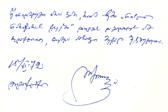
didwilad uaryofili iyo erovnuli suliskveTeba, radgan nacionaluri ganwyobebi SovinizmTan iyo gaigivebuli. aqcenti ZiriTadad socialuri xasiaTis problemebze keTdeboda... da amitom firebidan ama Tu im fragments iRebdnen xolme. Tumca audio damuSavebas saqarTveloSi didi da pozitiuri istoria hqonda da aqvs. dadgmebis montaJi, firebis xeliT damuSavebidan mis gacifrulebamde, 70 welze mets iTvlis. swored montaJi gaxda am media Janris saboloo formirebis safuZveli. `uxilav speqtaklebs~ meti msmeneli gauCnda. radioTeatrmac TandaTan SeiZina axali teqnikuri SesaZleblobebi. am procesSi didi roli audioteqnikis ganviTarebam Seasrula, magnitur firze Caweris damkvidrebam mravalarxiani fiqsaciiT. SesaZlebeli gaxda mravali dublis Cawera. audio Canaweris reproduqciis SesaZleblobam win wamowia iseTi sakiTxebi, rogoricaa radiospeqtaklis akustikuri nakadis sivrce, specialuri xmovani efeqtebi, xmaurebi da musikaluri gaformeba. 70iani wlebidan saqarTveloSi gamoCnda stereo Canawerebi. orarxiani teqnologiis damkvidrebasTan erTad axali datvirTva SeiZina scenis audio panoramulma inscenirebam. speqtaklis mosmenisas, msmenels SeeZlo marjvena da
right to record only the plays that had already been published as books or staged in theater, and radio plays were written specifically for radio, it didn’t have to pass censorship, so they didn’t allow it at first”.
The foundation of radio theater is great literature. Despite reading the works of Georgian writers in the radio, classical heritage had a more prominent role, because the national spirit was discouraged and frowned upon, as it was seen as equal to chauvinism. The subjects were mainly revolving around social problems… And that is why they were cutting this or that fragment from the recordings. But audio editing had and has a great and positive history in Georgia. The editing of the plays, working by hand on the physical records, and digitalizing them – a history of already 70 years. Editing became the aspect behind the final form of this genre.
More and more listeners started following “invisible plays. Radio theater also gradually gained new technical potential. The development of audio technology played a great role in this process, with the advent of magnetic audio film with various channels. It became possible to record several takes. The opportunity to reproduce recordings has put forward questions about the acoustic flow of the space in which the audio play is recorded, special audio effects, sounds, and music. Stereo recordings appeared in Georgia
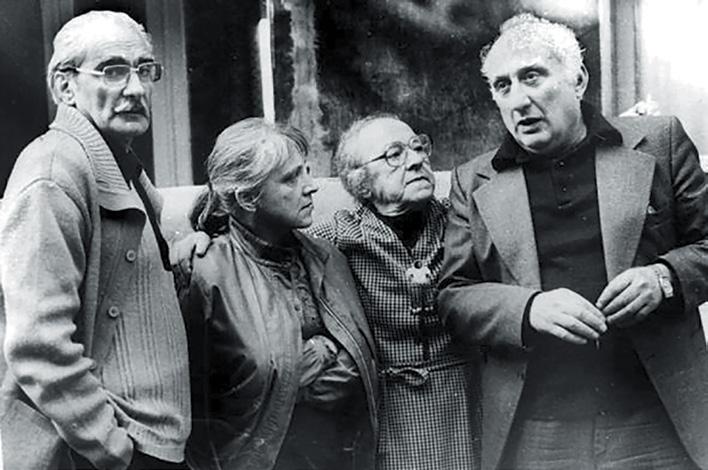

marcxena dinamikebis daxmarebiT aReqva moqmedi gmirebis gadaadgileba, adgilmdebareoba, distancia, akustikuri sivrcis siRrme, mag: saubari derefanSi, mTasa Tu gamoqvabulSi. ~.
Tavdapirvelad xma analoguri reverbiT iwereboda. msaxiobebis saubari Semodioda studiaSi, studiidan signali Cadioda sareverberacio, didi akustikis mqone oTaxSi, sadac igive xma dinamikSi Zlierdeboda, mikrofoni ki oTaxis didi sivrcidan iRebda areklil bgerebs da studiaSi abrunebda. meqanizmi rTuli gaxldaT, Tumca SesaZleblobas gvaZlevda migveRo unikaluri JReradoba. mogvianebiT gaCnda sabWoTa warmoebis sivrculi efeqtebis mowyobilobac. radios teqnikuri samsaxuris mTavari menejeri murTaz gogiZe ixsenebs: `sabWoTa aparati cilindrul-magnituri firfitebisgan Sedgeboda, amagnitianebda signals, ayovnebda da iqidan wamkiTxvelTaurebi xmas sivrcul efeqts aZlevda~. firis Canawers amuSavebdnen daxelovnebuli inJinrebi. montaJi damxmare makratel-saWrelebiT xdeboda, kontroleriT ki saWiro fragments eZebdnen. saWiro poziciis monaxvisas jer firis SiSini ismoda, sityvis dasawyisi ki aRiqmeboda rogorc `buf~ xmauri, montaJorebs
from the 1970s. Together with the technology of two channels, panoramic audio staging got a new meaning. When listening to a show, listeners could feel the movements of acting characters according to the left and right loudspeakers, as well as the place they were talking from, distances, the depth of the acoustic space, for instance, if the conversation was taking place in a corridor, in the mountains, or in a cave.
At first, sound was recorded with an analog reverb. The actors’ voice was coming in the studio, a signal was going from the studio to the reverberation room, which had a large acoustic space, and where the same voice was getting stronger in the loudspeaker, while the microphone was taking the sounds reverberated in the room’s large space and returning them to the studio. The mechanism was complex, but we could get a unique sonority. Later, a soviet device for sound effects appeared. Murtaz Gogidze, lead manager of the radio’s technical department, remembers: “The soviet device consisted of cylindrical magnetic layers, it was magnetizing the signal, delaying it, and giving it some spatial effects.”
The best engineers were working on sound recordings. The editing was done with special scissors, and they were looking for the needed fragments with a controller. When they were finding the needed position, one first heard the tape’s fizzling, and the
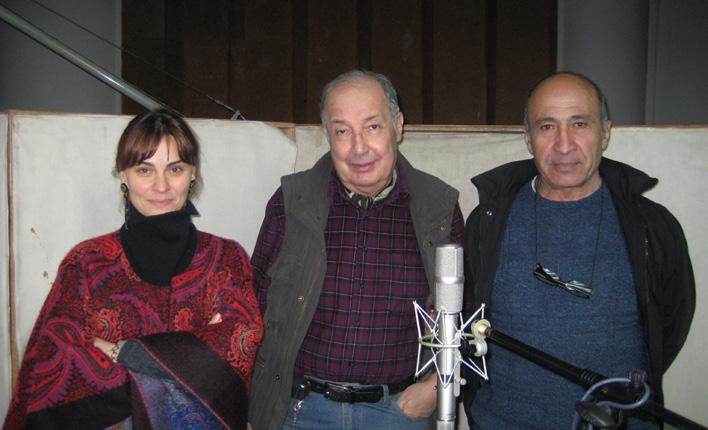
es xma aniSnebda Tu sad unda gaWriliyo da gadawebebuliyo firi. musikisgan gansxvavebiT, teqstis montaJi martiv saqmed iTvleboda. xandaxan firs Sua nawilidan aWridnen `arasaWiro~ fragments. didi raodenobiT amoWrili firebi xSirad erTmaneTSi ireoda vizualuri msgavsebis gamo. frazis ukan dasabruneblad, winaswar rTuli gansasazRvri iyo, konkretulad, romeli fragmenti gekava xelSi. amis dadgena did dros moiTxovda. montaJis teqnikuri sirTulis gamo, reJisorebi eridebodnen `Wra-kervis~ xerxis xSirad gamoyenebas. mosaxerxebeli iyo erT dublSi mTliani scenis Cawera. Tanadroulad iwereboda musika, xmovani efeqtebi, dialogebi. radiodrama literaturul dramatul studiaSi, e.w. lit-dramaSi idgmeboda, romelic specialurad iyo daproeqtebuli analoguri xmis Casawerad. studia 1992 wlidan erosi manjgalaZis saxels atarebs. akustikur darbazSi eqoebis Sesamcireblad kedlebi xis firfitebiT iyo daxSuli. radioTeatris mizani yovelTvis ar yofila CanawerSi umaRlesi xarisxis miRweva. teqnikuri aRWurvilobis mobilobis Sedegad SesaZlebeli gaxda Cawera studiis gareTac, jibis diqtofonebis daxmarebiT. audio aRbeWdvis msgavsi meTodika gamoyenebulia zurab kandelakis dokumentur radiodadgmaSi _ `9 aprili~ (1998 w.) scenebi Cawerilia metro sadgur `teqnikur
beginning of a sentence would be heard as a “boof” sound – this was the one telling editors where they had to cut or glue the tape. Unlike music, the editing of texts was considered an easy job. They sometimes cut an “unnecessary” fragment from the middle of the tape Numerous cut tapes would often get mixed with each other because they looked alike. To bring back a passage that was cut, it was difficult to pinpoint in advance which fragment you had in your hands. It demanded a lot of time. Because of the technical difficulties of editing, directors would avoid using the cutting and gluing technique too often. It was more practical to record the whole scene in one take. Music, sound effects, and dialogues were all recorded simultaneously.
Radio dramas would be staged at the Literary Drama Studio, which had been specially constructed to record analog sound. Since 1992, the studio has been named after Erosi Manjgaladze. In order to decrease the echo in the acoustic halls, the walls were filled with wooden plates. The goal of the radio theater was never to achieve the highest quality in the recordings. As a result of the mobility of the technical devices, it became possible to record outside of the studio too, with pocket dictaphones. Such an audio recording method is used in Zurab Kandelaki’s documentary radio play ‘April 9th’ (1998). The scenes were recorded at the metro station ‘Technical University’. Apart from that, computers have given us the possibility to record countless takes, and to edit on a chirurgical level. Processes that used
universitetSi~. garda amisa kompiuterma mogvca usazRvro raodenobis dublebis Caweris, montaJis qirurgiul doneze ganxorcielebis SesaZlebloba. procesi, romelic dReebi grZeldeboda, axla erT saaTSi gvardeboda. gaCnda warsulSi nanatri, audio signalis video gamosaxulebac. dRemde ar wydeba dava Tu romeli teqnologiiT Cawerili xma iyo ukeTesi. radioTeatris garSemo araerT komentarsa Tu mosazrebas waawydebiT, rom Zvel msaxiobebs ufro Tbili xma hqondaT. didi albaTobiT, aq audio aRqmis problema iCens Tavs, sxvadasxva Taoba gansxvavebul xmas aris SeCveuli. radios teqnikuri samsaxuris mTavari menejeri murTaz gogiZe ambobs _ `cifrulma teqnologiebma iseTi moxerxebuloba moitana, gaamartiva montaJi da xmis damuSaveba, rom analogur teqnologiebTan Sedarebac ar SeiZleba~. Tanamedrove teqnologiebi, masteringis gziT, saSualebas iZleva xmebi ufro msuye, xmamaRali iyos vidre aqamde. dRes msmenelis gemovnebazea damokidebuli, rogori JReradobiT moismens radiospeqtakls unikaluri audiofondidan, romelsac radioTeatri inaxavs. maT Soris qarTul klasikaze Seqmnil 100-saaTian literaturul Teatrs. audio saganZurma Semogvinaxa legendarul msaxiobTa ostatobis saocari magaliTebi. uamravi didi msaxiobi dRemde aqtiurad aris CarTuli radiodadgmebSi: zurab yifSiZe, zurab cincqilaZe, rusudan bolqvaZe, lili xuriTi, darejan xarSilaZe, givi CuguaSvili, levan berikaSvili, ana matuaSvili da sxv. mikrofonTan TamaSis xelovneba did Zalisxmevasa da yuradRebas moiTxovs. reJisori zurab kandelaki ambobs, rom: `mikrofonTan roli unda iTamaSo da ara ubralod ikiTxo! radioTeatrma SesaZlebeli gaxada sxvadasxva Teatraluri dasis wevrTa gaerTianeba `uxilav scenaze~ da mikrofonis win axali xmovani saswaulis Seqmna. am dargma metad momarTa msaxiobebis yuradReba detalebisken, ganuviTara fsiqologizmis unari. radiospecifika intonaciur mravalferovnebas iTxovs. Tamaz WilaZe: `xma, Tu SeiZleba iTqvas, lingvistikuri akapelaa, yovelgvari daxmarebis, yovelgvari sxva xerxebis moSveliebis gareSe~. es dargi gamoirCeva Tavisi TviTmyofadobiTa da muSaobis teqnikiT, romelic msaxiobs saSualebas aZlevs ostatobaSi aRmoaCinos siaxleebi. rusudan bolqvaZe: `scenaze msaxiobs bevrad meti gamomsaxvelobiTi saSualeba aqvs, kostiumi, mimika, plastika... radioSi gamosaxuleba ar gvaqvs, ZiriTadi datvirTva aris xmaze, teqstze, intonaciaze, metyvelebis maneraze. Tu ar Canxar, ver gxedavs msmeneli, ar niSnavs, rom ar unda gaiaro yvela is etapi, romelic zogadad rolis SeqmnisTvis aris saWiro, rogorc amas msaxiobis ostatoba moiTxovs~. msaxiobi ana matuaSvili ki mikrofonTan muSaobis specifikas usvams xazs da ramdenime rCevas sTavazobs momaval msaxiobebs: “mikrofonTan
to take days can now take hours. And video visuals of audio signals have appeared too.
To this day, the debate about which recording technique produced the best sound continues. Many think that old actors had a warmer voice in radio theater. The question of sound perception might be the culprit here, as different generations are used to different voices. As Murtaz Gogidze, lead manager of the radio’s technical department, says: “Digital technologies have made things much more comfortable, they made editing and sound effects so much easier, that it wouldn’t even be fair to compare them with analog technology.” Modern technologies, through mastering, give the possibility to make voices denser and stronger than before. Today, listeners can choose, according to their taste, in which sonority they want to listen to an audio drama from the unique audio fund kept at the radio theater. Including a hundred-hour-long literary theater based on Georgian classics.
The audio fund has preserved recordings of wonderful mastery from legendary actors, and numerous great actors are actively involved in radio shows today: Zurab Kipshidze, Zurab Tsintkiladze, Rusudan Bolkvadze, Lili Khuriti, Darejan Kharshiladze, Givi Chuguashvili, Levan Berikashvili, Ana Matuashvili, and others. Acting with only a microphone is an art that demands great effort and concentration. Director Zurab Kandelaki says that “at the microphone, one has to play one’s role, and not simply read!”.


mxolod xmis anabarad xar darCenili. rogorc audio msaxiobs, intonaciisa da sunTqva-Cqamis garda araferi gagaCnia. mxolod am ori ramiT unda iyo gulwrfeli Sens gmirTan da mis SegrZnebebTan _ siyvarulTan, tkivilTan, aRtacebasTan, SiSTan, imedgacruebasTan, aRmafrenasTan. Tqven warmoidgineT, amindTanac ki, ararsebul sagnebTan avtors rom uweria remarkaSi~.
erT-erT saetapo speqtaklad nugzar SataiZis radiopiesa „ori qali~ miiCneva. dadgma gamoirCeva rusudan bolqvaZisa da lili xuriTis samsaxiobo ostatobiT gacocxlebuli personaJebiT. lili xuriTis gmiri asakovani, SezRuduli SesaZleblobis mqone qalbatonia, romelic ver metyvelebs da mxolod `xmauriT~ SeuZlia komunikacia. speqtaklis Cawerisas scenis gacocxlebisTvis studiaSi msaxiobebs hqondaT nivTebi, romelTa `xmebs~ adgilze Tavad werdnen. samsaxiobo ostatoba radiospeqtaklis mTavari instrumentia, romelsac scenaristisa Tu reJisoris saTqmeli miaqvs msmenelamde, iqneba es socialuri, politikuri Tu zogadsakacobrio Tema. radioTeatri gamorCeuli platformaa, romelic erTnairad xelmisawvdomia yvelasTvis. dRes ukve
Radio theater made it possible to unite members from different theater troupes on the “invisible stage” and created new audio miracles in front of a microphone. This field has taught actors to pay more attention to detail, and enhanced their understanding of psychology. The specifics of radio demand a diversity in intonation. Tamaz Chiladze: “The voice, one could say, is a linguistic acapella, without any help, without support from any other technique”. This field stands out with its autonomy and working technique, which gives actors the possibility to discover and master new skills. Rusudan Bolkvadze: “On the stage, actors have much more ways to express themselves, the costumes, mime, movements… In the radio, we aren’t seen, and everything is in the voice, the text, the intonation, the manner of speaking. It’s not because listeners don’t see you that you shouldn’t go through all the stages needed to create a role.”
Actress Ana Matuashvili underlines the specifics of working with only a microphone, and gives several pieces of advice to future actors: “On the microphone, you depend only on your voice. As a voice actor, you have nothing more than your voice and your intonation. It is only through the use of these two things that you have to be authentic with your characters and their feelings – love, sorrow, amazement, fear, disappointment, enthusiasm, even with the weather or other, non-existent objects that authors have written in their notes.”
nebismiers SeuZlia mousminos audiospeqtakls radiosa Tu internetSi. mzardia msmenelTa raodenobac. sazogadoebrivi mauwyeblis direqtori, TinaTin berZeniSvili: `bevr sxva qveyanaSi miviwyebas micemuli radioTeatri SenarCunda saqarTveloSi da ganagrZobs ganviTarebas, mas axali sicocxle sWirdeba~. evropis qveynebSi am Janris mimarT interesi izrdeba, audio novatorul Tu montaJis axlebur xerxebs eZebs da cdilobs Tanamedroved aaJReros speqtaklebi. evropis masStabiT aqtiurad finansdeba xelovnuri inteleqtis teqnologiebi _ dakavSirebuli Zveli da axali audio xmebis xelaxla formatireba/aJRerebisTvis. sul ufro realuri xdeba xelovnuri inteleqtis saxelovnebo Janrad gamoCena da vin icis, iqneb erT dResac sesilia TayaiSvilis an erosi manjgalaZis aRdgenili xmiT isev movisminoT axali audio Canawerebi. saqarTvelos radioTeatri ki gamoirCeva Tavisi TviTmyofadobiTa da didi istoriiT, romelic saTaves swored iseT qveynebTan erTad iRebs, romelTa yofa moculia xelovnebis sferoSi inovaciiT. amas mowmobs araerTi internacionaluri festivali Tu konkursi, sadac saqarTvelo mravali welia warmatebiT monawileobs.
One of the most significant Georgian radio plays is considered to be Nugzar Shataidze’s ‘Two Women’. The staging stands out with Rusudan Bolkvadze and Lili Khuriti’s masterful performances. Lili Khuriti’s character is an elderly handicapped woman who cannot speak properly, and communicates only through “sounds”. When recording the show, the actresses had objects in the studio, the sounds of which they recorded themselves. The art of acting is the main instrument of a radio show, it is what brings the ideas of the scriptwriter or director to the listener, be it a social, political, or universal theme.
Radio theater is a special platform that is accessible to anyone. Today, anybody can listen to audio plays on the radio or on the internet. The number of listeners is rising. Tinatin Berdzenishvili, director of the Public Broadcaster: “While it was forgotten in many other countries, radio theater has been preserved in Georgia, and is continuing its development; it needs a new life”. The interest towards this genre is growing in European countries, the audio sector is looking for new, innovative editing techniques and trying to make its spectacles more modern. On a European scale, artificial intelligence technologies are being financed actively – mainly related to the reformatting or remastering of old and new audio recordings. The advent of artificial intelligence as a new art genre is becoming more and more real, and who knows, maybe one day,

damoukidebeli saqarTvelos saxeliT pirvelive gamoCena msoflio asparezze gamarjvebiT dasrulda. 1994 wels saerTaSoriso festivalze mTavari prizi zurab kandelakis speqtaklma „repeticia~ (xmis reJisori romeo tergrigoriani) miiRo. festivalSi monawileobdnen radio BBCis da evropis sxva wamyvani radiosadgurebi. `repeticia~ daidga germaniaSi, sloveniasa da slovakeTSi. paralelurad evropaSi sxvadasxva enaze araerTi sxva qarTuli audio speqtaklic Caiwera. qarTuli radioTeatris warmatebaSi udidesi wvlili zurab kandelaks miuZRvis, romelic 500-ze meti radio speqtaklis mTavari reJisoria. mimdinare wels Sedga premiera speqtaklebisa `zRva, omi da TuTiyuSi~, `niSnad siyvarulisa~, romlebic wardgenilia sxvadasxva saerTaSoriso festivalze. zurab kandelaki aRniSnavs, Tu raoden didi siamovnebaa uamravi qveynis warmomadgenlebiT savse darbazSi qarTuli enis gaJRereba. saerTaSoriso radio festivalebze miRebuli prizebis sia didi da STambeWdavia. maT Soris: PRIX EUROPA Jiuris specialuri prizi (2005 w. `kidev erTxel siyvarulze, anu Cao Cao~), msmenelTa prizi britaneTis saerTaSoriso festivali _ 2020 da 2022 weli (`mogzauroba afrikaSi“, „gvWirdeba Tu ara Seqspiri“). baton zurabs 2021 wels radioTeatris
we will listen to new audio recordings of Cecilia Takaishvili and Erosi Manjgaladze again. As for Georgia’s Radio Theater, it stands out with its autonomy and long history, which starts at the same time as those in countries renowned for their innovative nature in the field of art. This is also demonstrated by several international festivals or competitions, in which Georgia has been participating successfully for many years.
The first participation of Georgia as an independent country to an international festival took place in 1994, and Zurab Kandelaki’s spectacle ‘Rehearsal’ (sound engineer Romeo Ter-Grigoriani) won the main prize. BBC radio and other leading European radio stations were also taking part in the competition. ‘Rehearsal’ was broadcast in Germany, Slovenia and Slovakia. In parallel, several other Georgian audio spectacles were recorded in several foreign languages in Europe. The success of Georgian Radio Theater is, in large part, due to Zurab Kandelaki, who is the main director of more than 500 radio spectacles. The premieres of the shows ‘Sea, War, and Parrot’ and ‘As a Sign of Love’ took place this year, and are currently presented at various international festivals. Zurab Kandelaki notes how joyful it is to listen to the sound of Georgian language in a hall full of representatives from numerous countries. The list of prizes he received at international radio festivals is
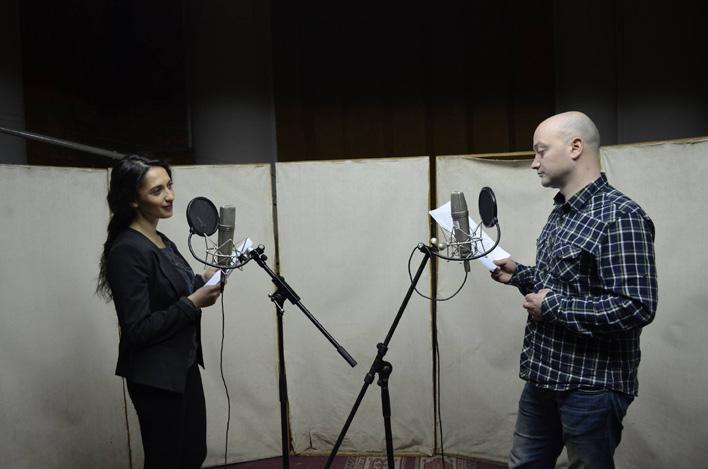

ganviTarebaSi Setanili wvlilisTvis gadaeca PRIZ NOVA Jiuris specialuri prizi. reJisori piter kaizari (ORF - avstriis sazogadoebrivi mauwyebeli): `zurab kandelaks ar ainteresebs CarCoebi Tu „rogori unda iyos~ radiodadgma, ra xangrZlivobis, cifruli da a.S. is yovelTvis sakuTari Tavis da msmenelis erTgulia... igi ar mihyveba tendenciebs, aramed yovelTvis gviyveba ambavs da yovelTvis gulwrfelia. mis namuSevrebSi yovelTvis Cans didi pativiscema literaturis mimarT~. podkastebis bumis epoqaSi radioTetari axal mniSvnelobas iZens. is internetSi, Tu sxva audio-cifrul platformebze didi popularobiT sargeblobs. aqedan gamomdinare, es qarTul radioTeatrs, Cvens realobaSi, meore sicocxlis Sanss aZlevs. ukve SesaZlebelia nebismier dros movisminoT qarTvel da ucxoel genialur mweralTa nawarmoebebis mixedviT Seqmnili araerTi radiospeqtakli, gamorCeuli msaxiobebis monawileobiT. SesaZloa swored audio matarebelze Cawerilma unikalurma xmebma axalgazrdebSi gazardos interesi xelovnebis, maT Soris literaturisa da Teatris mimarT. win kidev uamravi ambavia, romelic unda gaJRerdes da Tqvenc, msmenels, bevr TavgadasavalSi gaqvT monawileobis miRebis SesaZlebloba...
long and impressive. It includes: the Jury’s Special Prize at the PRIX EUROPA (2005, ‘Once Again about Love, or Ciao Ciao’), the Audience Award at the UK International Radio Drama Festival in 2020 and 2022 (‘Traveling in Africa’ and ‘Do we need Shakespeare or not?’). In 2021, Mr. Zurab was awarded the Jury’s Special Prize from the Grand Prix Nova for his contribution to the development of radio theater. Director Pieter Keiser (ORF – Austrian Public Broadcaster): “Zurab Kandelaki is not interested in the classic ways of working or “how a radio play should be”, how long, digital or not, and so on. He is always loyal to himself and his listeners… He doesn’t follow trends, but always tells us a story, and is always truthful. We always feel the great respect he has towards literature in his works.”
In an epoch that sees podcasts booming, radio theater is endowed with new significance. It has become very popular on the internet or other digital audio platforms. Therefore, this gives Georgian Radio Theater a chance at another life, in our modern realm. It is already possible to listen to numerous radio spectacles based on the works of brilliant Georgian and foreign writers, with the participation of outstanding actors. And the unique voices recorded in these audios might spark the interest of the youth in art, including literature and theater. There are many other stories to be told, and you, listeners, have the possibility to take part in many adventures…

am zamTrispira qalaqSi tristan maxaurTan Sexvedram erTi TovliviT qaTqaTa da Tan ucnauri dRe gamaxsena; ai, is _ Svidi wlis SvilTan erTad gomewars mimavali alag nalaf, alag natalax, alag naTovlari gza rom sulmouTqmelad amavakebina fexiT. tristan maxauris dedam galumpuli bavSvis danaxvaze mTasaviT mkacrad da mosxletiT `miTavaza“ _ romelma waraugonom wamaiyvana e balRi am gzazeo? kargi dRe iyo! Zalian kargi! davwer, roca iqneba... Tumca... am zamTrispira qalaqSi tristan maxaurTan Sexvedram kidev erTxel damanaxa, rogor fexakrefiT dadian didi adamianebi did qalaqSi...
2024 wlis 1 oqtombers duSeTis erTi patara soflis erT patara gorakze zustad imdeni adamiani miesalmeba erTmaneTs, ramdensac gaaxsendeba, rom 65-e zamTarmac umisod CamoTova. cxadia, asvlac pirobiTad momiazrebia, Torem, rac 2018 wlis ianvris Semdeg saqarTvelom tristan maxauris sulis wili adamiani dakarga, marto eg daumZimebda am miwis siyvarulSi galeul guls ase monatrebul adamians. amitom, 2024 wlis 1 oqtombers yvela guli `miesalmeba~ erTmaneTs, visac tites monatreba sWirs.
`gamagebine, es biliki rad airCie? am gziT xom ukan verasodes ver dabrundebi!~
(poeti, 1983 weli)
am bilikma tristan maxauri iq miiyvana, sadac namdvili megobrobis, namdvili mecnierebis, ostatisa da Segirdis namdvili siyvarulis ambavi nabij-nabij da namdvili sityviT iwereboda. xan naTenebi Rameebis fasad da xan _ sxartad, kafiad amoTqmuli. yvelaferi ki mainc iq daiwyo, sadac sicocxlem aidga fexi. qarTulis maswavlebels emadliereboda gansakuTrebulad: `saqme ar maZlevs mosvenebis saSualebas. iseT garemoSi davibade da gavizarde, rom, ai, am zepirsityvierma saunjem Zalauneburad CamiTria mis kvleva-ZiebaSi. jer kidev me-7 klasis moswavle viyavi, roca Cemi qarTuli enisa da literaturis maswavlebelma irakli gogolaurma damavala damemuSavebina Tema `mestvireobis tradicia fSavSi“. es iyo sruliad axali Tema, romelsac aravin Sexebia. cnobili iyvnen raWveli da goreli mestvireebi,
2016 wlis 20 oqtomberi
arsebobda apolon canavas wigni `qarTuli mestviruli poezia“, kidev aris CitalaZis wigni `stviris kvaldakval~ da sxvadasxva werili, magram arsad iyo xazgasmuli da aRniSnuli, rom es tradicia Turme fSavSic arsebobda. es gaegona irakli gogolaurs. man icoda, rom Cems sofelSi cxovrobdnen moxuci mestvireebi petre muStaSvili da daviT farnaozaSvili. miTxra, rom momenaxulebina isini,

maTgan Camewera masalebi da Tu SesaZlebeli iqneboda, damemzadebina fSavuri gudastviri. maSin duSeTis skolainternatSi vswavlobdi. skolis moswavle interesiT movekide am saqmes. ardadegebze wavedi saxlSi. mamaCems vuTxari. gauxarda. wamiyvana maSinve erT moxuc mestvire daviT farnaozaSvilTan. es kaci ukve davardnili iyo, welSi moxrili. veRar dadioda, magram maxsovroba kargi hqonda da laparakic SeeZlo. bevri ram gviambo. Cagvawerina da sinanuli gamoTqva, rom gudastviris damzadeba aRar SeeZlo. Semdeg movnaxeT SedarebiT axalgzarda kaci, ioseb xuliaSvili, romelsac aseve eswavla gudastvirze dakvra da gakeTebac icoda. am kacma daamzada fSavuri gudastviri. Semdeg es Temac da fSauri gudastviric TbilisSi, pionerTa da moswavleTa sasaxleSi warvadgine saswavlo-SemoqmedebiT konferenciaze. amis Semdeg ar Semiwyvetia folklorulSemkreblobiTi muSaoba da samecniero kvleva-Zieba, romelic SedarebiT gvian daviwye Tsu-Si Caricxvis Semdeg. iqac Zalian saintereso adamianebi Semxvdnen. batoni zurab kiknaZe, Cveni moZRvari, SesaniSnavi adamiani, SesaniSnavi folkloristi, romlis winaSe dResac valSi
var; giorgi jafariZe; moveswari mixeil Ciqovans, jondo bardaveliZes, apolon canavas. Zalian axlo urTierToba mqonda maTTan. bevrjer eqspediciaSic erTad vyofilvarT, konferenciebzec erTad gamovsulvarT da maT interessa da did yuradRebasac vgrZnobdi. unda davamato, rom mamaCemi iyo xalxuri meleqse, xalxuri mTqmeli. Cvens ojaxSi xSirad ikribebodnen moleqseebi da iyo erTi paeqroba, Seuwyveteli poeturi paeqroba~ _ tristan maxauri.
zurab kiknaZisadmi gansakuTrebuli ridi da siyvaruli rom hqonda es calmxrivi damokidebuleba ar yofila. maxsovs, Tsu-Si tristan maxaurisadmi miZRvnili specialuri gazeTis wardgenisas rogori sifrTxiliT arCevda batoni zurabi TiToeul sityvas umcrosi megobris gaxsenebisas. samecniero da pedagogiur gzaze rom araferi Tqmuliyo, mxolod is ikmarebda, tristanis ojaxis wevrad vTvli Tavso, zurab kiknaZem rom brZana. mis fenomenalur mexsierebaze isaubra da qarTuli xalxuri poeziis biblioTeka iyoo, brZana. aq megobrebsac unda davesesxo. yvela folkloruli nimuSi, romelsac ikvlevda, Tu ubralod magaliTad mohyavda, zepirad

icoda. TiTqos haeri iyo misTvis da miwa fexqveS. qvemo qedSi folklorul eqspediciaSi yofilan. moxuci kaci gardacvlila da ritualis Caweris survili ver gaumxeliaT. namdvilad uxerxuli iqneboda didi magnitofoniT WirisuflebTan Sesvla. tristans eqspediciis xelmZRvanel, beJan abaSiZisTvis SeuTavazebia, oTaxSi davjdebi, motirali qalis naTqvams sityva-sityviT davimaxsovreb da furcelze gadavitanoTo. SeeZlo! Senatrodnen mis mexsierebas, Turme! `poeturi ordeni `marad axali qnari~ 1993 wels Seiqmna. erTi wlis mere movixelTeT erTi sasiamovno WinWila, romelzedac ordenis wevrTa saxelebi da gvarebi amovkawreT _ mixeil RaniSaSvili, zurab jafariZe, zurabis meuRle qeTevan doliZe, sevarion nadiraZe, Tamar lomiZe, murRva ardoteli da me, Tqveni mona-morCili tristan maxauri. rac Seexeba saxelwodebas `marad axali qnari~ _ Cven ar gvinda, rom ugulebelvyoT is didi monapovari, rac qarTul mwerlobas Seuqmnia uZvelesi droidan dRemde. xSirad ase xdeba. roca axalgazrda mwerali gamodis asparezze, raRac ambicia aqvs da unda, rom uaryos Zveli. SeiZleba es asec iyos, magram Sen jer safuZveli unda gqondes, unda icnobde am uzarmazar literaturul memkvidreobas, erkveode mis siRrmeebSi, pativs scemde Sens winamorbed Semoqmedebs. galaktion tabiZe vaJa-fSavelaze ambobs, rom aravis Tavisi literaturuli maswavleblebis mimarT imdeni pativiscema da mokrZaleba ar hqonia, rogorc vaJa-fSavelaso. akaki enas uwunebda da akritikebda, magram vaJa mokrZalebuli iyo mis mimarTo~ _ tristan maxauri. amas wers mecnieri, romelic mxolod akademiuri maragidan ki ar iRebs sityvas _ `me aRar maxsovs, rodis movwydi mSvenier sofels, ram gadmomagdo ase martod usier tyeSi, an rad Seicno CemSi mteri adamis modgmam“ _ aramed Semoqmedi, visac adamianebTan urTierTobamde aqvs nagrovebi dauwereli codna da es codna samSoblosac ise erTgulebs, rogorc merxTan mjdar momavals _ `mainc ar minda, morCilebiT davxaro Tavi, gavuyve TeTri saxlebisken mimaval biliks, radganac vici: mec ZaRliviT damabamen farexis axlos da vudarajeb imas, rasac unda vmusravde“.
(`mgeli“, 1983 weli)
1983 wels tristan maxauri jer kidev ivane javaxiSvilis saxelobis Tbilisis saxelmwifo universitetis filologiis fakultetis studentia. es is welia, rodesac qarTvelebs georgievskis traqtatis 200 wlisTavis aRniSvnas avaldebulebdnen. am wliT daTariRebuli leqsi `mgeli~ mTeli cxovreba aRar
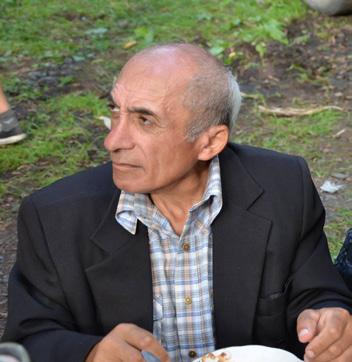
miatovebs avtors da bevrgan Seaxsenebs Tavs ukve samoyvrod.
arasodes minaxavs leqciaze, magram iolad warmomidgenia ra ganapirobebda studentebis gansakuTrebul siyvaruls. auditoriaSi idga tristan maxauri, romelic yvelasTan urTierTobaSi Tanabrad gulwrfeli da Tavdauzogavi iyo. poeti, mTargmneli, mecnieri faqizi da gemovnebiani iumoriT da filigranuli TviTironiiT Tu TavmdablobiT. iseTiT, am masStabis mecniers socialur qselSi saxelsac rom SearCevinebs _ beCav fSaveli. vaxtang mTvarelaSvilTan Sexvedris ambavs yveboda xSirad. `Cems studentebTan erTad Suafxos Tavze viyaviT dabanakebulebi. dilaa. aragvze piris dabana gadavwyvite da Cemken momavali zviad jabanaSvili davinaxe. uTevzavia da erTi Tevzi dauWeria marto. karga mozrdili kalmaxi ki iyo. maCuqa _ aba, saxlSi es erTi Tevzi rogor mivitanoo. gamovarTvi. gamovcdi. momaqvs es kalmaxi da daminaxa vaxtang mTvarelaSvilma. mivesalme. gamomelaparaka. radgan xelSi saTevzao araferi meWira mkiTxa, es ra aris, Zmiswulo, xelaobiT Tu dagiWeriao. mec daveTanxme da pasuxmac ar daayovna _ ho, albaT, sansala Tu egone da dagetana Tevzi, dageWerinao~.
`metra kaci varo~ xumrobda da zezva medulaSvilTan metroSi Sexvedris ambiTac xSirad gaumxiarulebia megobrebi: `universitetidan meliqiSviliT gavuyevi kostavas quCisaken. cota nasvami viyavi. metro

`rusTavelSi~ Cavedi. davdeqi baqanze da velodebi varkeTilisken mimaval matarebels. uceb, uknidan Cemi saxelis daZaxeba momesma. movixede da zezva medulaSvili ar SemrCa xelT?! arc ki momsalmebia. pirdapir daiwyo:
`Sen Tu xar leqsis medroSe, aba, ra ginda metroSi?! aq xo suls ver moibruneb, viT Tevzi uwylo vedroSi~.
daamTavra es zezvaizmi da meubneba, saswrafod pasuxio. Tavadac gadakrulSi yofiliyo. mec bevrs ar davfiqrebulvar da vupasuxe:
`aba, mismine, zezvao, metrasTan modi metroSi, radRa xar ukmayofilo? miwaSic vsunqavT Cvens droSi!
`ai, yoCaRo!~ _ gauxarda da gaicina. ramdenime matarebeli gavuSviT. karga xans videqiT baqanze da xmamaRla vleqsobdiT. xalxi Semogvexvia, gvismendnen.
gvianRa gagvaxsenda, rom oriveni erTi mimarTulebiT unda gavyolodiT matarebels~.
`aq sxva mxarea, sxva samyaro, dila mziani, caSi aWrila moRuRune gundi mtredebis. dasrulda gzebi uvali da gzebi tiali da mainc gulo, isev ukan rad ixedebi?!~
(`gadarCena~, 1994 weli)
bolos 2017 wlis 19 dekembers vumaspinZle saqarTvelos radios dilis eTerSi. adam beqauris axal wignze sasaubrod moviwvie. rogor gikiTxoT-meTqi? raRac Tavs veRar vuvli saTanadodo. ori dRis Semdeg universitetis pirvel korpusSi sapirispiro mimarTulebiT mimavalni SevxvdiT erTmaneTs. ase usityvod arasodes gagvicvlia keTilganwyoba. arc arasodes davmSvidobebivarT erTmaneTs ase usityvod. rom gavxede, maxsovs. universitetis qaTqaTa da veeberTela kedlebs Soris
mimavali dardiani siluetic sul memaxsovreba....
`...fiqri fiqrs gaekideba mRvrie aragvis zvirTebad, goneba pasuxs mTxovs: netavi xval ra iqneba? sad aris xsna da migneba? Cveni sawuTros dinebac rodis gahyveba Tovls?! ca Camoiqca fifqebad, fifqTa fanteli ifrqveva, ca TeTr sudaras qsovs... dRes SenTan yofna mindeba, Seni nugeSi mWirdeba, au, ra TeTrad binddeba, Tovs, mafSalia, Tovs!..
(`Tbilisi TovaSi anu RiRino caxuris gaxseneba“, 2003 weli)
2008 wlis zamTaria. erekle ugreliZem megobrebi sofel gomewarSi tristan maxaurTan Segvkriba, gavaxaroTo. gamogvivida. debi xinkals axveven. biWebi SeSas imarageben. Cemi galumpuli Svili Rumels mivaficxeT gasaSrobad. tristan maxauris dedac iqve Camomjdara da joxiT iataks xazavs...
_ deda moukdes, vin mouxarSavs qalaqSi xinkalsa?
_ rao, maSo bebo?
_ genacvle, isa, Svilo, ro, aba, Cem Svilsa xinkals vin mouxarSavs da mec, ai, eseTad dambrmali da maimuni ro vaar, genacvale!
_ ra gvaris qalbatoni brZandebiT, maSo bebo?
_ veSaguri.
_ da ramdeni wlisa?
_ 87 weli, a, exla gamixda am TebervalSi. 87 weli...
_ ras brZanebT, mSvenier javarze xarT!
_ Tvalebi aRar aris Svilo, muxlebi aRar aris. karCi ver davdivar. saqmea, Svilo, da veRar davdivar.
_ maSo bebo, aba maTe biWs vuTxraT, 7 wlis biWi ras unda akeTebdes saxlSi?
_ ih, Svilo, genacvle, ras gaakeTebda? mamuls gaakeTebda, gadmaiTxrida, saxls gaakeTebda, gomurs gaakeTebda, cxvars iyoliebda, Zroxas iyoliebda. aba, sxva ra? aba, exla, viRai unda cxvar-Zroxebi? ai, axla, aqiT adgebian da garbian qalaqSia. SiSiT ver gaivli, gadaiCexebi, sadRac gadavardebi; an xels moitex, fexs moitex, gauxdebi Wirada. kaco, kaci aRar ari sofelSi, ro vinme moides, gamiTxaros ormo da Camagdos... aRar ari kaci. su yvela qalaqSi gairbis. su yvela... vaime, Svilo, eSmakma miabruna Tavisake xalxi... eSmakma, im dasawvelma... adre ese ar iyo, Svilo.
Cven sofelSia 14 komli iyo da patara birJa gvqondis, erTi kacis banzed SaquCdebodnen da... adre, Svilo, sad iyo es amdeni an rai, an rai?
_ deda, davlocoT es xalxi. Tqven mobrZanebas gaumarjos. Tqvens guls gaumarjos. icocxleT, ixareT da idRegrZeleT. keTili stumari nu gamogvilios RmerTma (tristan maxauri)!
_ ho, Svilo, amin! Tqven kidev keTili maspinZeli. (mariam veSaguri).
megobrebi amboben, kai yma iyo, sikvdili ki daamarcxa, magram mTel safSaos Zalian daakldao. xeobas da sofels kaci sWirdeba, romelsac Wkua ekiTxeba, stumars daxvdeba da Wirsa Tu lxinSi sityvis mTqmeli iqneba. ra dro unda movides, ra ena unda ametyveldes, rom fSaurma leqsma da kafiam tristanis danaklisi Seavsoso.

P.S. `mTaSi qalebs Zmebi gansakuTrebulad uyvarT! rom gawvimdeboda, deda mecxvare Zmebs ki ar daificavda, Zmebis mzes daificada. xuTma dam, dedis kalTidan aviyoleT erTaderTi Zmis siyvaruli...~ (lela maxauri).
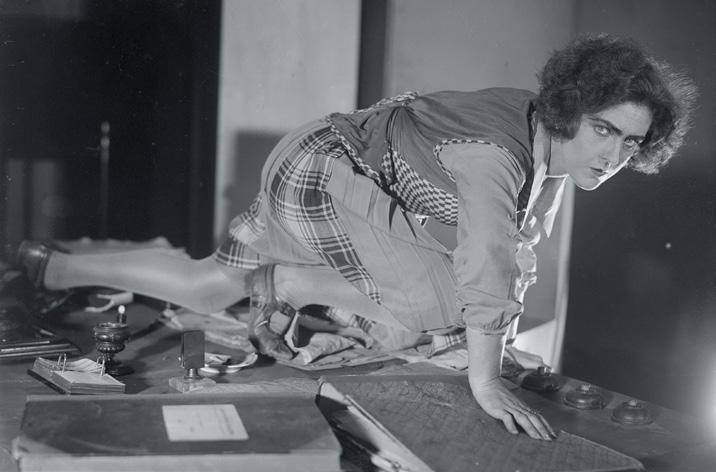
kino Sav-TeTri gamosaxulebiT daiwyo da yvela eqsperimenti, romlebmac kinematografis _ rogorc xelovnebis _ Camoyalibebas Seuwyes xeli da kinoena gansazRvres, swored Sav-TeTr periods ukavSirdeba. saxviTi xelovnebis arseboba da gamocdileba TavisTavadac gulisxmobda filmebSi feradi gamosaxulebis savaraudo daSvebas da rogorc ki SesaZlebloba gaCnda, ekranuli samyaroc gaferadda. magram manamde _ dabadebis, Ziebebis, aRmoCenebis, Camoyalibebis, fuZemdeblur, pirvel da gamorCeul etapze _ msoflio da qarTul kinoSi ara erTi mniSvnelovani filmi Seiqmna.
saqarTveloSi pirveli kinoseansebi parizSi pirveli Cvenebebidan, erTi wlis Semdeg gaimarTa. gazeTi „cnobis furceli“, 1896 wels iuwyeboda, rom: „dRes, 16 noembers,
Cinema started in black and white, and all the experiments that were held in support of the establishment of cinematography as an art and of a cinematographic language are precisely linked to the black and white period. The existence of fine arts and the experience they provided meant that everybody knew color would one day enter the screens, and as soon as it was made possible, it happened. But before that, at the stage of birth, research, and discoveries, the foundational, first, and most important stage, many important films were created in world and Georgian cinematography.
The first screenings in Georgia took place one year after those of Paris. In 1896, the newspaper ‘Tsnobis Purtseli’ wrote that: “Today, on the 16th of November, a cinematograph will be activated in the Princely Theater, showing the photographic works of the Lumière brothers, which are renowned all over Europe.” And on the 24th
saTavadaznauro TeatrSi naCvenebi iqneba sinematografi – mTels evropaSi ganTqmuli cocxali fotografiuli suraTebi liumierisa“. 1897 wlis 24 aprils ki, „iveriaSi~ gamoqveynda informacia: „tfilisis saxazino TeatrSi demonstrirebul iqneba Zmebi lumierebis sinematografi (moZravi da cocxali fotosuraTebi) da tfilisis didebis taZarSi am aprilis 20 dgan gamarTulia safotografo gamofena fotografiis moyvareTa sazogadoebisa da gastans amave wlis maisis 25 mde“. pirvel Cvenebebze daswrebis Semdeg, LATERNA MAGICA-s naTebiT mojadoebulma qarTvelma enTuziastebma pirveli „lumieruli“ filmi-siuJetebis gadaRebac daiwyes _ epizodebis saqarTvelos cxovrebidan da realobidan, rasac pirveli reJisor-operatorebi _ aleqsandre diRmelovi/ diRmeli (mamamisma, fotografma daviT diRmelma, pirvelma Camoitana saqarTveloSi „jadosnuri farani“ da mama-Svili pirvelebi iyvnen, romlebic saqarTveloSi kinoCvenebebs marTavdnen), simon esaZe, vasil amaSukeli _ kavkasiaSi mogzaurobebisas naxulobdnen.
es siuJetebi ar SemorCenila. dakargulia 1907(8) wels, Salva dadianis scenariTa da dakveTiT, mitrofane kldiaSvilis reJisuriTa da aleqsandre wuwunavas konsultaciiT gadaRebuli pirveli dasrulebulformiani dokumenturi Canaxatic _ „berikaoba-yeenoba~ (informacia Canawerebisa da dokumentebis saxiT arsebobs).
qarTuli filmebis pirveli seansebi quTaisSi, kinoTeatr „radiumSi~ gaimarTa. faqtis damadasturebeli sabuTi 1908 wlis 15 maisiTaa daTariRebuli.
mas Semdeg, rac devid uorq grifiTma da sergei eizenSteinma montaJis saidumlos miagnes da kinoenis fuZe „gamoigones~, „bunebrivad~ daiwyo mxatvruli amocanebis gadaWris, kinoenis Camoyalibebis, kinematografiuli sinamdvilis Seqmnis Ziebis sayovelTao procesi. sinematografi muzaTa dasSi meaTe muzad aRiares. kinosamyaros firze aRbeWdvis survili ki, mxatvruli azrovnebiT, sinamdvilis saxelovnebo xerxebiT gadmocemiTa da gaazrebis surviliT Seicvala. qarTveli kinematografistebic am gzas gahyvnen. 1912 wels, 25 wlis mxatvarma da kinomeqanikosma vasil amaSukelma gadaiRo pirveli srulmetraJiani, kinoenaze „ametyvelebuli~ dokumenturi filmi „akaki wereTlis mogzauroba raWa-leCxumSi 1912 wels“ (romelsac kulturis Zeglis statusi aqvs da msoflio kinos istoriaSi Sesulia, rogorc pirveli srulmetraJiani dokumenturi filmi, romlis analogic im droisTvis, kinos samSobloSic ar arsebobs), romlis premierac quTaisSi, kvlav „radiumSi“, 1912 wlis seqtemberSive gaimarTa. Cvenebas Tavad akakic eswreboda.
1916 wels, aleqsandre wuwunava, egnate ninoSvilis moTxrobis mixedviT, iwyebs pirveli srulmetraJiani mxatvruli filmis „qristine~ gadaRebas (operatorebi
of April, 1897, the following information was published in the newspaper ‘Iveria’: “The Lumière brothers’ cinemtograph (moving photographs) will be shown at Tbilisi’s Treasury Theater, and an exhibition of photographs organized by the amateur photography association is being held from the 20th until the 25th of April.”
After attending the first screening, captivated by the “Magic Lantern” Georgian enthusiasts started filming “Lumierian” film subjects themselves – episodes from the Georgian life and reality, which the first director-cameramen, Aleksandre Dighmelov/Dighmeli (his father, photographer Davit Dighmeli, was the first to bring the “magic lantern” to Georgia, and the father and son were the first ones to organize screenings in Georgia), Simon Esadze, Vasil Amashukeli, chose from their voyages in the Caucasus.
These films weren’t preserved. The first full-fledged documentary film, “Berikaoba-Keenoba”, which was based on a script by Shalva Dadiani and filmed by director Mitropane Kldiashvili and his consultant Aleksandre Tsutsunava in 1907/8, was lost (information about it only exists in the form of documents).
The first screening sessions of Georgian films took place in the cinema theater ‘Radium’ in Kutaisi. The document attesting to this dates to the 15th of May 1908.
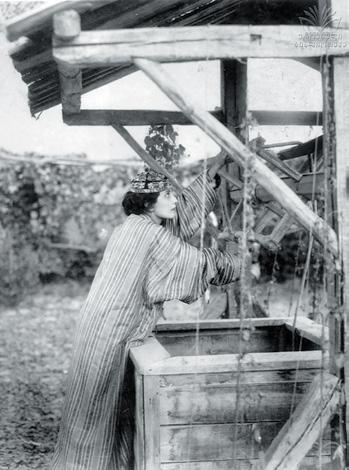
_ aleqsandre Sugermani da aleqsandre diRmelovi) da safuZvels uyris, rogorc qarTuli mxatvruli kinos arsebobas, aseve mis erT-erT Taviseburebas _ ekranizebisa da kerZod, erovnuli literaturis ekranze gadatanis tradicias.
„qristine~ _ socialuri drama, fsiqologiuri elementebiT _ erovnul Tematikasa da xasiaTebze awyobili, sazogadoebisgan gariyuli glexi gogonas tragikuli ambavi _ evropuli da amerikuli kinematografis mxatvrul mignebebs, im principebsa da sqemebs iziarebda, romlebic ukve myarad iyo msoflioSi damkvidrebuli.
1918-1921 wlebSi mxolod kinoqronikis nimuSebia Seqmnili da isini saqarTvelos demokratiuli respublikis arsebobis samwliani periodis mniSvnelovan movlenebs asaxaven _ „1918 wlis 26 maisi“, „ucxoeTis delegaciebis viziti menSevikuri periodis baTumSi“, „mfrinav mayaSvilis dakrZalva didubis panTeonSi“, „Sevardenis“ gamosvla“, „miwisZvra gorSi“ da sxv.
1921 wlidan, saqarTvelos aneqsirebis, proletariatis diqtaturis damyarebis, cenzuris, bolSevikurkomunisturi propagandis, pirovnuli da SemoqmedebiTi Tavisuflebis SezRudvisa da civilizebuli samyarosgan
After David Wark Griffith and Sergei Eisenstein discovered the magic of editing and “invented” the foundations of cinematographic language, the process of discussing artistic decisions, establishing one’s own cinematographic language, and searching for a cinematographic reality naturally began all around the world. The cinematograph was acknowledged as the tenth muse. And the wish to put reality on film gradually transformed into the wish to convey reality through an artistic thought process, with artistic tricks.
Georgian cinematographers also followed that path. In 1912, 25 year old artist and cinema mechanic Vasil Amashukeli filmed the first full-length documentary film in a “cinematic language”, ‘Akaki Tsereteli’s voyage in Racha-Lechkhumi in 1912’ (which has the cultural heritage status and has entered the history of world cinematography as the first full-length documentary film, having no analogue in the cinema world at the time), the premiere of which, again, took place at ‘Radium’ in Kutaisi in September 1912. Akaki himself attended the screening.
In 1916, Aleksandre Tsutsunava, basing himself on Egnate Ninoshvili’s novel, starts to film the first Georgian feature film, ‘Christine’ (cameramen Aleksandre Shugerman and Aleksandre Dighmelov) and lays the foundations of both the existence of Georgian fiction films, and of one of its main characteristics –ecranisation, and more specifically, the tradition of transferring


rkinis fardiT gamijvnis Semdeg, qarTulma (ukve sabWoTa) kinomac (rogorc qveyanam) axali, iZulebiTi, gezi aiRo. kino propagandis saukeTeso saSualebad aRiares da am mizniT, misi xelSewyoba da masebisTvis (sabWoTa ideologiis mTavari idea da samizne) gaziareba daiwyes. Tumca, SeiZleba iTqvas, rom 20-ian wlebSi cenzura ar iyo iseTi sastiki da Seuvali, rogoric cota xanSi (30iani wlebis dasawyisidan gaxda). bolSevizmis terorisa da axali saxelmwifos Seqmnis procesSi, barierebis miuxedavad, „Seuguebel~ xelovanTa nawili mainc axerxebda SemoqmedebiT azrovnebas, mkacr CarCoebSi moqceul da specifikurad ideologizebul sabWoTa xelovnebis drodadro arRvevda calkeul individTa da SemoqmedebiTi jgufebis naTebebi da maTi Seqmnili xelovnebis nimuSebis (dRes ukve klasika) brwyinvaleba. kinoSi aqtiurad CaerTnen _ pirveli „produseri~ germane gogitiZe, mwerlebi _ Salva dadiani, grigol robaqiZe. gadaRebebs agrZelebdnen aleqsandre wuwunava, aleqsandre diRmelovi... gasabWoebis pirvel wlebSi _ saqarTveloSi _ araqarTvelma reJisorebmac daiwyes saqmianoba. amo bek-nazarovi, vladimer
national literature to the screen.
‘Christine’, a social drama with psychological elements, built on national themes and characters, recounts the tragic story of a peasant girl who is outcast from the society, and shares the principles and schemes of European and American cinematographies’ artistic findings, which were already firmly established all over the world.
In the years 1918-1921, only newsreels are created, and they describe the important events taking place during the three-year existence of the Georgian Democratic Republic – ‘26th of May, 1918’, ‘Visit of foreign delegations in the Batumi of the Menshevik period’, ‘Burial of aviator Makashvili in the Didube Pantheon’, ‘შ ’, ‘Earthquake in Gori’, and others.
From 1921, after Georgia was annexed, a proletarian dictatorship was declared, censorship, Bolshevik-communist propaganda was introduced, personal and creative freedom were hindered and the country was separated from the civilized world by an iron curtain, the Georgian cinema took a new, forced path when it became soviet. Cinema was declared the best propaganda tool and it is in that regard that they started developing it and sharing it to the masses, in order to spread soviet ideology.
barski, ivane persetiani sxvadasxva mizeziT ewvien Tbiliss da gadaRebebs aqtiurad Seudgnen. filmebs iRebdnen qarTuli da aramxolod, literaturuli teqstebis mixedviT, an origanaluri scenarebiT, orive SemTxvevaSi _ ideologiurad gamarTulsa da propagandistuls. am xelovanebma udavod Seuwyves xeli saqarTveloSi kinos istoriis gagrZelebas, magram originaluri qarTuli kinematografi im qarTveli reJisorebis movlinebiT iwyeba, romlebic kinoSi 20-iani wlebis miwuruls gamoCndnen. 1926-1930 wlebSi gadaRebuli _ kote miqaberiZis „Cemi bebia“, nikoloz Sengelaias „eliso“, mixeil kalatoziSvilis dokumenturi „jim SvanTe“, mixeil Wiaurelis „saba“ da „xabarda“, kote marjaniSvilis „gogi ratiani“, „amoki“, „samaniSvilis dedinacvali“da nuca RoRoberiZis dokumenturi „buba“ _ im kinosuraTebis nawilia, romlTa arsebobiTac gamoCnda, rom qarTulma kinom axali amocanebi daisaxa da axali saxe SeiZina, iseTi, romelsac Tavisuflad SeeZlo araTu msoflios saetapo kinonawarmoebebis gverdiT damdgariyo, aramed maTTvis konkurenciac gaewia. maT, devid-uork grifitis, jon fordis, Carli Caplinis, robert flaertis, erix fon Strohaimis, germaneli eqspresionistebis, Jan renuaris, marsel karnes, luis bunuelisa da igive, sergei eizenSteinis kinokanonebi nawilobriv gamoiyenes da nawilobriv, damoukideblad, paralelurad, axali da Tvisobrivad TavisTavadi, originaluri gamoigones. rogorc mTliani mocemulobebiT _ saxelovnebo mimdinareobis, mimarTulebis konteqstSi, an vTqvT, gamosaxulebis, plastikuri amocanebis, Janrebisa da mxatvruli xerxebis sistemebSi, kadris, kadris kompoziciis, detalisTvis mniSvnelobis miniWebiTa da aqcentirebiT. mniSvnelovania isic, rom am reJisorebma moZebnes ideologiis moqmedebisgan Tavis daRwevis gzebi (Tumca, „formalizmSi~ dadanaSaulebis asacileblad, filmebs titrebis, araorganuli finalebisa Tu epizodebis CarTviT, „ideologiurad gamarTul“ garsSi fuTavdnen) da erovnul cnobierebas, erovnuli kulturis tradiciebs axali azrovneba da mxatvruli xedvis axali, Tanamedrove formebi miusadages. axali kinospecifika Camoayalibes, axali mxatvruli formebi, Janrebi da erovnuli
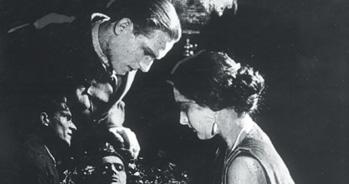
But it can also be said that in the 1920s, the censorship was not as harsh and impregnable as it would soon become, in the beginning in the 1930s. During the Bolshevik terror and the creation process of a new state, despite some barriers, part of the artists would still manage to think artistically; sometimes, some sparks from individual or collective artists would transgress the strictly framed and ideological soviet art – today, their works are classics. The first “producer”, Germane Gogitidze, as well as writers Shalva Dadiani and Grigol Robakidze would get actively involved in cinema. Aleksandre Tsutsunava and Aleksandre Dighmelovi continued to film…
During the first years of sovietization, foreign directors started working in Georgia too. Amo Bek-Nazarov, Vladimer Barski, Ivane Persetian have visited Tbilisi for various reasons and started filming actively. They were shooting films according to literary texts (Georgian and foreign) or original scripts. In both cases, the films were of an ideological and propagandist nature. These artists have undoubtedly supported the continuation of Georgian cinema, but real Georgian cinematography begins with the arrival of Georgian directors who appeared in cinema in the end of the 1920s.
The following films are part of those who made it clear that Georgian cinema started answering new questions and found a new essence, one that could proudly stand next to world-renowned films, but even compete with them: Kote Mikaberidze’s ‘My Grandmother’, Nikoloz Shengelaia’s ‘Eliso’, Mikheil Kalatozishvili’s documentary ‘Jim Shvante’, Mikheil Chiaureli’s ‘Saba’ and ‘Khabarda’, Kote Marjanishvili’s ‘Gogi Ratiani’, ‘Amoki’, ‘Samanishvili’s stepmother’, and Nutsa Ghoghoberidze’s documentary ‘Buba’.
In part, they used David Wark Griffith, John Ford, Charlie Chaplin, Robert Flaherty, Erich von Stroheim’s, German expressionists’, Jean Renoir, Marcel Carné, Luis Buñuel, and Sergei Eisenstein’s principles, and in parallel to that, they independently invented original, self-reliant ones. From a larger point of view, in the context of art movements or representation in general, of the decision of visual presentation, genres and artistic technique systems, they managed this by using the frame, composition, and by focusing on and accentuating details.
It is also worth noting that these directors found ways to circumvent ideology (although they would disguise the film’s finishing titles or final scenes in an “ideologically acceptable” veil so they wouldn’t be accused of “formalism”) and adapted new, contemporary forms of artistic vision and thought to national consciousness and national cultural traditions. They founded a new kind of cinematography, and composed new artistic forms, genres, and a national tone, “principles”, and characteristics.
In the films of these directors, artistic expressiveness, free editing order and the graphic decisions were ahead of their time. They include a monumental icon of people, of the society, a large-scale portrait (with an expressive gallery of characteristic and typical, generalized faces). It is in this dimension that the idea appears that it is precisely the society, and not the mass, precisely the society and individual interests that are at the forefront, and that in their
kinematografis saxe, „kanonebi~ da Tvisebebi SeTxzes. am reJisorebis filmebSi mxatvruli gamomsaxveloba, Tavisufali montaJuri wyoba da plastikuri gadawyveta mniSvnelovnad uswrebs dros. maTSi Seqmnilia xalxis, sazogadoebis, eris monumenturi xati, masStaburi portreti (saxasiaTo da tipaJuri saxeebis jgufuri da ganzogadebuli, metyveli galereiT). am ganzomilebebSi eqceva idea, rom swored sazogadoeba da ara masa, swored sazogadoebisa da pirovnebis interesebia pirveladi da maT winaSe yvelaferi meore Sreze inacvlebs. es kinosuraTebi poeturi, poetur-montaJuri kinos xazis gamgrZelebelia, mTlianobaSi da TiToeuli kadri Tu epizodi agebulebiTa da kompoziciiT, rakursebis mravalferovnebiTa da sruliad unikaluri montaJuri wyobiT) mxatvruli mignebebiT, kinoxerxebiT (gamorCeuli vizualuri gamomsaxvelobiT) Seqmnili metaforaa, metyveli da eqspresiuli, romelic Rrma Sinagani Sreebisa da mravalganzomilebiani saxviTi formebisgan Sedgeba. Tumca, kinos ganviTarebis es xazic male gawyda da kvlav axal tendenciebs iZulebiT dauTmo gza. 1932 wlidan sabWoTa kavSiris mmarTvelma klasma axal da yovlismomcvel ideologias oficialurad Cauyara safuZveli da sayovelTao savaldebulo „wesad~ gamoacxada „xelovnebis~ mimdinareoba _ meTodi _ socialisturi realizmi. Sedegad, socrealizmma xelovnebas ganviTarebis yvela gza mouWra, ramac mniSvnelovnad Secvala qarTuli kulturis, kinematografis dinebis kalapoti da xeli Seuwyo surogatuli, sabWoTa fsevdoxelovnebis Seqmnas. xelovnebaSi mTavari, misi arsebobis ganmsazRvreli „socialuri dakveTa~ gaxda, didaqtika, sworxazovani propaganda, rasac Tematikis SezRudva, konfliqtebisa da xasiaTebis xelovnuroba, sqematuroba, siyalbe da sicrue mohyva. yvela kari daiketa, yvela farda daeSva. ra Tqma unda, sabWoTa sistemam, ideologiam adamianis yofas, mis cnobierebas mniSvnelovani kvali daaCnia, Semoqmedi am ideologiis kanonebs daemorCila da Tavadve gamoigona _ fsevdoromantizmi da ideebis fsevdoamaRlebuloba, cxovreba, romelic arcTu mSvenieri iyo, idealur garsSi SefuTa da rogorc mSvenieri _ ise warmoadgina. am sabediswero epoqis dawyebamde, qarTvelma kinematografistebma _ gambedavma da niWieri adamianebma _ pirveli bilikebi iq gaiyvanes, sadac gzebi ar iyo. jadosnuri farniT ganaTebuli samyaro aRmoaCines, misi, jer kidev Camouyalibebeli kanonebi upirobod miiRes da maT sakuTari wesebi, fiqrebi, mosazrebebi, azrovneba, xelwera, formebi da xerxebi miusadages. qarTuli xelovnebis tradiciuli dargebis mravalsaukunovan istorias axali nakadebi Semates _ pirveli siuJetebidan srulfasovan dokumentur da mxatvrul kinomde, sinematografidan kinoxelovnebamde. epoqa Seqmnes da SeZles, sakuTari sityvebiT gamoexataT dro.

presence, everything else is of less importance. These films are following a poetic, poetic-editing cinema movement (as a whole and in each of the frames or scenes, with their construction and composition, diversity of approaches and completely unique way of editing), with artistic findings, cinematographic techniques (outstanding visuals), creating a metaphor, articulate and expressive, which is itself built on internal layers and multidimensional artistic forms.
But this line of cinematographic development also met a quick end, forced to open the way for new tendencies. From 1932, the leading class of the Soviet Union officially laid the foundations of a new and all-encompassing ideology, and made it obligatory for all arts to follow the principles and methods of social realism. As a result, social realism blocked all the paths of development to art, which significantly transformed the flow of Georgian cinema and culture in general, and led to the creation of a surrogate, soviet pseudo-art.
The most important in art became its social, didactic aspect, clear propaganda, which was naturally followed by a restriction of themes, superficial conflicts or emotions, shallow meanings and plain lies. Every door, every curtain were closed. Obviously, the soviet system and ideology have stamped a significant mark on people’s condition and their consciousness. Artists have followed the laws of this ideology and themselves invented pseudoromanticism and pseudoelevated ideas. A life that wasn’t that splendid was wrapped in a veil of ideals, and presented as such.
Before the beginning of this fateful period, Georgian cinematographers – daring and talented people – have created the first paths where there were no roads before. They discovered a world lit by a magic lamp, unconditionally accepted its yet forming laws, and adapted their own rules, thoughts, considerations, signatures, shapes and tricks to it. They added new streams to the many-centuries-long history of Georgian traditional arts – from the first themes to a full feature documentary and fiction film, from the cinematograph to cinema art. They created an epoch and managed to represent time through their own words.
nino sulava

XX saukuneSi daarsebul-Seqmnili saqarTvelos regionuli muzeumebis didi umravlesoba, im Rvawlmosili adamianebis damsaxurebaa, romlebsac kargad qondaT gaTviTcnobierebuli qveynis istoriisTvis kulturuli memkvidreobis ama Tu im Zeglis Segrovebisa da dacvis mniSvneloba. aseT adamianTa rigs miekuTvneba varlam maxarobliZe _ araordinaruli, mravalmxriv niWieri da Sromismoyvare adamiani, mxatvari, pedagogi da sazogado moRvawe, romlis daarsebulia misive saxelobis cageris istoriuli muzeumi. igi erT-erT sagazeTo werilSi (gazeTi `quTaisi~, 1968 w. 3 marti) werda, rom `...jer kidev, Cemi pedagogiuri moRvaweobis periodSi viyavi dainteresebuli leCxumis istoriul-eTnografiuli masalebis SegrovebiT, mineraluri wylebis, feradi liTonebisa da samkurnalo mcenareebis gamovlinebiT.
saWiro iyo Segrovili masalebis Seswavla da mecnierulad damuSaveba, rac SesaZlebeli gaxdeboda cagerSi muzeumis daarsebis SemTxvevaSi~. am mcire amonaridis mixedviTac ki Cans, rom mas ukve hqonda koncefcia Tu rogori unda yofiliyo muzeumi da ra roli unda Seesrulebina mas. cageris mxareTmcodneobis muzeums Tavdapirvelad RvTismSoblis miZinebis saxelobis eklesiis Senoba gadasces. eklesiebis Senobebis da administraciuli Zveli Senobebis muzeumebisTvis gadacema regionebSi damkvidrebuli praqtika iyo. daarsebis dRidan _ 1937 wlis 10 seqtembridan, 1958 wlis agvistomde varlam maxarobliZe muzeumis direqtori iyo. aqtiurma samxareTmcodneo muSaobam, romelsac igi eweoda, gamoavlina bevri unikaluri eqsponati. ori aTeuli wlis ganmavlobaSi muzeumis direqtorad muSaobasTan
erTad maxarobliZe eweoda aqtiur kvleviT saqmianobasac. mis mier 1953 wels Seqmnili gzamkvlevi _ `muzeumis sasaubro teqsti~, dResac ar aris moklebuli samecniero aqtualobas. gamoqveynebuli aqvs mravali saintereso narkvevi raionis kulturul da istoriul Zeglebze, gansakuTrebiT sainteresoa misi, Tumca kompilaciuri xasiaTis, magram sainteresod Camoyalibebuli kvleva leCxumis etimologiaze.
2000 wels cageris municipalitetis gadawyvetilebiT cageris mxareTmcodneobis muzeums mieniWa misi damaarseblis saxeli.
1996 wlis 2 dekembers muzeumSi gaCenilma xanZarma gaanadgura eqsponatebis nawili. zarali kidev ufro didi iqneboda, rom ara muzeumis TanamSromlebis Tavdadebuli brZola muzeumis da eqsponatebis gadasarCenad. muzeumis aRdgenis saqmeSi didi daxmareba gaswia fondma _ `Ria sazogadoeba saqarTvelo“, romelmac 4300 dolari gamoyo naxanZrali eqsponatebis gadarCenisTvis. muzeumi aT welze met xans agrZelebda muSaobas Seuferebel SenobaSi; 2011 wels muzeums saSualeba mieca dabruneboda Tavis Senobas, romlis aRsadgenad da gasaremonteblad Tanxebi gaiRo cageris municipalitetma. 2012 wels, muzeumis daarsebis 75 wlisTavze, saqarTvelos kulturisa da ZeglTa dacvis saministrosa da cageris municipalitetis dafinansebiT, saqarTvelos erovnuli muzeumisa da cageris istoriuli muzeumis TanamSromlobiT ganxorcielda proeqti _ cageris istoriuli muzeumi: leCxumis kulturulsaganmanaTleblo centri (fondebi, gamofenisa da albomis momzadeba, saganmanaTleblo programa), romelic SeiZleba saxelmZRvanelo da sanimuSo iyos sxva regionuli muzeumebisTvis. saqarTvelos erovnuli muzeumis TanamSromlebis daxmarebiT mowesrigda cageris istoriuli muzeumis fondebi _ gakeTda masalis inventarizacia, digitalizacia, eqsponatebi ganisazRvra da dalagda periodebis mixedviT, gaimijna koleqciebi (geologiis, paleontologiis, qvis xanis, brinjaorkinis xanis, antikuri, Suasaukuneebis, saeklesio nivTebis, eTnografiuli, numizmatika, dimitri ermakovis fotokoleqcia); gakeTda davTrebis digitalizacia, Zveli samuzeumo davTrebi gadayvanil iqna eleqtronul versiaSi, TiToeul koleqciaze gakeTda monacemTa bazebi xel-failebis saxiT, TiToeul artefaqtze Seiqmna sainventaro da sagamofeno baraTis eleqtronuli versia, Catarda eqsponatebis sarestavracio da sakonservacio samuSaoebi (Catarebul samuSaoze Seiqmna baraTebis el. versiebi, daculobis aqtebi da restavraciis baraTebi); SemuSavda kulturul-saganmanaTleblo programa da samecniero biblioTekiT aRiWurva saTanado sivrce (proeqtis msvlelobaSi saqarTvelos erovnul muzeumSi Segrovebuli wignebisa da cageris istoriul muzeumSi
daculi wignebiT Seiqmna biblioTeka, sadac aris yvela is naSromi Tu perioduli gamocema, romelic saWiroa istoriiTa da arqeologiiT dainteresebuli moswavleebis, studentebisa da mkiTxvelebisTvis); gakeTda axali eqspozicia da gamoica cageris istoriuli muzeumis albomi. saeqspozicio sivrced gamoyenebul iqna xanZrisgan gadarCenili fligelis II sarTuli, sadac ganTavsda vitrinebi, romlebSic gamofenili iyo muzeumSi daculi geologia-paleontologiis, qvis xanis, brinjao-rkinis xanis, antikuri, Suasaukuneebis, saeklesio nivTebis, numizmatikis da eTnografiuli koleqciebis nawili; xolo dimitri ermakovis fotokoleqcia gamoifina imave sarTulis foieSi.
2015 wels cageris istoriuli muzeumis xanZris Sedegad ganadgurebuli fligeli aRdgenil iqna.
Seiqmna axali saeqspozicio sivrce I da II sarTulze. muzeumis TanamSromlebis ZalebiT 2012 wels gakeTebuli eqspozicia gadatanil iqna axal saeqspozicio sivrceSi _ I sarTulze eTnografiuli eqsponatebi ganTavsda _ liTonisa da xis sasoflo-sameurneo da saxelosno iaraRebi, spilenZisa da xis saojaxo nivTebi, cxenis aRkazmuloba, WurWleuli, vercxlis qamrebis da iaraRis koleqcia, romelic asaxavs leCxumis gviandeli Suasaukuneebis da XX saukunis dasawyisis sxvadasxva socialuri fenis yofa-cxovrebas, romlebsac axali artefaqtebi daemataT fondebidan axladSeZenil masalebTan erTad; xolo II sarTulze gamofenilia geologia-paleontologiis, qvis xanis, brinjao-rkinis xanis, antikuri, Suasaukuneebis, saeklesio nivTebis, numizmatikis masalebi. dimitri ermakovis fotokoleqcia kvlav II sarTulis foieSi darCa gamofenili. am koleqciiT, romelic asaxavs aramarto istoriul Zeglebs, aseve naTeli suraTis aRdgenis saSualebasac iZleva XX saukunis dasawyisis leCxumis yofa-cxovrebis Sesaxeb. cageris istoriul muzeumSi daculi geologiuri da paleontologiuri koleqciebiT warmodgenili eqspozicia moicavs regionis liTonur da araliTonur wiaRiseuls, samSeneblo da sanaxelao qvebs, sxvadasxva karstul naRvenT formebs da namarx faunas. koleqciebis umetesi nawili SemTxveviTi monapovaria. muzeumis fondSi daculia iuruli asakis qanebTan dakavSirebuli baritis, feradi da Savi metalebis, qvanaxSiris nimuSebi, rac pirdapir miuTiTebs raionis farglebSi liTonuri wiaRiseulis madangamovlinebebis arsebobaze. fondSi gvxvdeba aseve sanaxelao qvebi: aqati, ameTvisto, gaqvavebuli xe, iaspisi, alebastri carculi periodis koleqciebi mdidaria uxerxemloTa ganamarxebuli fauniT _ mucelfexiani (Gastropoda) da Tavfexiani moluskebi (Ammonites), zRvis zRarbebi (Echinoidea), marjnebi (Coral), Rrublebi (Hexactinel-lida). koleqciebSi gvxvdeba

kirqvis sxvadasxva formis konkreciebi da karstuli mRvimeebisTvis damaxasiaTebeli naRvenTi formebi _ stalagmitebi da stalaqtidebi. carcul qanebTanaa dakavSirebuli travertinis (adgilobrivi _ spontio) mciregamosavlebi, romelic saukeTeso samSeneblo masalaa.
sainteresoa paleogenuri da neogenuri asakis namarxSemcveli qanebis koleqciebi, rogoricaa numulitebiani kirqvebi, Tevzisqercliani mergelebi da spaniodontelebiani qviSaqvebi.
muzeumis geologiuri koleqciebSi erT-erTi saintereso nimuSia giganturi septaria (diametri 80 sm.), romelic gvxvdeba miocenur molasur naleqebSi.
Semdegi arqeologiis ganyofilebaa, sadac qvis xanidan dawyebuli Suasaukuneebis CaTvliTaa warmodgenili arqeologiuri masalebi. arqeologiuri koleqcia leCxumSi SemTxveviT aRmoCenil da arqeologiuri gaTxrebis Sedegad mopovebul eqsponatebs Seicavs. koleqcia saqarTvelos teritoriaze aRmoCenili arqeologiuri kulturebis ganuyofeli nawilia. qvis xana. cageris istoriul muzeumSi leCxumSi

preistoriuli xanis arsebobis erTaderT sabuTs warmoadgens aq daculi qvis masaliT warmodgenili koleqcia, romelic mxolod zedapirulad Segrovebuli masalis kategorias miekuTvneba. koleqciaSi gamoiyofa Sua paleoliTis, zeda paleoliTis, neoliT-qalkoliTisTvis damaxasiaTebeli masala, romlis dasamzadeblad adgilobrivi vulkanuri, danaleqi, vulkanogenuri danaleqi da metamorfuli qanebia gamoyenebuli. masalis tipologiuri, teqnologiuri da morfologiuri monacemebi cxadyofs artefaqtebis arqaulobas da leCxumSi paleoliTis da neoliT-qalkoliTis arsebobas adasturebs.
varlam maxarobliZis `muzeumis sasaubro teqstis~ mixedviT kaJis qvis iaraRi aRmoCenilia soflebSi _ isunderi, lailaSi, spaTagori, nakuraleSi da xvamlis mTaze.
brinjao-rkinis xana ganixileba kolxuri brinjaos kulturis konteqstSi, rogorc misi Semadgeneli nawili.
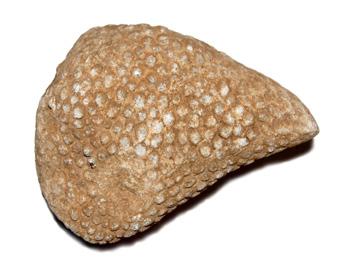
varlam maxarobliZis `muzeumis sasaubro teqstis~ mixedviT, uZvelesia spilenZis yuamiliani culebi da foTliseburi formis spilenZis Subis pirebi. leCxumSi aRmoCenil nivTebidan adreul brinjaos xanas akuTvnebs sof. zubSi napovn Savad gamomwvar da gaprialebul samyurian Tixis qoTans.
igi Tvlis, rom yvelaze meti raodenoba kolxuri culebisa da sxva artefaqtebisa leCxumis niadagma (CixaSi, cxeTa _ xeleCoebi, afTebi, lagami) mogvca, rac afiqrebinebs `specialistebs, rom leCxumis mxare `kolxuri industriis~ (misi terminologiiT) erT-erT ZiriTad centrs warmoadgenda. leCxumis teritoriaze aRmoCenili brinjaos zodebi da `aWe~-bi miuTiTeben imaze, rom spilenZisa da brinjaos damzadeba adgilobrivad xdeboda (zodebi da `aWe~-bi aRmoCenilia sof. CixaSSi da sxvagan). is asaxelebs, rom `1924 wels sof. oyureSSi, `lajobis ZirSi~ aRmoCnda 32 cali brinjaos nivTi, maT


Soris kolxuri tipis culebi, najax-namgala, satexi, brasletebi, kruJka da sxva~. varlam maxarobliZe sxva muzeumebSi Senaxul masalebsac asaxelebs _ quTaisis muzeumi, kolxuri culebi sof. surmuSidan, ermitaJi _ kolxuri culebi, Subispirebi, situla da sxv. sof. luxvanodan, surmuSidan, lailaSidan. varlam maxarobliZis mosazrebebma dadastureba pova arqeologiuri kvlevebiT da sabolood SegviZlia davaskvnaT, rom leCxumi kolxuri brinjaos kulturis (Zv.w. II aTaswleulis meore nax. _ Zv.w. I aTaswleulis pirveli nax.) erT-erTi umniSvnelovanesi nawilia, am kulturisTvis damaxasiaTebeli yvela ZiriTadi arqeologiuri komponentiT, rasac naTlad asaxavs cageris istoriuli muzeumis eqspozicia _ preistoriuli metalurgiis Zeglebi, brinjaos ganZebi da specifikuri keramika cxeTis kolxuri nasaxlaridan. leCxumSi preistoriuli metalurgiis Zeglebis koncentracia, brinjaosa da rkinis nakeTobebis simravle

(brinjaos ganZebisa Tu calkeuli artefaqtebis saxiT), amyarebs miTebisa da werilobiTi wyaroebis cnobebs kolxeTis Sesaxeb, romlis Tanaxmadac _ `(kolxeTis) simdidre oqroTi, vercxliT, rkiniTa da spilenZiT gvixsnis /argonavtTa/ laSqrobis swor sababs~, rogorc werda berZeni istorikosi da geografi straboni. da is safuZvelia, romelic pirdapir miuTiTebs leCxumis rolze kolxur brinjaos kulturaSi da aq mcxovrebi xalxis saqmianobaze _ samTo-sawarmoo metalurgia mravaldargobriv da ganviTarebul soflis meurneobasTan erTad.
muzeumSi warmodgenilia aq daculi spilenZis
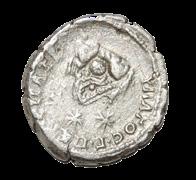

metalurgiuli warmoebis sruli procesis amsaxveli artefaqtebi _ didi raodenobiT widebi, gamosadnobi qurebis Selesilobisa da tigelebis Tixis fragmentebi, Tixisa da qvis sabervelebi, liTonis naRvenTebi, sxvadasxva zomis zodebi.
leCxumis mTel rig soflebSi (ofitara, oyureSi, laWepita, meqvena, dRnorisa, TeTri Rele, zubis midamoebi) spilenZis uamravi gamosavlebia dadasturebuli. maTi uZveles periodSi damuSavebis SesaZleblobas adasturebs amave gamosavlebTan mikvleuli sawarmoo gadanayari (luxvano, usaxelo, lailaSi, derCi, dRnorisa, zubi, laZgveria).
muzeumSi daculia spilenZis zodebis ocamde nimuSi, romelTagan udidesi 32 kilograms iwonis (zogiSidan). brinjaos zogi ganZis (oyureSis, luxvanos, surmuSis ganZi) da metalurgiis sawarmoo gadanayaris aRmoCenis adgilebi erTmaneTs emTxveva.
muzeumSi dacul da eqsponirebul uZvelesi metalurgiis amsaxvel masalebs emateba masalebi axali arqeologiuri aRmoCenebidan, romlebmac sabolood daadastura leCxumSi uZvelesi spilenZis metalurgiis arseboba da sabunebismetyvelo kvlevebiT daadgina mTeli rigi saintereso faqtebi _Zeglebis TariRebi,
struqtura da artefaqtebis saxeoba (qurisa da tigelebis fragmentebi, sxvadasxva saxis widebi, saqSeni milebi), klimati da mcenareuli safari.
adgilobrivi spilenZ/brinjaos metalurgiis safuZvelzea Seqmnili cageris istoriul muzeumsa da sxva muzeumebSi daculi brinjaos ganZebi (12 ganZi) da didi raodenobiT artefaqtebi _ culebi, Subispirebi, Toxebi, segmenturi iaraRi, brinjaos kaTxebi (situlebi), mcire plastikis nimuSebi. am ukanasknelidan jer kidev varlam maxarobliZem miaqcia gansakuTrebuli yuradReba brinjaos cxenosnis qandakebas, romelic `cageras ganZis~ nawilia sxva mniSvnelovan artefaqtebTan erTad (gravirebuli kolxuri culebi, e.w. sikili, Toxebi, segmentebi, brinjaos zodebi); xolo muzeumis bolo wlebis SenaZenia brinjaos xaris mcire zomis qandakeba, romelic an ganZebis Semadgenlobis nawilia an samarxeuli nivTia, rac sxva artefaqtebTan erTad leCxumSi gvianbrinjaoadrerkinis xanis samarxebis arsebobaze miuTiTebs. `ganZebi~, nivTebis jgufi, romelic aRmoCenilia erT adgilas, liTonis an Tixis WurWelSi an uWurWlod, gvianbrinjaos xanis kavkasiis kulturebidan mxolod
kolxuri brinjaos kulturisTvisaa damaxasiaTebeli. `ganZebi~ miCneulia RvTaebisadmi Sewirulobad, sakraluri daniSnulebis kompleqsad da eTnikuri niSnis matarebelia. kolxuri brinjaos kulturis arealSi mikvleuli 150-ze meti ganZidan 12 leCxumSia aRmoCenili.
cageris istoriul muzeumSi 3 brinjaos ganZi inaxeba _ cageras ganZi (Zv.w. VIII-VII ss). aRmoCnda 1938 wels sof. cageraSi (adgili CixaSi, md. rionis xeoba), miwis damuSavebis dros, 1 metris siRrmeze, Tixis WurWelSi; xojis ganZi (Zv.w. VIII-VII ss). aRmoCenda 1958 wels sof. xojSi; oyureSis ganZi (Zv.w. VIII-VII ss). aRmoCnda 1924 wels sof. oyureSSi (adgili lajobis Ziri, md. cxeniswylis xeoba), qvis kedliseburi wyobis qveS. ganZi dafluli iyo brinjaos didi WurWliT (ganZis didi nawili saqarTvelos erovnuli muzeumSia daculi).
brinjao-rkinis xanas ganekuTvneba `cxeTis kolxuri nasaxlaris~ masalis eqspoziciac. es nasaxlari gamovlenil da Seswavlil iqna 1970-71 wlebSi saqarTvelos mecnierebaTa akademiis iv. javaxiSvilis saxelobis istoriis, arqeologiisa da eTnografiis institutis arqeologiuri eqspediciis sadazvervo-



arqeologiuri samuSaoebiT. gaiTxara nasaxlaris in situ ubnis erTi patara saTavsi (Txrili # 6), sadac aRmoCnda _ Tixatkepnili iatakis fragmentebi, fleTili qvebis wyobaze amoyvanili wnuliT da baTqaSiT Selesili kedlebi, savaraudod gadaxurva banuri iyo; aRmoCnda Rumeli, romelic ori ganyofilebisagan Sedgeboda da iatakad Tixis natexebi iyo gamoyenebuli; Rumelis win ori patara danaxSirebuli wre iyo, romelic damwvari marcvlebisagan Sedgeboda. mopovebuli arqeologiuri masala warmodgenilia da eqsponirebulia tipuri kolxuri keramikiT, liTonis, Zvlisa da qvis nivTebiT. keramika e.w. saojaxo-samzareulo WurWels ganekuTvneba, liTonis nawarmia _ brinjaos moxrili Rero, brinjaos firfitis ori fragmenti da Tavxvia oTxwaxnaga, nakluli sakinZi; Zvlis mcire zomis nivTebi keramikul warmoebasTanaa dakavSirebuli ornamentis dasatanad Tu saprialebld; qvis iaraRebia _ kaJis namglis ociode CasarTi, kaJisave ramdenime anatkeci da nakluli isrispiri, ori brtyeli salesi da ovaluri, SuaSi Semsxvilebuli saprialebeli. unikaluria nivTi _ qvis yalibis cali sagduli, romlis brtyel mxareze reliefurad gamokveTilia rTuli svastika (Tu meandriseburi svastika). yalibSi Camoisxmeboda Txeli firfita am ornamentiT da gamoiyeneboda rogorc ornamentis dasatani saSualeba an Tavad gamoiyeneboda rogorc ornamenti-inkrustacia, savaraudod kolxuri abzindebisTvis. nivTis asli muzeumSi gamoifineba.
cxeTis kolxur namosaxlarze mopovebuli arqeologiuri masala Zv.w. VIII-V saukuneebiT unda ganisazRvros.
antikuri xanis masalebis umetesi nawili mopovebulia
cxeTis samarovanze, romelic iTxreboda 1962 wels da didi Sesvenebis Semdeg 2015-2018 ww-Si. cxeTis samarovanze inhumaciuri, qvebiT SemosazRvruli an ubralo ormosamarxebia. 2016 wels erTi samarxi (# 6) mTlianad gadatanil iqna muzeumSi saeqspoziciod. samarovani TariRdeba Zv.w. IV _ ax.w. IV ss-iT. masala warmodgenilia adreantikuri xanis artefaqtebiT _ brinjaos zurgSedrekili samajurebi, zarakebi, mZivebis didi asortimenti, keramika, iaraRi; gvianantikuri xanis artefaqtebia _ brinjaosa da vercxlis boloebgadadebuli samajurebi, oqros, vercxlis, brinjaos sayureebi, brinjaos da rkinis abzindebi, mZivebi, keramika, rkinis Subispirebi, satevrebi, maxvilebi, danebi. antikuri xanis koleqcia, warmodgenili arqeologiuri gaTxrebis Sedegad da SemTxveviT mopovebuli eqsponatebiT, romlebic Zv.w. IV _ ax.w. IV saukuneebs ganekuTvneba, warmodgenilia _ sabrZolo da sameurneo
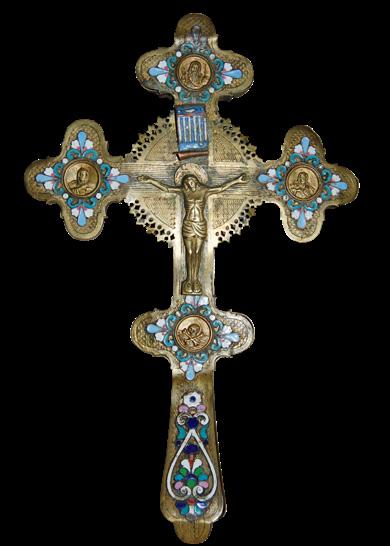
iaraRiT, samkauliT, tansacmelTan dakavSirebuli nivTebiT, numizmatikuri masaliT. antikuri xanis masala adasturebs berZnul-romauli wyaroebis cnobebs leCxumis antikuri samyaros savaWro-ekonomikur procesebSi monawileobis Sesaxeb. antikuri xanis masalis nawili SemTxveviTi monapovaria (brinjaos samajurebi, sayureebi, beWdebi, zarakebi, abzindebi, balTebi, mZivebi). isini aRmoCenilia soflebSi _ cxeTa, muris cixis midamoebi, usaxelo, tviSi, cageri, zaragula, zubi, aRvi, lajana, zogiSi, nakuraleSi, dRnorisa, gona. usaxeloSi XX s-is dasawyisSi aRmoCenili unikaluri nivTebi _ oqros medalioni topazis Tvalze Sesrulebuli gemiT (heliosis gamosaxuleba) da oqros ori firfita, ermitaJSi inaxeba. cageris istoriul muzeumSi daculia masalis garkveuli nawili, romelTa aRmoCenis adgili ucnobia _ kolxuri TeTri, boloebdabrtyelebuli oqros sayure sasafeTqleebi, oqros sayure rgoli, cremliseburi formis oqros Rru mZivi, vercxlis Tavbologadadebuli da gadaxveuli samajuri, amforis qusli, Tixis Tasi, doqi da qoTani, Tixis frinvelis figura.
Suasaukuneebis koleqciaSi daculi adreuli sabrZolo iaraRi leCxumis brinjaosa da rkinis xanis metalurgiis tradicias agrZelebs. iaraRis sakmaod mravalricxovani koleqcia warmodgenilia SubispirebiT, culebiT, maxvilebiT, satevrebiTa da isrispirebiT. nivTebis mcire nawili cxeTis samarovanzea aRmoCenili _ Subispirebi, danebi, satevrebi, maxvilebi, ZiriTadi nawili ki SemTxveviT monapovars warmoadgens.
ganviTarebuli Suasaukuneebis koleqciaSi Tavmoyrilia am periodisaTvis mwirad SemorCenili unikaluri qarTuli sabrZolo iaraRi, meomris aRWurviloba da samkauli. gansakuTrebiT aRsaniSnavia, swori orlesuli maxvili da kvercxiseburi formis qarTuli muzaradi, romlis msgavsic daculia krakovSi (poloneTi) vavelis sasaxleSi. koleqciaSi warmodgenilia saqarTveloSi gavrcelebuli, zogadad kavkasiisaTvis damaxasiaTebeli kaJiani Tofebisa da dambaCebis nimuSebi, sxvadasxva masaliT gaformebuli (Zvali, rqa, vercxli) xanjlebi da xmlebi, vercxlis qamrebi.
saeklesio nivTebis koleqciaSi Tavmoyrilia: jvrebis, liturgikuli nivTebis, saeklesio zarebis, Sua saukuneebis naqargobis nimuSebi. numizmatikis koleqciaSi daculia leCxumis politikuri istoriis, sagareo da savaWro-ekonomikuri urTierTobebis amsaxveli _ antikuri xanis, Suasaukuneebis, axali da uaxlesi periodis adgilobrivi da importuli monetebi; ordenebi da medlebi. numizmatikuri koleqcia farTo qronologiur diapazons moicavs _ Zv.w. V saukuneSi moWrili `kolxuri TeTrida~ XX saukunis sabWour monetebamde. koleqciaSi daculia: kolxuri triobolebi,

aleqsandre makedonelis stateri, aleqsandre makedonelisa da lisimaqes stateris minabaZebi, oqtaviane avgustusis romauli denari, romis imperatorebis monetebi _ traianes denari da kesariaSi moWrili adrianes didraqma, giorgi III, Tamaris, Tamarisa da daviTis, giorgi IV laSas, rusudanis, daviT narinis dmanisSi moWrili moneta, trapizonuli aspri, seljukuri moneta da saqarTveloSi moWrili `kirmaneuli TeTri~, qarTulhulaguiduri da mangu yaenis mier TbilisSi moWrili monetebi, erekle II mier moWrili spilenZis monetebis TiTqmis yvela tipi, TbilisSi moWrili sirma abaziani, iranuli lentiseburi formis dakninebuli vercxlis monetebi, e.w. qarTul-rusuli monetebi vercxlisa da spilenZis monetebi _ abaziani, orabaziani, ockapikiani da sxv., Turquli monetebi, rusuli monetebi, iranuli
fuli, amerikuli erTdolariani, germanuli marka, sabWoTa kavSiris monetebi; agreTve, ordenebi da medlebi: romanovebis mefobis 300 wlisTavTan dakavSirebiT moWrili medali, germanuli sabrZolo ordenebi, sxvadasxva sferoSi miRweuli warmatebebisTvis moWrili ordenebi.
eTnografiul koleqciaSi warmodgenilia leCxumis mosaxleobis materialuri yofis amsaxveli eqsponatebi: liTonisa da xis sasoflo-sameurneo da sabrZolo iaraRebi, erovnuli tansacmeli, spilenZisa da xis saojaxo nivTebi, liTonis saxelosno iaraRebi, fardagebi, naqargobebi, samosi, qarTuli da kavkasiuri sabrZolosanadiro iaraRi da sxva nivTebi. rogorc vaxuSti batoniSvili werda _ `garna ars

leCxumi mTis adgilad Tqmuli, garna ars venaxiani, xiliani, movals yovelni marcvalni, Tvinier brinjbanbisa, garna siviwrovisa da kldianobisaTvis ara egoden simravaliT~, es kuTxe marTlac mosaxerxebelia memindvreobis, mevenaxeobis da mesaqonleobis TvalsazrisiT da amitomac mdidaria meurneobis am dargebTan dakavSirebuli, dRemde yofa-cxovrebaSi Semonaxuli tradiciuli sameurneo iaraRebiT, dgam-WurWliT, transportirebisTvis gankuTvnili mowyobilobebiT. leCxums gamoarCevs unikaluri vazis jiSebi, romelTaganac mzaddeba ganTqmuli Rvinoebi: usaxelouri, orbelis ojaleSi, tviSi da sxva. am kuTxis tafobebi da xeobaTa ferdobebi xorbleulis uZvelesi jiSebis (maxa da zanduri) erT-erTi uadresi gavrcelebis adgilebia. muzeumis eTnografiuli koleqciaSi daculi gasuli saukunis Sua wlebamde yofaSi arsebuli saxnisebi, Rvinis sazidi kuprielebi/tiki, xis saxlis ornamenti, cxenis aRkazmuloba, spilenZisa Tu Tixis saojaxo WurWeli, Zveleburi Wuri Tu uZvelesi pureulis, maxisa da zanduris asaRebad gankuTvnili metad originaluri mowyobiloba `Snakvi~ da sacexvavebi naTlad asaxavs am kuTxis yofa-cxovrebisa da meurneobis Taviseburebebs. dimitri ermakovis fotonamuSevrebis koleqciaSi daculia leCxumSi 1910 wels eqvTime TayaiSvilis mier warmoebuli eqspediciis dros gadaRebuli fotoebi da 1914 wels niko maris xelmZRvanelobiT wm. maqsime aRmsareblis saflavis saZiebod Catarebuli eqspediciis aRmbeWdavi nimuSebi.
cageris istoriuli muzeumi yovelTvis iyo mxaris kulturul-saganmanaTleblo rolis Semsrulebeli _ sistematiurad qveyndeboda sagazeTo statiebi mxaris warsulisa da `leCxumis (cxeTa-dexviris) arqeologiuri eqspediciebis~ muSaobis Sesaxeb; gamoqveynda muzeumis mecnier-TanamSromlis d. kopalianis naSromi _ `narkvevebi leCxumis warsulidan~, 2012 wels gamovida `cageris istoriuli muzeumis albomi~, xolo 2014 wels ,,cageris istoriuli muzeumis Sromebis krebuli~ I, romelic faqtobrivad muzeumis gzamkvlevs warmoadgens.
2023 wels cageris municipalitetis skolebs da sxva organizaciebs usasyidlod gadaecaT cageris istoriuli muzeumis iniciativiT saqarTvelos erovnuli biblioTekis mier gamocemuli giorgi mamardaSvilis wigni _ `leCxumi~ (istoria, eTnologia).
2023 wels cageris istoriul muzeumSi Catarda muzeumis koleqciebze safondo samuSaoebi _ eqsponatebis detaluri aRwera da digitalizacia; muzeumSi daculi unikaluri arqivi, romelic moicavs 4 000-mde dokuments da fotos saqarTvelos erovnuli biblioTekis xelmZRvanelobiT da muzeumis TanamSromlebis monawileobiT gdayvanil iqna cifrul versiaSi da

ganTavsdeba saqarTvelos erovnuli biblioTekis saitze, riTic xelmisawvdomi gaxdeba farTo sazogadoebisTvis. cageris istoriuli muzeumis potenciali da roli mxaris kulturul-saganmanaTleblo saqmianobaSi didia _ 2023 wels, 19-20 maiss Catarda regionuli samecniero konferencia `mTiani kolxeTis istoriuli warsulidan~, romelSic moxsenebebiT gamovidnen, rogorc qvemo svaneTisa da raWis warmomadgenlebi, aseve mecnierebi saqarTvelos erovnuli muzeumidan; moewyo regionis mxatvrebis gamofena; gansakuTrebuli aRniSvnis Rirsia `liberTisa~ da cageris istoriuli muzeumis erToblivi proeqti _ `saubrebi vefxistyaosanze~; muzeumis gverdze sistematiurad qveyndeba informacia muzeumis eqsponatebisa da muzeumis RonisZiebebis Sesaxeb. cageris istoriuli muzeumis roli kidev ufro gaizrdeba qalaqisa da regionisTvis, roca damTavrdeba axali eqspoziciis mowyoba _ gamofenas Seemateba axali eqsponatebi, romlebic asaxavs leCxumis uZveles istorias, spilenZis metalurgias da mopovebulia `leCxumis (preistoriuli metalurgiis Semswavleli) arqeologiuri eqspediciis~ mier; xolo antikuri xanisa da Suasaukuneebis masalebi Seemateba `xvamlis eqspediciis~ monapovariT xvamlis midamoebidan.

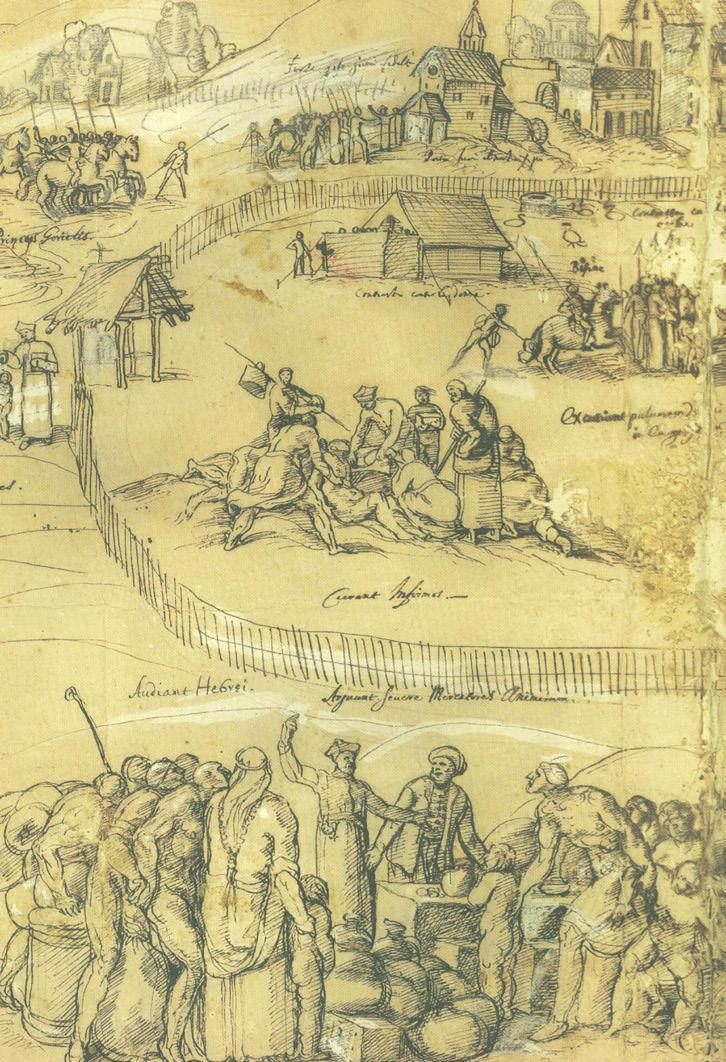
manana niqabaZe

MANANA NIKABADZE
XVII saukuneSi, kaTolikuri misiiT Camosuli, TeatinelTa ordenis warmomadgeneli italieli beri don qristoforo de kasteli zRva masalas gvawvdis imdroindeli saqarTvelos Sesaxeb: `rionisa da mtkvris dablobebsa da maT mosazRvre mTebis kalTebze, Zvelad cxovrobda lamazi garegnobis keTilSobili xalxi, romelsac droTa ganmavlobaSi sxvadasxva saxeli miuRia. argonavtebis dros kolxeTis saxels atarebda... ufro gvian lazeTs eZaxdnen... aRmosavleTSi maT icnoben gurjis saxelwodebiT... georgia da georgielebi bizantielebisgan daerqva, evropaSic ase uwodeben. TviT ki Tavs qarTlosianebs, qarTvelebs, iberebs, iverielebs uwodeben~.
kasteli gviambobs, rom am periodis saqarTvelo Tan osmalo da sparsi dampyroblebis winaaRmdeg gamudmebul brZolebs awarmoebda da Tan eklesiebs aSenebda, zarafxanaSi oqros fuls Wrida, vaWrobda qveynis dasavleTiT da aRmosavleTiT da evropidan Camohyavda sxvadasxva profesiis ostatebi: oqromWedlebi, mesaaTeebi, durgal-mxatvrebi da mSeneblebi(!). kasteli wers, rom Tavadaznaurobac ar Takilobda saglexo samuSaos da yvelaferma aman politikuri da ekonomikuri avtoriteti moupova saqarTvelos samTavroebs, xolo ucxo qveynebis TvalSi isini saintereso da sasurveli partniorebi gaxada, rogorc diplomatiuri ise savaWro urTierTobebisTviso.
kasteli aRwers da gvixatavs(!) rogorc misionerebis moRvaweobas saqarTveloSi, ise qarTveli mosaxleobis sxvadasxva fenis cxovrebas.
gansakuTrebuli damokidebuleba aqvs qristoforo de kastelis saqarTvelos mTavrebTan, kerZod samegrelos mTavar levan II dadianTan, romelic Tavisi drois didebuli mmarTveli da marTlmadidebluri eklesiis gamoCenili qtitori gaxldaT. gamoirCeoda Tavisi keTilganwyobiT evropeli kaTolike misionerebis mimarT. kastelim yvelaze xangrZlivi dro swored samegreloSi, odiSSi, levan II-is karze gaatara da mas xan keTilgonier da samarTlian mmarTvelad moixseniebs, xan ki borot da TavkerZa diqtatorad. evropeli misioneri Tavad xdeba TviTmxilveli im SeTqmulebisa, romelsac levan dadianis winaaRmdeg awyobdnen simon gurieli, imereTis mefe
Italian Theatine monk Cristoforo Castelli, who visited Georgia in the 17th century on a catholic mission, provides us with numerous pieces of information about the Georgia of the time: “In the Rioni and Mtkvari lowlands and on the slopes of their neighboring mountains, used to live a kindhearted people of beautiful appearance, which has borne many denominations throughout history. During the time of the Argonauts, this place was called Colchis… Later Lazica… In the Orient, they know them as the “Gurdj”… The name Georgia and Georgians are of Byzantine origin, and this is how Europeans call them too. They themselves call themselves Kartlosians, Kartvelians, Iberians, and Iverians.”
Castelli tells us that the Georgia of the time was in constant battles against Ottoman and Persian invaders, but nonetheless managed to build churches, mint gold coins, was trading in the East and the West, and bringing masters of various professions from Europe: goldsmiths, watch makers, carpenters and builders (!). Castelli writes that the aristocrats themselves didn’t shun peasants’ work, and that all this led Georgian principalities to political and economic authority, making them interesting and desirable partners in the eyes of foreign nations, both in terms of diplomacy and commerce.



giorgi da afxazeTis mTavari seteman SaraSia, romlis qaliSvili darindia levan II-s meuRle iyo. SeTqmuleba gamomJRavnda... dadians Seatyobines, rom misi piradi veziri, Wkua-gonebiT da garegnobiT cnobili papuna wulukia SeTqmulTa Soris iyo... dadianma Tavis meuRles papuna wulukiasTan Ralati daabrala, sastikad dasaja _ cxviri da yuri moaWra da ase gaugzavna mamamiss, afxazeTis mTavars seteman SaraSias misi umSvenieresi asuli; papuna wulukia `STadva zarbazansa Sina da gantyorcna”; imereTis mefis Zma, simamaciT cnobili mamuka batoniSvili, Seipyro, Tvalebi daTxara da dilegSi amohxada suli. ase dasaja levan II dadianma SeTqmulebis monawileni, Tumca kastelis azriT, darindias mimarT, dadianis eWvebi usafuZvlo iyo da man didi codva Caidina, roca cili daswama Tavis meuRles da igi politikur mtrebTan brZolas Seswira.
Tuki dadianis karis intrigebSi ufro Rrmad CavixedavT, vnaxavT, rom erT-erTi mizezi darindias moSorebisa isic iyo, rom Tavad levan dadiani, sakuTari biZis, lipartianis colze, nestan-darejan WilaZeze iyo Seyvarebuli, romelic male mostaca mas da iqorwina kidec meored. amrigad, levan II dadianma Tavisi gulis wadilic aisrula, politikuri mtrebic moiSora da yovel maTgans saTiTaod gausworda.
Castelli describes and draws (!) both the activities of missionaries in Georgia and the lives of various layers of the Georgian society. Castelli has a particular relationship with Georgian princes, and especially with Megrelian prince Levan II Dadiani, who was a great leader of his time and a distinguished donor for the building of orthodox churches. He stood out with his kind approach towards the European catholic missionaries. Castelli spent most of his time in Georgia precisely in Samegrelo, in Odishi, in the court of Levan II, and refers to him sometimes as a benevolent and righteous leader, sometimes as a mean and selfish dictator. The European missionary becomes a witness of the conspiracy against Levan Dadiani fomented by Simon Gurieli, George, King of Imereti, and Prince of Abkhazia Seteman Sharashia, whose daughter Darindia was Levan II’s spouse. The conspiracy was discovered… They informed Dadiani that his personal vizier Papuna Tsulukia, famous for both his wits and appearance, was among the conspirers… Dadiani accused his wife of cheating with Papuna Tsulukia, and punished her severely – he cut off her nose and ears, and sent his beautiful daughter back to
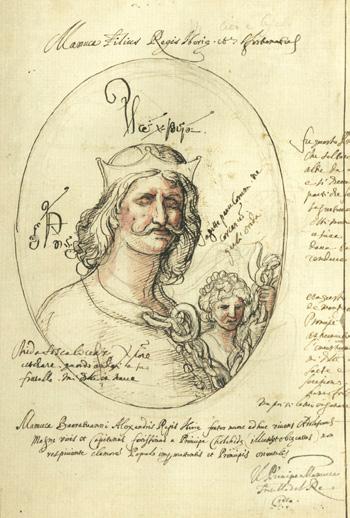


Tumca, axal meuRlesTan levan dadians ar gaumarTla _ `moswyda Tesli misi~. ori Svilidan, romelic meore qorwinebaSi eyola, erTi, dambladacemuli aleqsandre adre waiyvana ufalma, xolo meore, manuCari, silamaziT da simamaciT qebuli umcrosi vaJi, romelic dadians Tavis memkvidred miaCnda, moulodnelad, gaurkveveli mizeziT gardaicvala da sasowarkveTilma mamam mis saflavze moikla Tavi.
levan II-s Semdeg odiSis taxtze, swored is biZa avida, romelsac dadianma coli wahgvara... garda am sastiki da sevdiani ambebisa, kasteli mogviTxrobs sazogadoebis sxvadasxva fenis cxovrebis Sesaxebac. gvixatavs misionerTa Rvawls da maT urTierTobas adgilobriv mosaxleobasTan. TiTqmis yvela misi naxati naturidanaa Sesrulebuli: Teatinel berTa sacxovrebel adgil-samyofels, yvelgan, rogorc wesi, Robe aqvs Semovlebuli. ezos SigniT ara erTi nagebobaa: eklesia; sacxovrebeli orsarTuliani aivniani saxli; avadmyofTa da RaribTa TavSesafari; mosasvenebeli adgili stumrebisa da bavSvebisaTvis; sasiminde; bostani; xexili da Sinauri cxovelebi. xSirad xatavs kasteli samxedro wvrTnas, nadirobas, jiriTs, sameurneo scenebs,
her father Seteman Sharashia, prince of Abkhazia, in this condition. As for Papuna Tsulukia, he “STadva zarbazansa Sina da gantyorcna”; he captured the famously brave Mamuka Batonishvili, who was the brother of the King of Imereti, took out his eyes and let him die in a dungeon. This is how Levan II Dadiani punished the conspirers, although according to Castelli, his suspicion against Darindia were unfounded, and he committed a great sin by defaming his wife and sacrificing her in a battle against his political foes.
If we look deeper into the intrigues going on in Dadiani’s court, we will see that one of the reasons why he got rid of Darindia was that Levan II Dadiani himself was in love with Nestan-Darejan Tchiladze, the wife of his uncle Lipartiani, whom he took from him and married. Therefore, Levan II Dadiani realized his secret wish, got rid of his political rivals, and got revenge from each one of them.
But Levan Dadiani wasn’t lucky with his new wife – “მოსწყდა
”. From the two children he had from his second marriage, one was paralytic and passed early, while the second, Manuchar, admired for his looks and bravery, and whom Dadiani deemed to be his successor, he died suddenly from an unknown cause, and his desperate father killed himself on his grave.
After Levan II, it is precisely the uncle whose wife he took who



yurZnis krefas, dawurvas, detalurad agviwers gaSlil sufras, musikalur sakravebs, simReras, cekvas da lxins. rac Seexeba XVII saukunis kulturas da xelovnebas, kastelis arc es sfero dautovebia uyuradRebod, xolo mis mier Sesrulebuli portretebi, es calke kvlevis Temaa...
mxatvari qalis, rodia miqelaZis portretze kastelis aseTi minaweri aqvs _ ukeTilSobilesi qarTveli qali, mamuka biskaias meuRle rodia miqelaZe niWieri, umaRlesi saTnoebisa da patiosani yofaqceviT Semkuli mxatvari qali. umaRles mTebSi mcxovrebi, romelsac kavkasia hqvia... (aqve unda aRiniSnos, rom XVII saukunis mxatvari qali, mxolod italieli artemizia jentileski viciT). rodia miqelaZis namuSevrebi rom SemogvrCenoda, misi saxelic daamSvenebda msoflio xelovnebis galereas... kastelis rodias meuRlis, odiSis jaris sardlis vaJis mamuka biskaias ramdenime portreti aqvs Sesrulebuli (sainteresoa, rom gvari biskaia dResdReobiT samegreloSi aRar gvxvdeba, samagierod bevrni arian isini espaneTSi, rac dasavleTis da aRmosavleTis iberielTa naTesauri kavSiris albaTobaze migvaniSnebs...).
poeti qali vominija beriZis portreti warweriT
became the ruler of Adishi...
Apart from these harsh and sad stories, Castelli recounts the everyday lives of various layers of the society of the time. He draws the works of the missionaries and their relations with the local population. Almost all of his works have been drawn from real models. The dwelling place of the Theatine monks is, according to the rule, surrounded by a fence. There are several buildings in the yard: the church; a two-story dwelling house with a balcony; a refuge for the sick and the poor; a leisure space for guests and children; a cornfield; a vegetable garden; fruit trees and domestic animals. Castelli often draws military trainings, hunting, horsemanship, agricultural scenes, grape harvest and pressing; he describes in detail the contents of a “supra” (ceremonial banquet), musical instruments, songs, dances, and celebrations in general.
Concerning the culture and art of the 17th century, Castelli didn’t leave them unattended either. As for his portraits, they deserve their own, separate article…
There is the following inscription on the portrait of female painter Rodia Mikeladze: “A most kind Georgian woman, Rodia Mikeladze, wife of Mamuka Biskaia, a female painter blessed with the highest
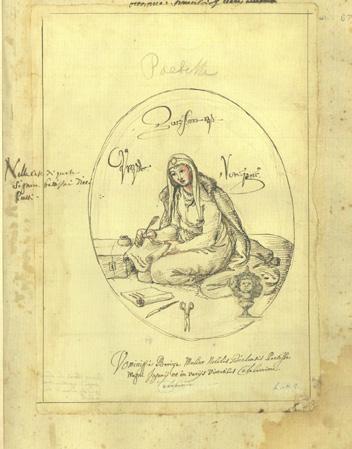


`keTilSobili guriis Tavadis meuRle, poeti vominija beriZe, didad niWieri da sxvadasxva saTnoebiT gamorCeuli~. kasteli wers, rom vominija misionerebs yovelTvis exmareboda, gansakuTrebiT Tu mniSvnelovani werilis gagzavna sWirdebodaT mefesTan an dedofalTan... samwuxarod, arc qarTveli poeti qalis vominija beriZis poezia SemogvrCa... kastelis erT-erTi gamorCeuli namuSevaria `iberiakolxeTis samefoSi ganTqmuli poeti, filosofosi sulxan avTandilaSvili sanaqebo qsovilis tansacmelSi~. dResdReobiT misi saxelic da naSromebic dakargulia CvenTvis, Tumca kastelis naxatma ar SeiZleba didi interesi ar gamoiwvios. rogorc Cans, XVII saukunis saqarTveloSi am portrets miiCnevdnen didi poetis gamosaxulebad. is iyo realuri pirovneba, romelsac Tavisi sibrZniT (filosofosobiT) samwerlo sarbielze hqonda saxeli moxveWili... rodia miqelaZis, vominija beriZis, sulxan avTandilaSvilis da sxvaTa moRvaweobas Cvenamde ar mouRwevia. mxolod qristoforo de kastelis damsaxurebiT vigebT maT Sesaxeb... saocari qalebi hyavs daxatuli kastelis. aRsaniSnavia, rom mTavrebi kaTolike berebs gamosacdelad, mosamsaxured mSvenier qalebs aZlevdnen. maT Soris iyvnen: Tanuria gimatia, romelic wlebis ganmavlobaSi, kastelis trfobis sagani iyo. `saxeze niSani damaCnia, raTa gulSi sxva Seyvarebuli aravin dameSva... TvalebSi mzes ajadoebda da bageze aprils~... umSvenieresi elene _ eluka beria, TeTrua qorTua, dedofali vardisfera, ana svani, bazieri qalebi da kidev mravali umSvenieresi saxe aqvs Caxatuli da aRwerili kastelis kalams.
virtues and honest actions. She lives in the high mountains that are called the Caucasus…” (it has to be mentioned that in the 17th century, there is only one other female painter that we know of, Italian Artemisia Gentileschi). If Rodia Mikeladze’s works had been preserved, her name would adorn the gallery of human art history…
Castelli has made several portraits of Rodia’s husband Mamuka Biskaia, who was the son of the commander of the Odishi army (interestingly, the name Biskaia cannot be found anymore in today’s Samegrelo, but many bear this name in Spain, pointing to the connection between the western and eastern Iberias…).

A portrait of female poet Vominija Beridze, with the inscription – “The kind poet Vominija Beridze, wife of the Prince of Guria, greatly talented and distinguished by many virtues”. Castelli writes that Vominija was always helping the missionaries, especially if they needed to send an important letter to the king or queen… Unfortunately, none of her poems have been preserved...
One of the most outstanding works by Castelli is “Renowned poet and philosopher Sulkhan Avtandilashvili from the IberoColchian kingdom, in a garment of magnificent tissue.” His name and works have been forgotten today, but Castelli’s drawing won’t fail to raise onlookers’ attention. It seems that in the 17th century Georgia, they considered this portrait as a representation of a great poet. He was a real person who had gained his reputation through his wisdom (his philosophy) in the field of letters…
The works of Rodia Mikeladze, Vominija Beridze, Sulkhan Avtandilashvili, and others, have unfortunately not reached us. We only know of them thanks to Cristoforo Castelli… Castelli has drawn wonderful women. It is worth noting that in order to test them, princes would send beautiful women as employees to the monks. Among them were:

samwuxaroa, rom don qristoforo de kastelis naxatebma, Cvenamde sruli saxiT ver moaRwia. italiaSi dabrunebuls, Tavis mSobliur qalaq palermosken gemiT mimavals `zRvaze Relvisas, wyalSi gadamivarda albomi, romelSiac yvelaze mSvenieri suraTebi mqonda daxatuli~, guldawyvetiT wers beri...
Tumca CvenTvis, yvelaze mniSvnelovani misi sityvebia _ mravali wlis ganmavlobaSi saqarTvelo Cemi satrfo iyo!
Tanuria Gimatia, who was a subject of love from Castelli for years. “saxeze niSani damaCnia, raTa gulSi sxva Seyvarebuli aravin dameSva... TvalebSi mzes ajadoebda da bageze aprils~...
Castelli’s pen has drawn and described the magnificent Elene –Eluka Beria, Tetrua Kortua, queen Vardispera, Ana Svani, falconer women and many other beautiful faces.
It is unfortunate that not all of Cristofor Castelli’s drawings have reached us. When he was back in Italy, on his way by boat to his native Palermo, “the sea got agitated, and in it fell an album containing the most beautiful drawings I had ever made”, the monk writes in desperation...
But to us, the most important are his following words – “For many years, Georgia has been the love of my life!”




